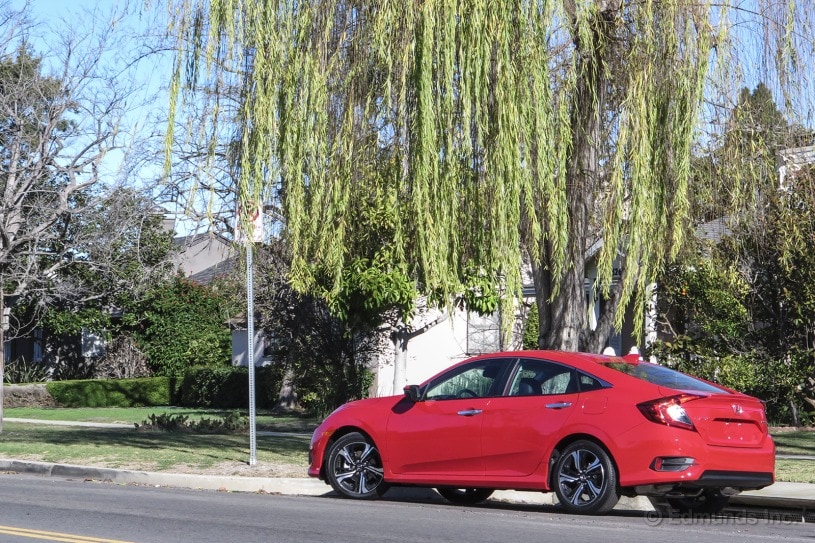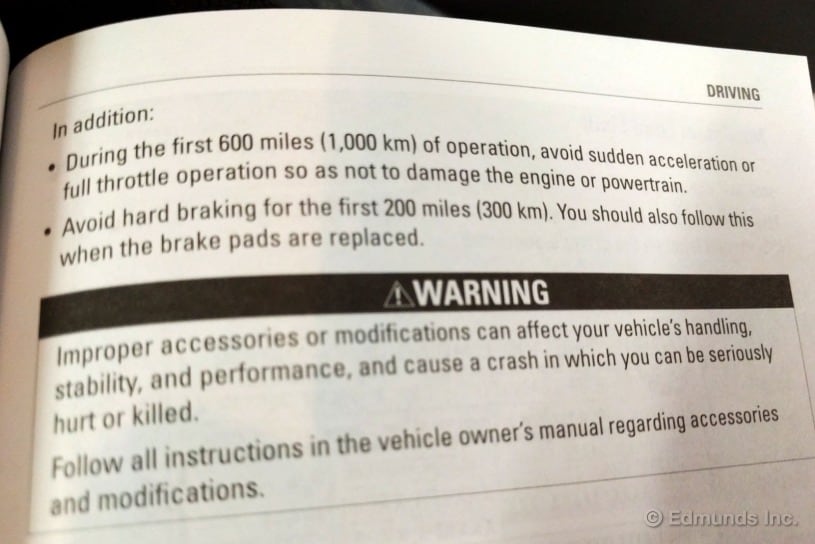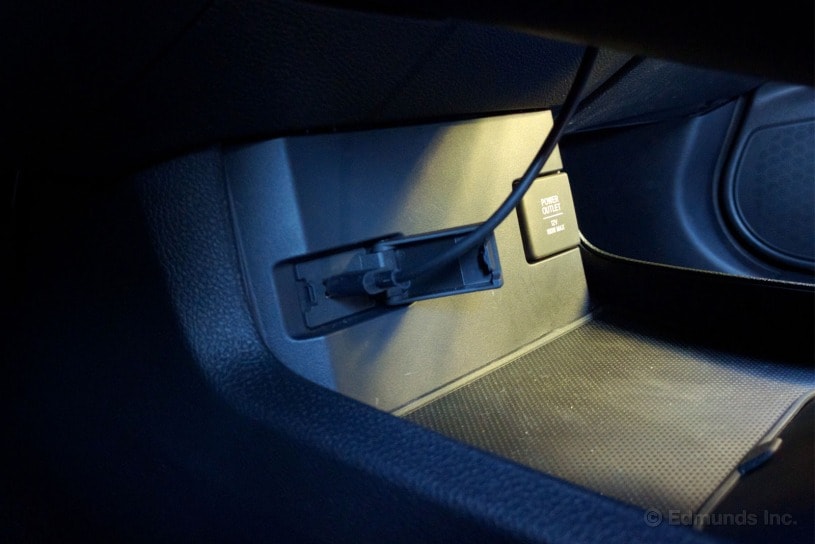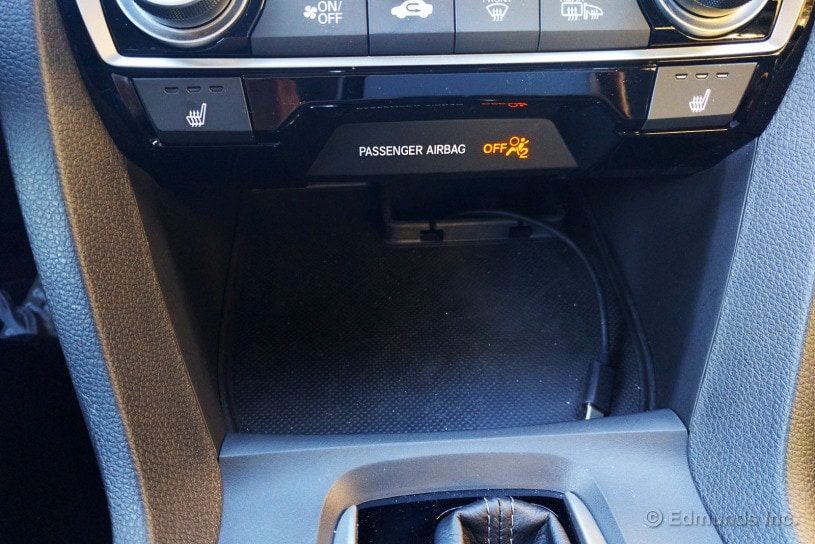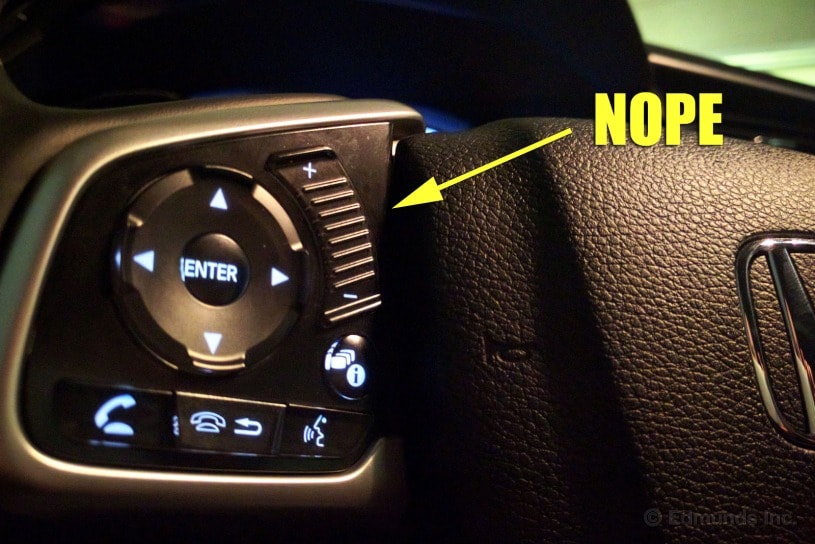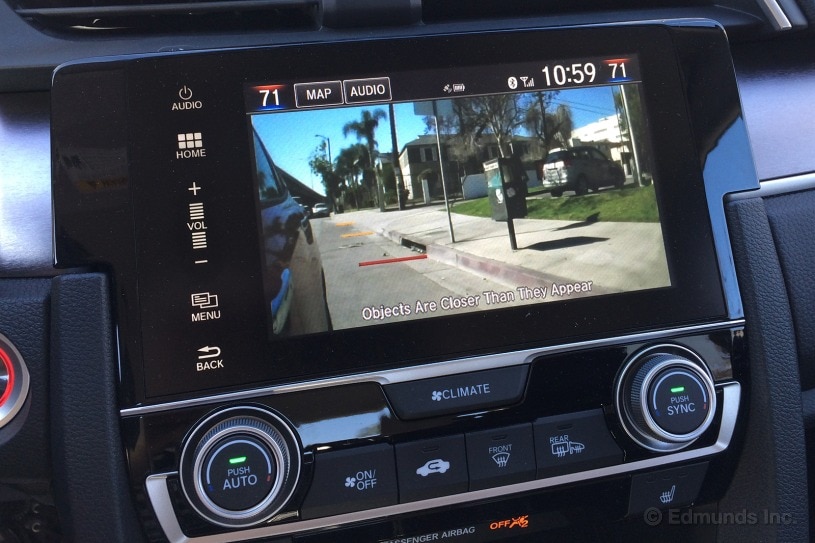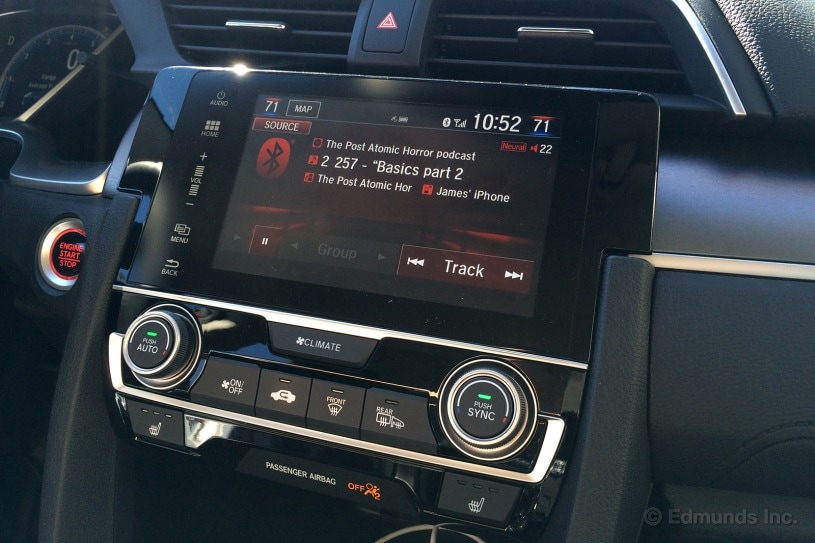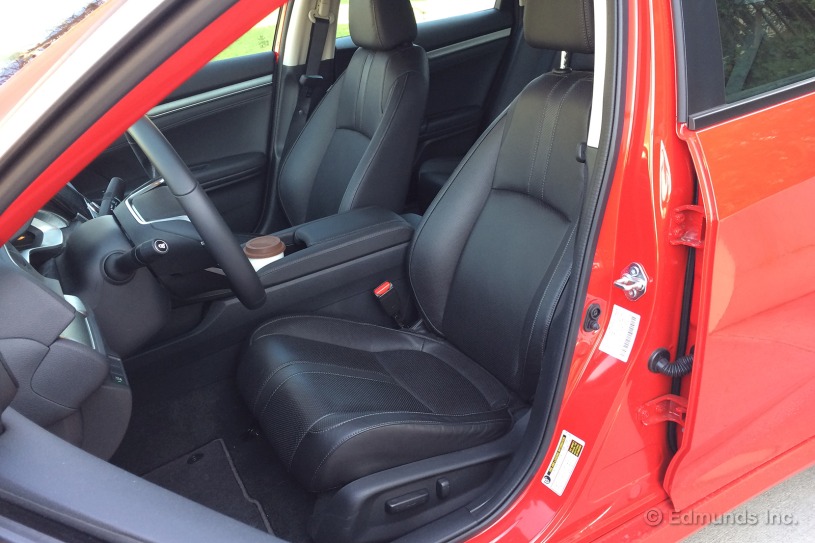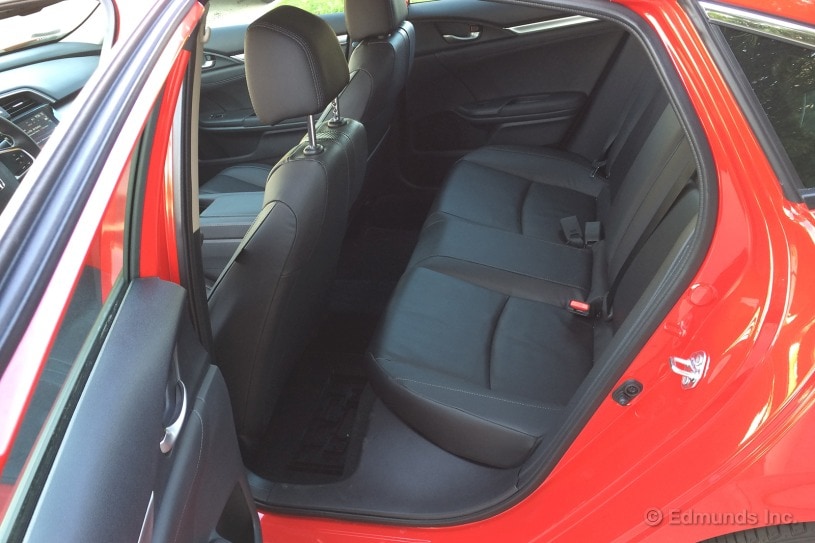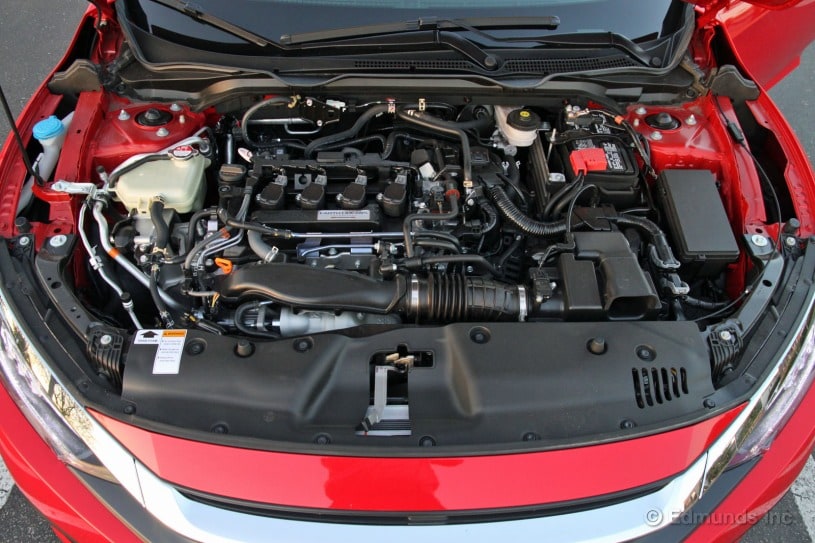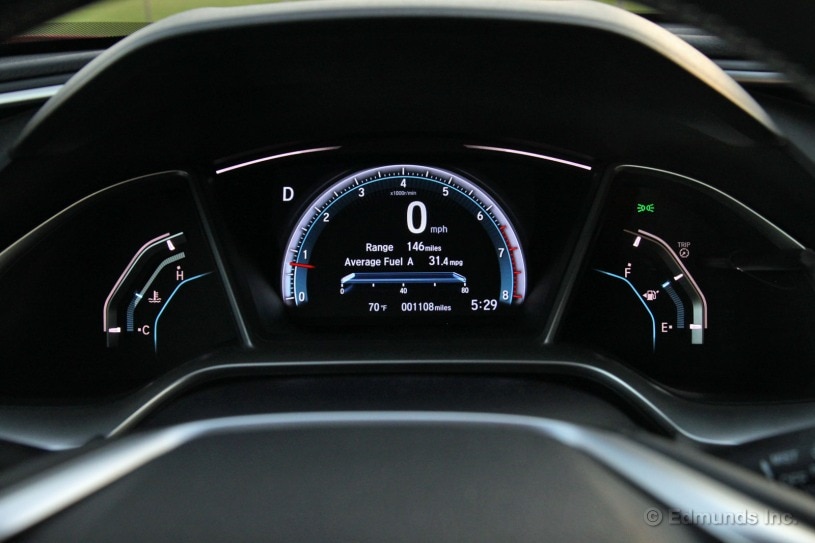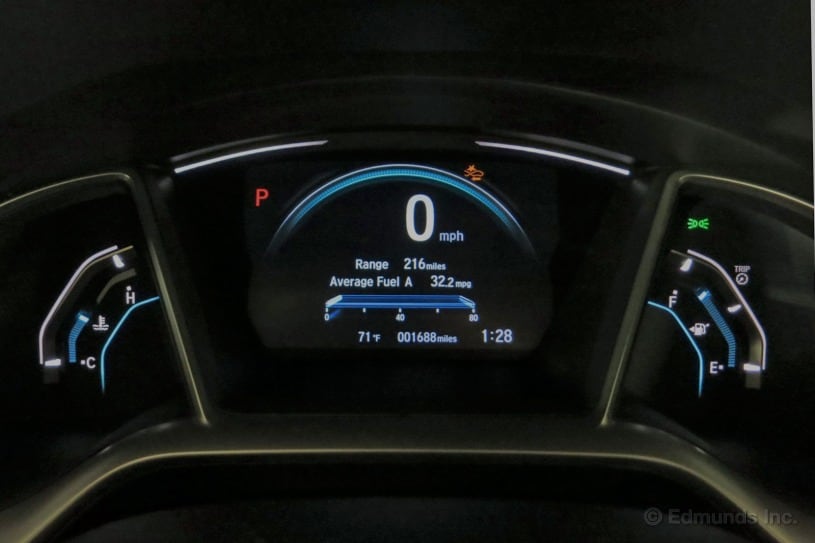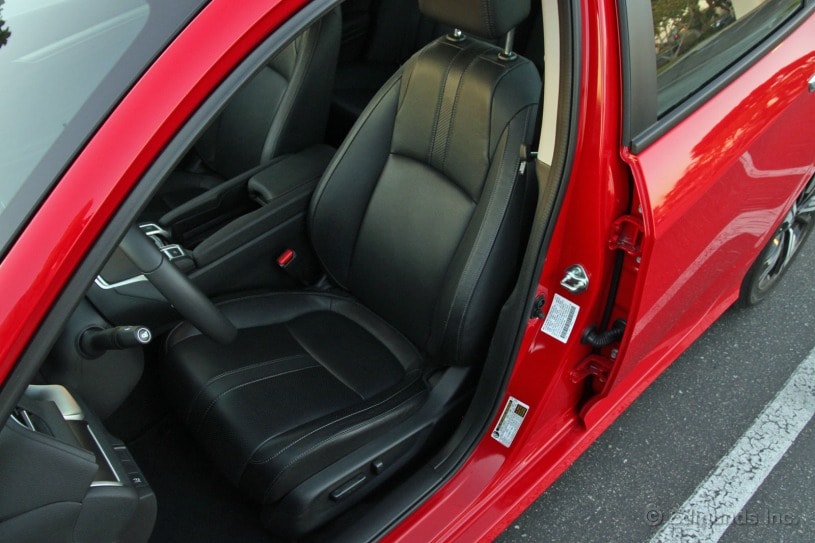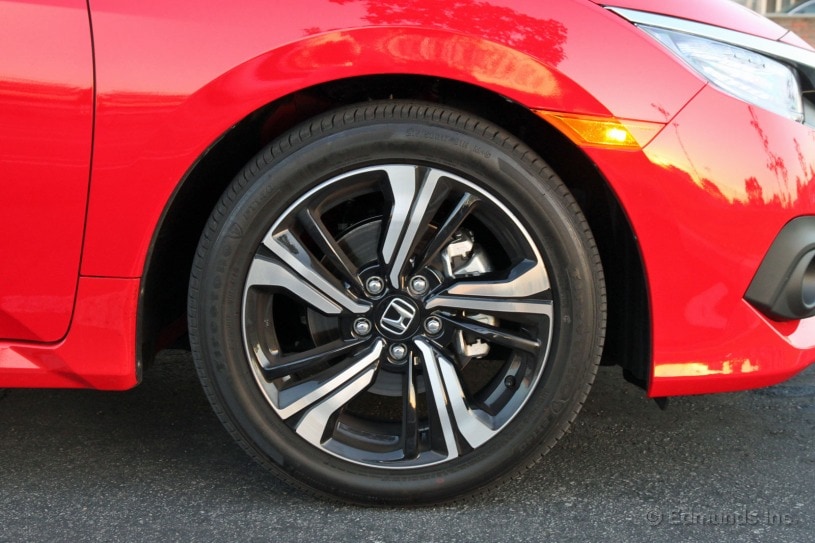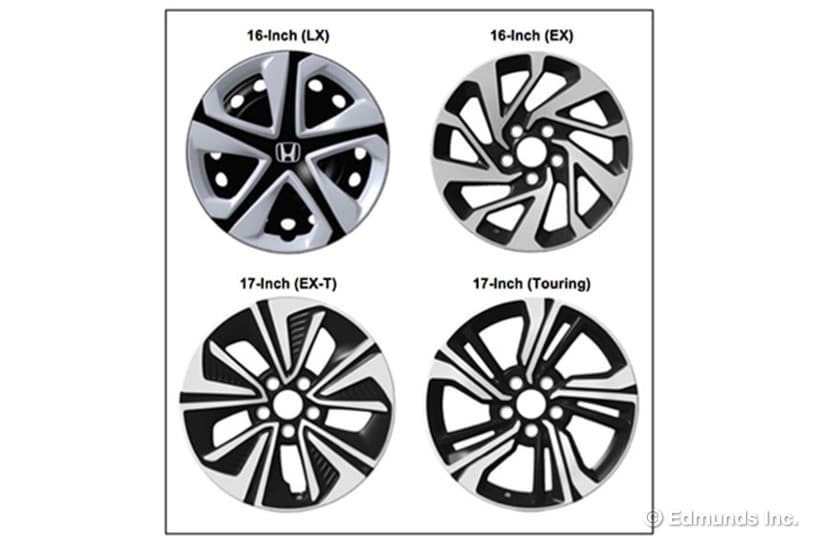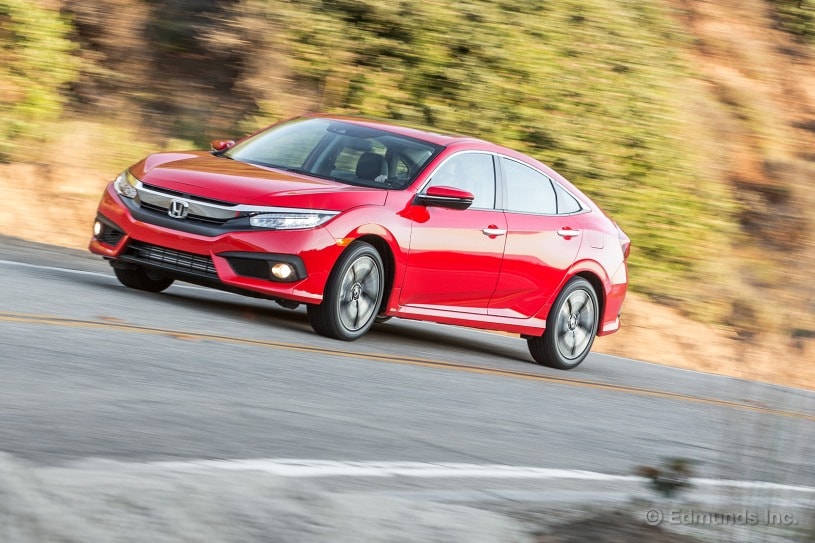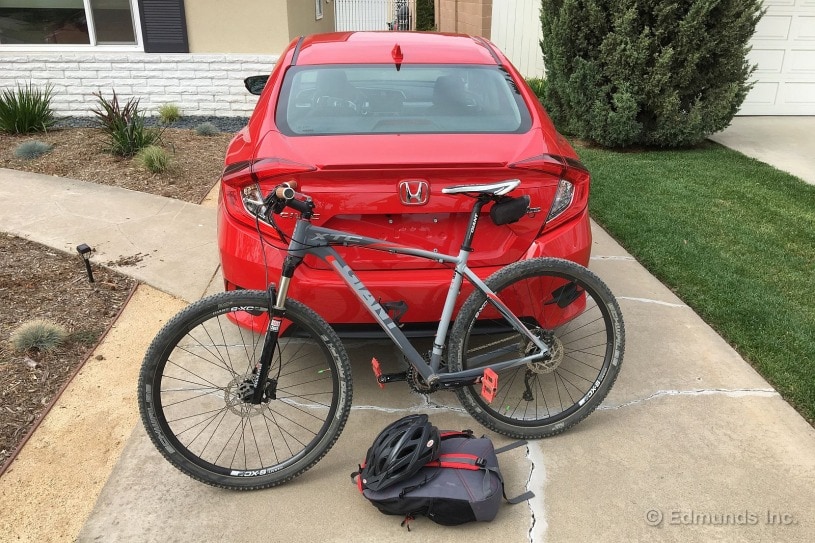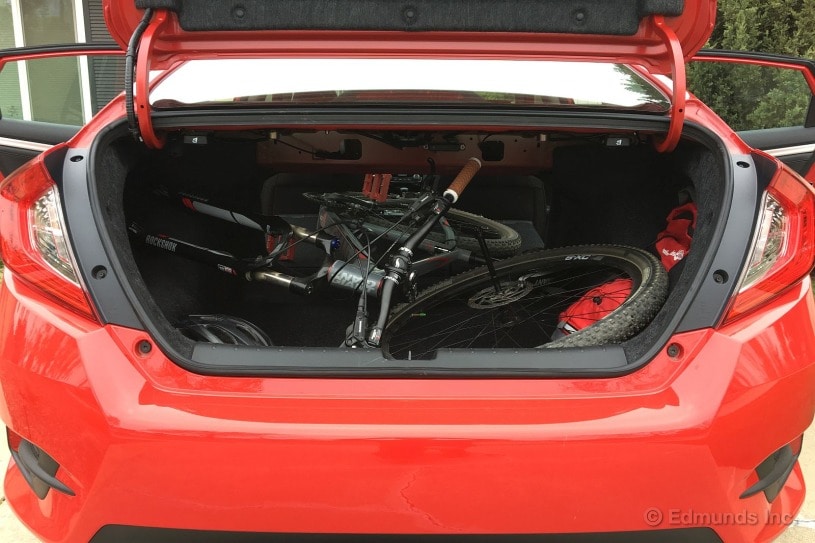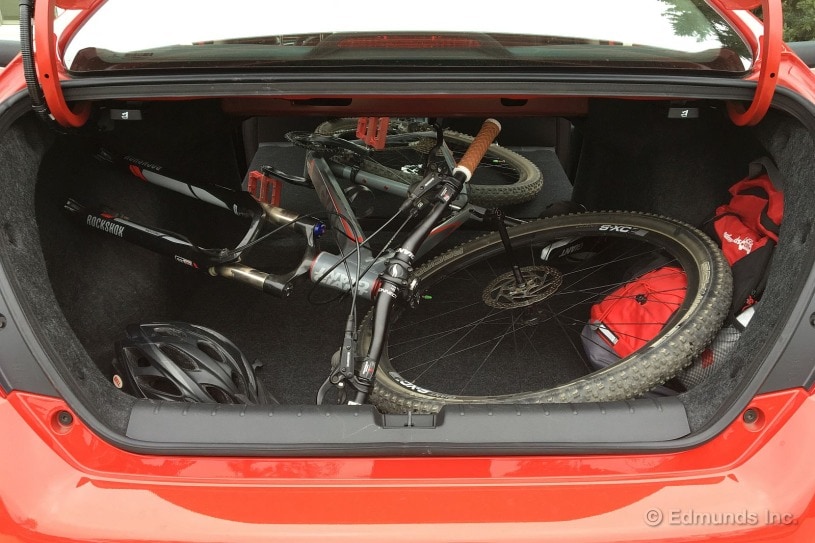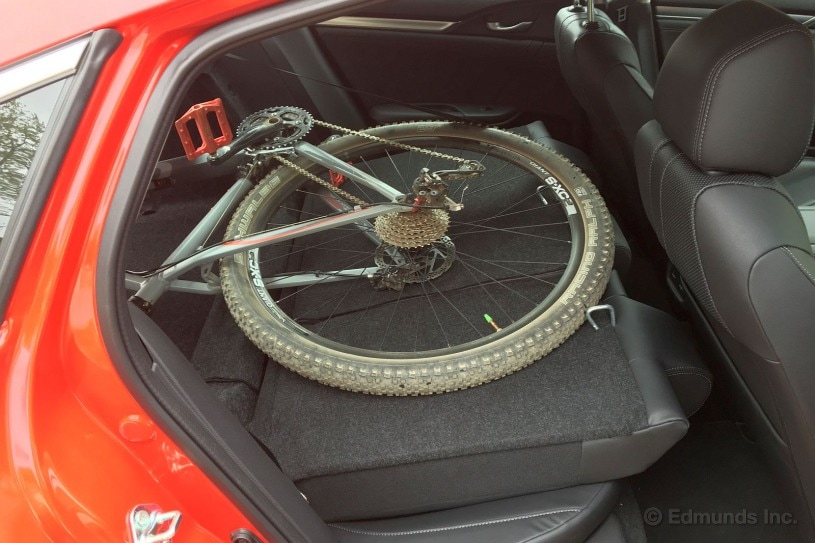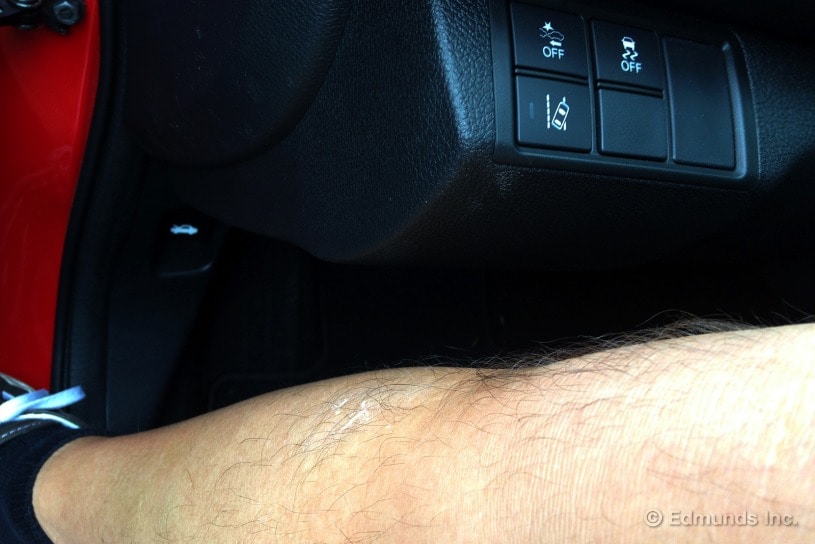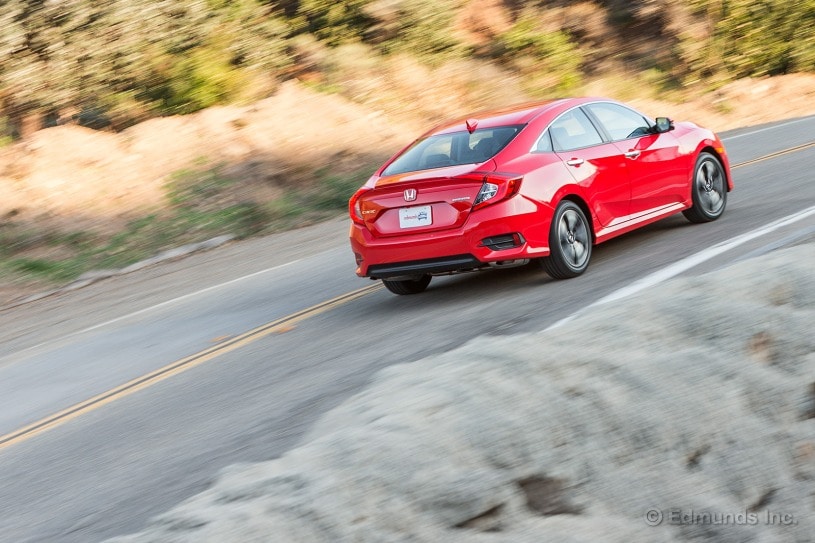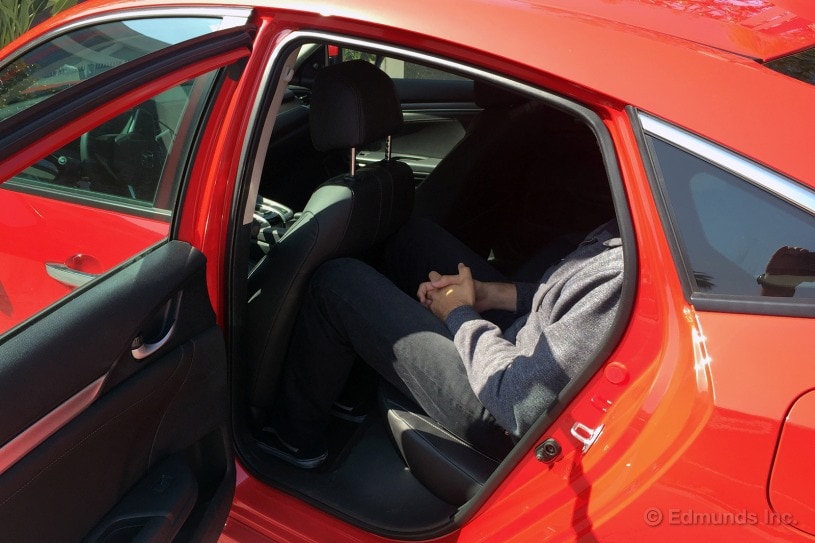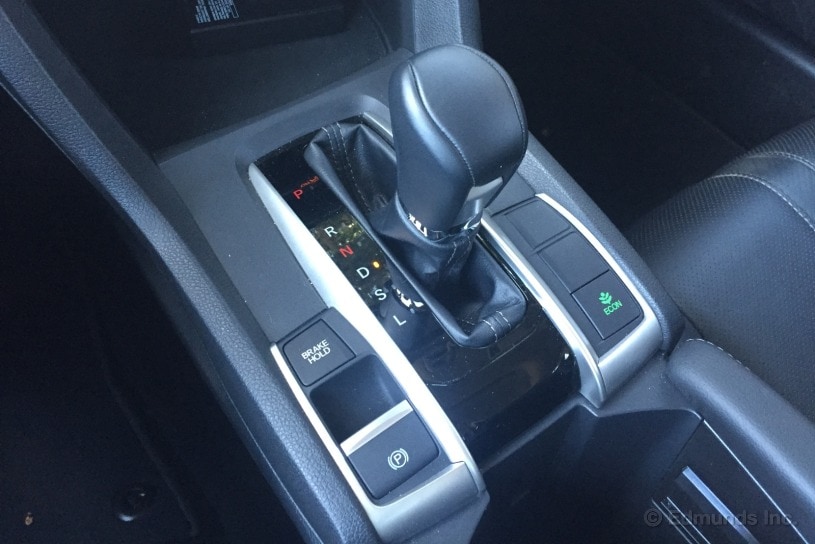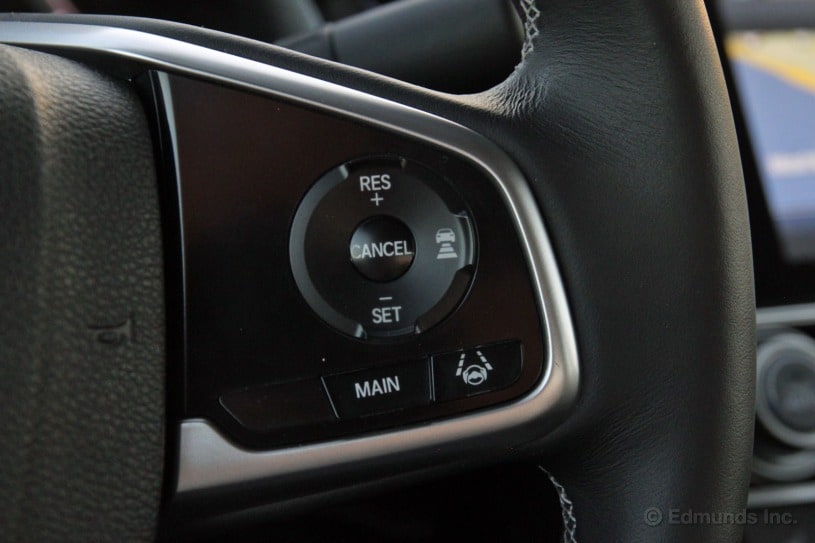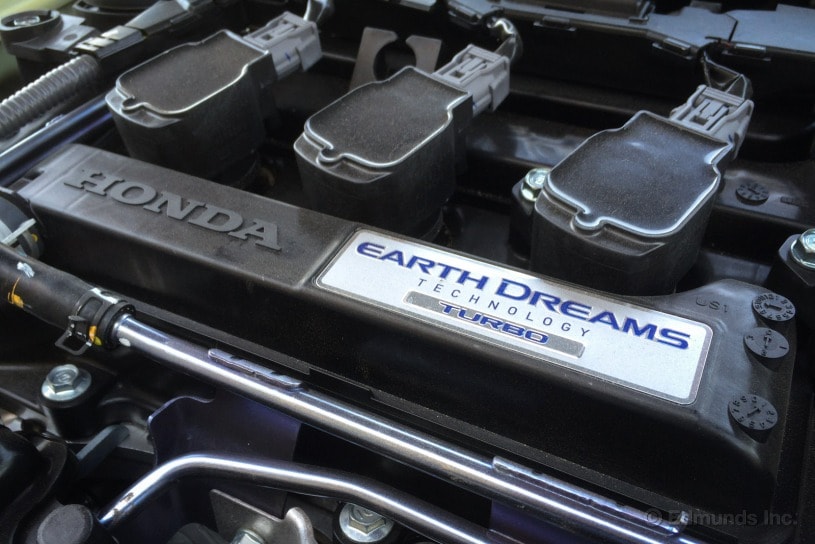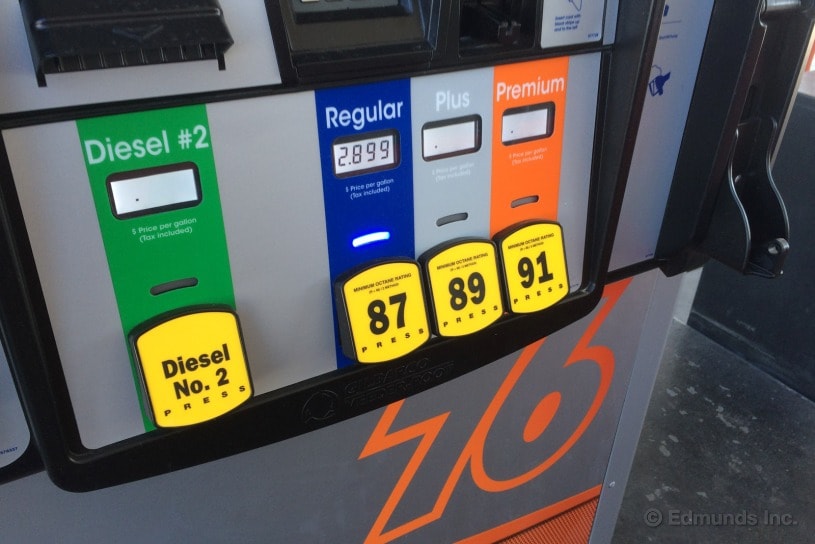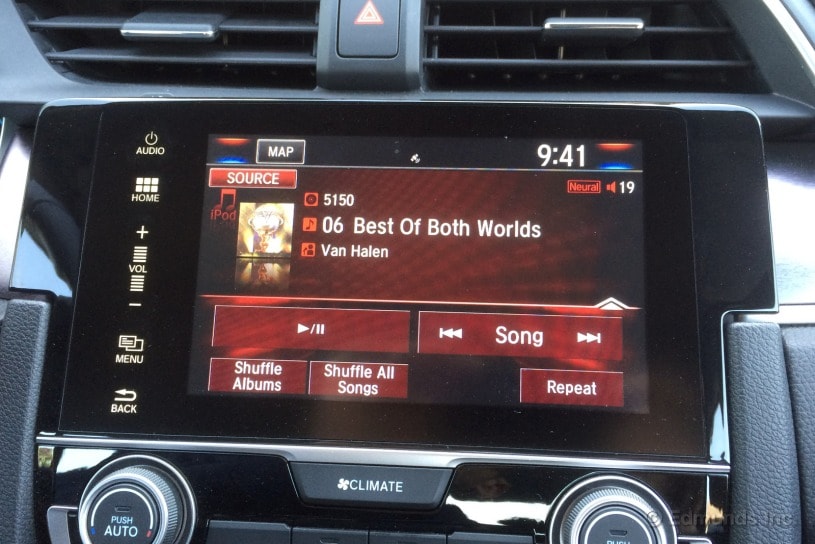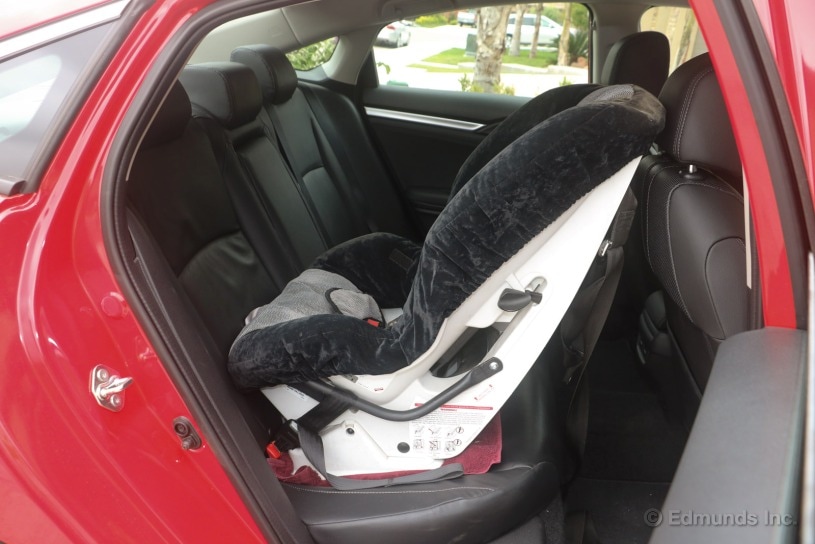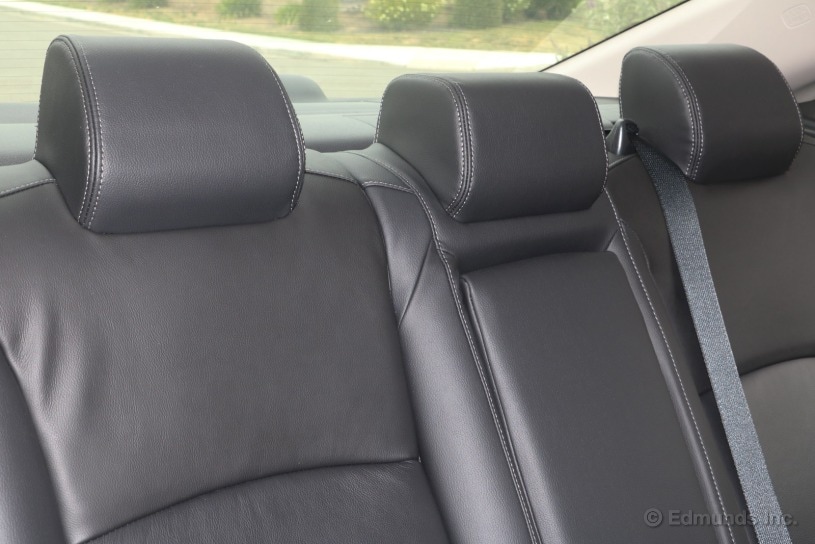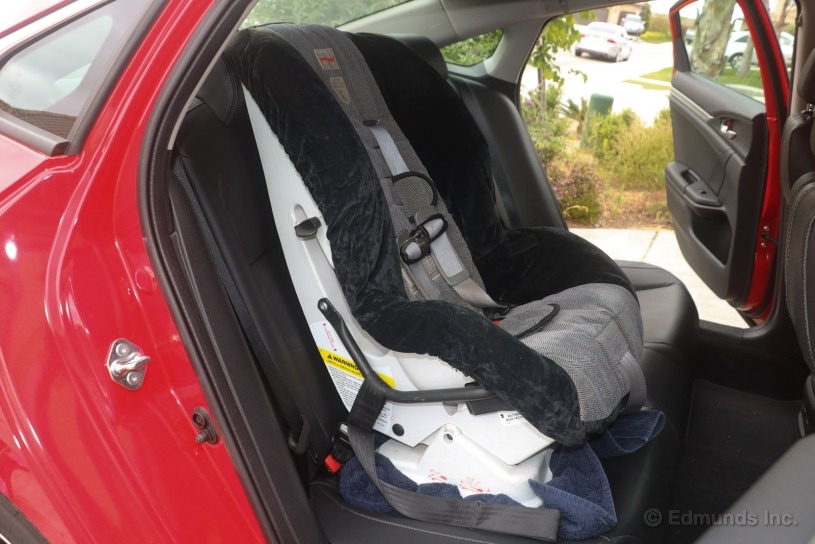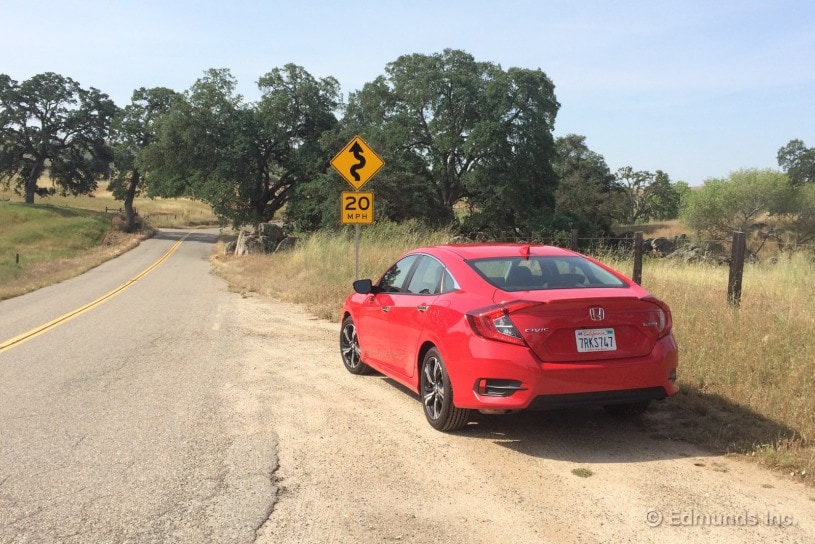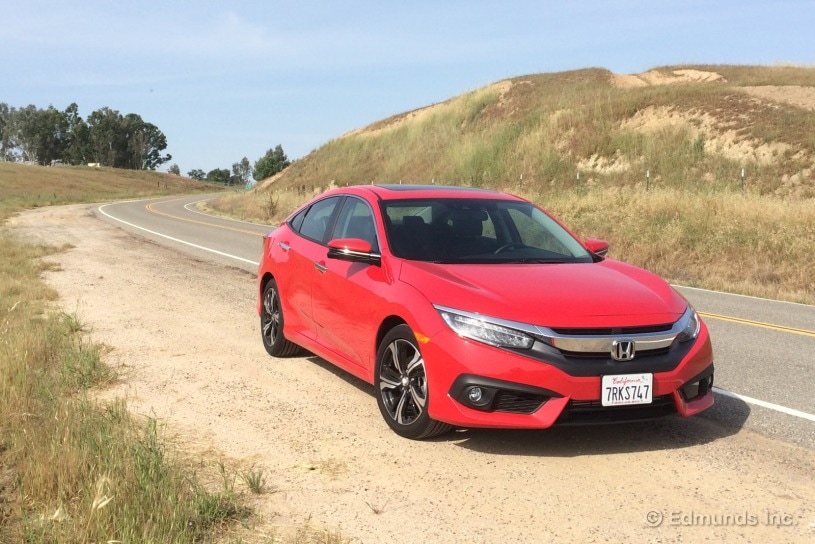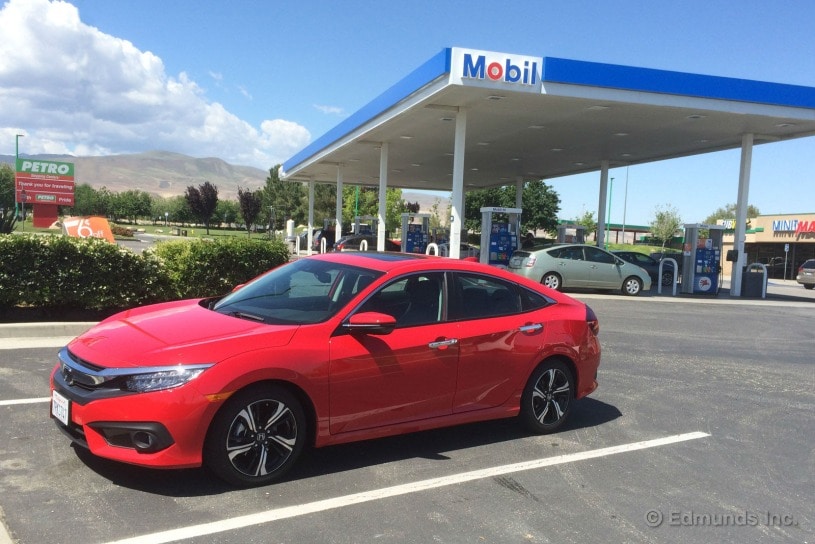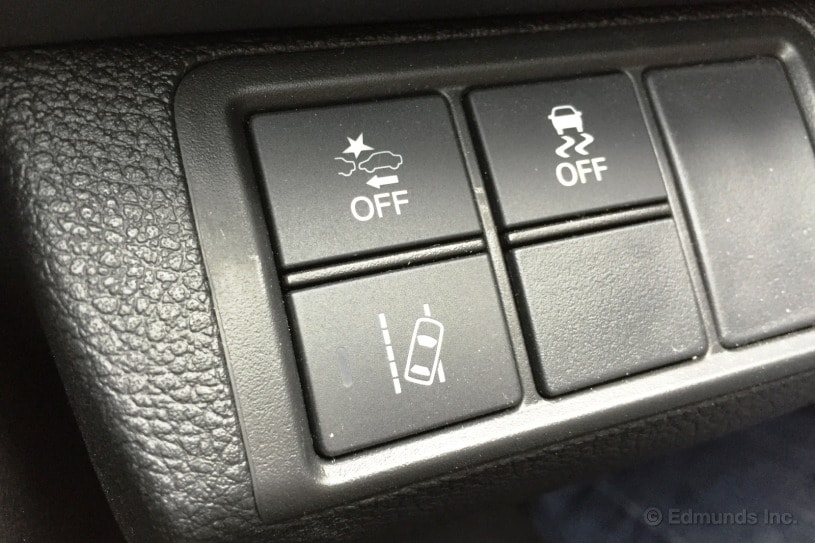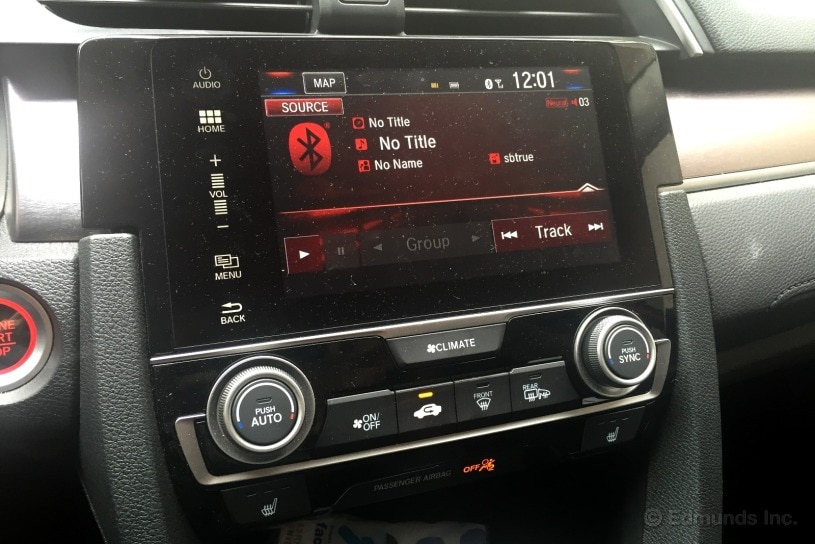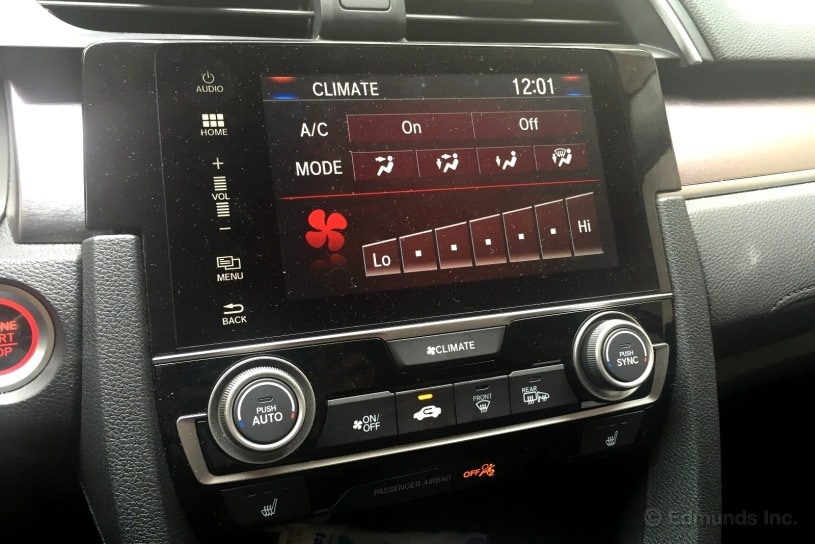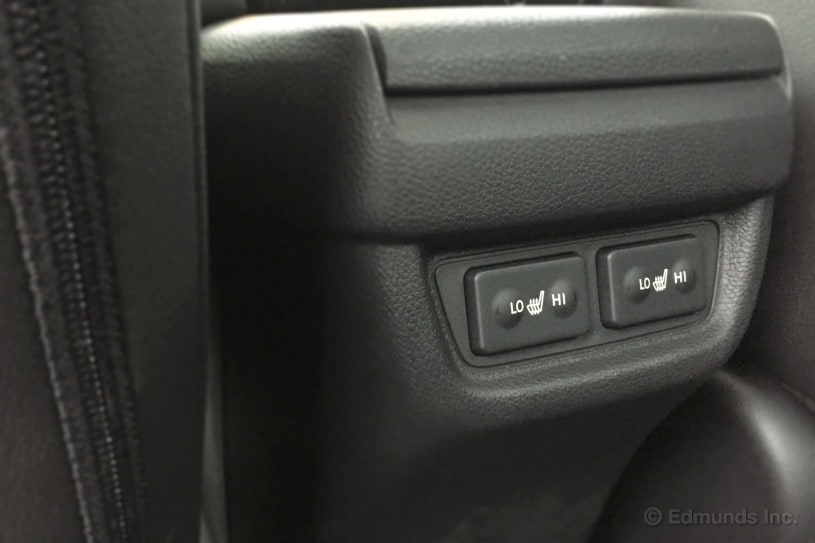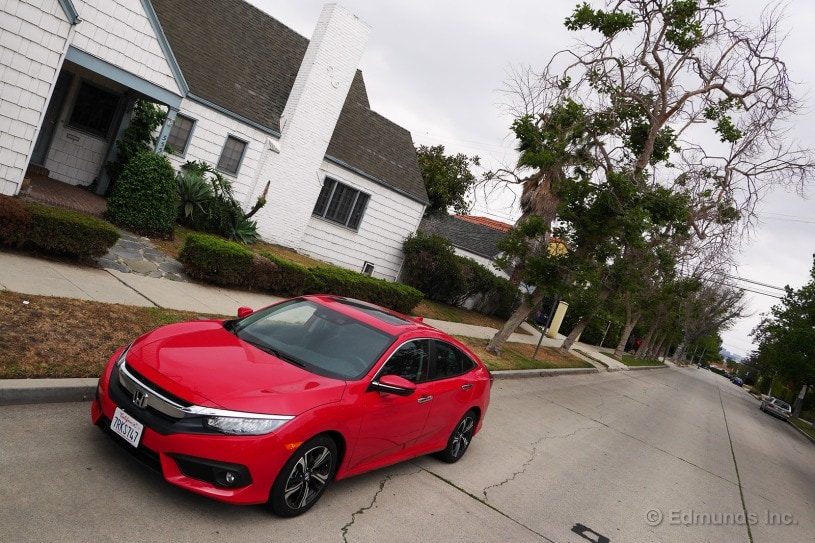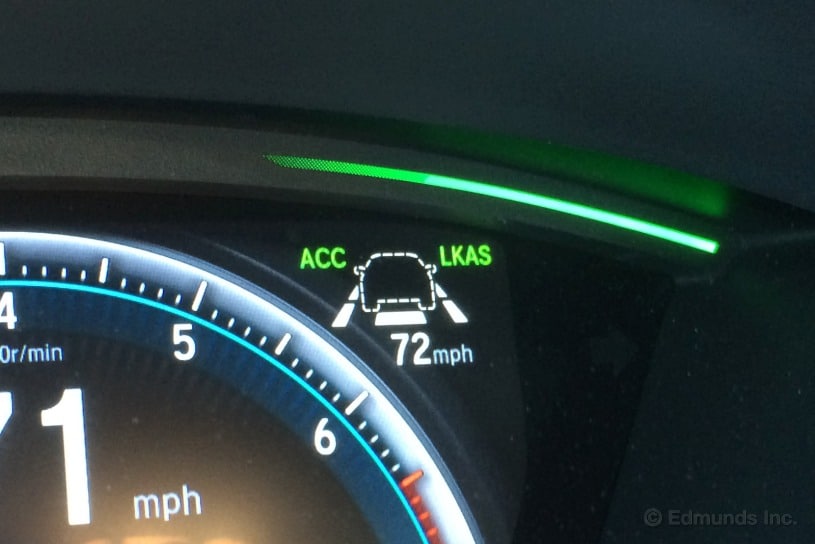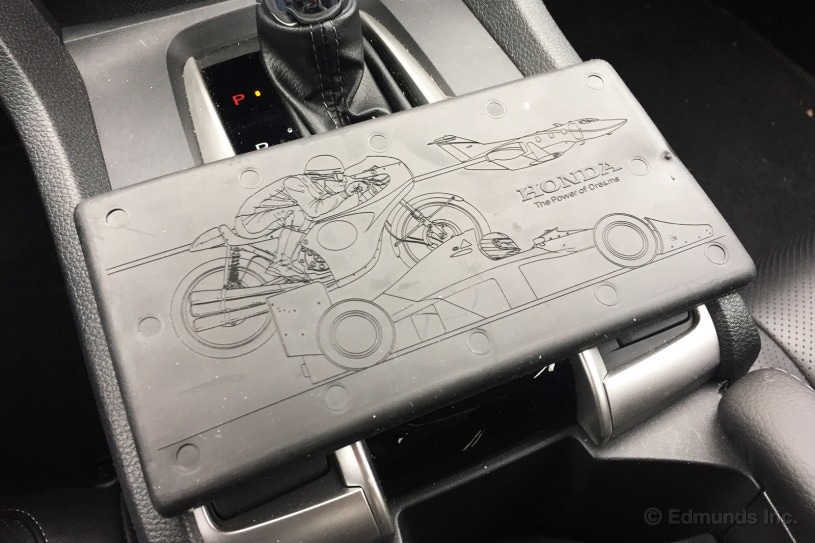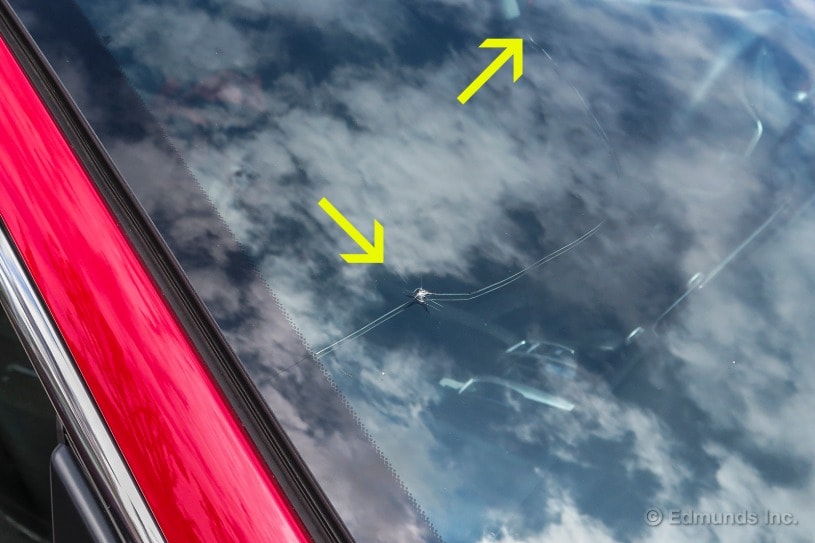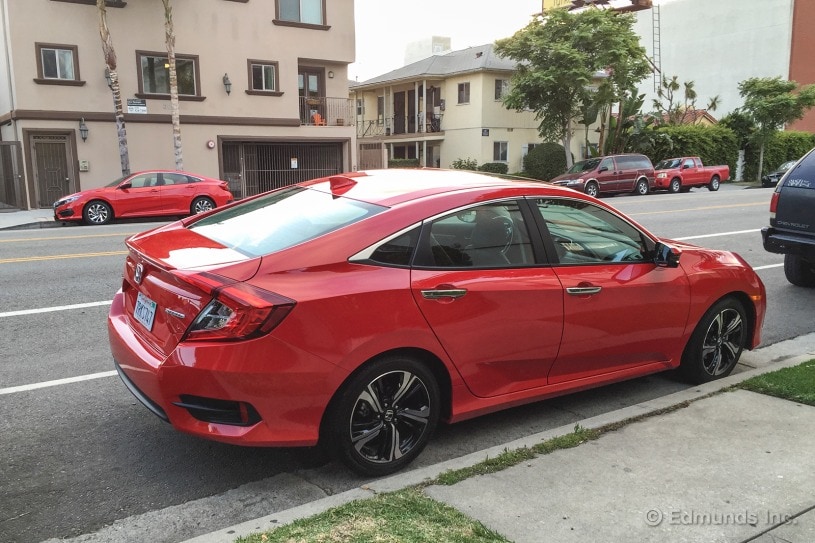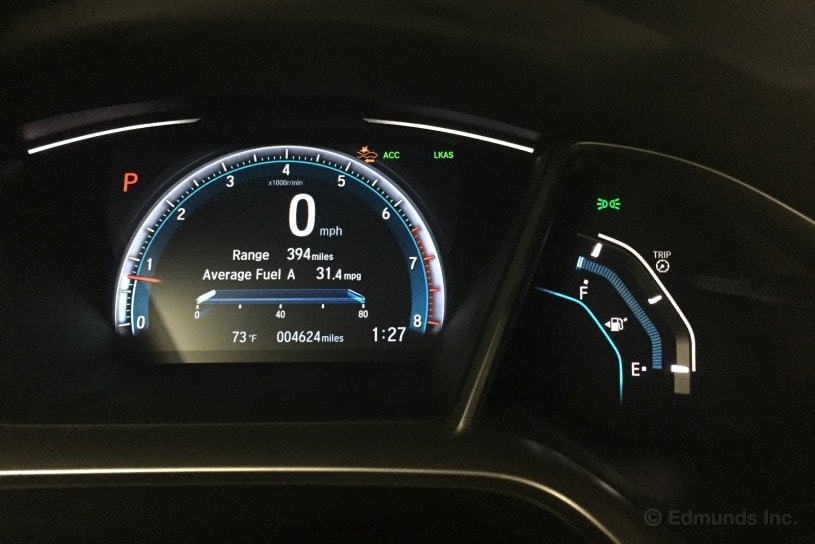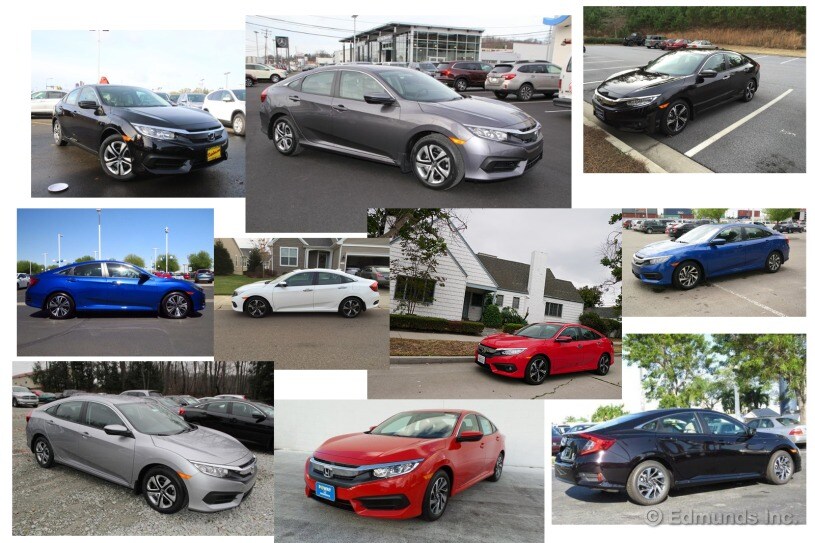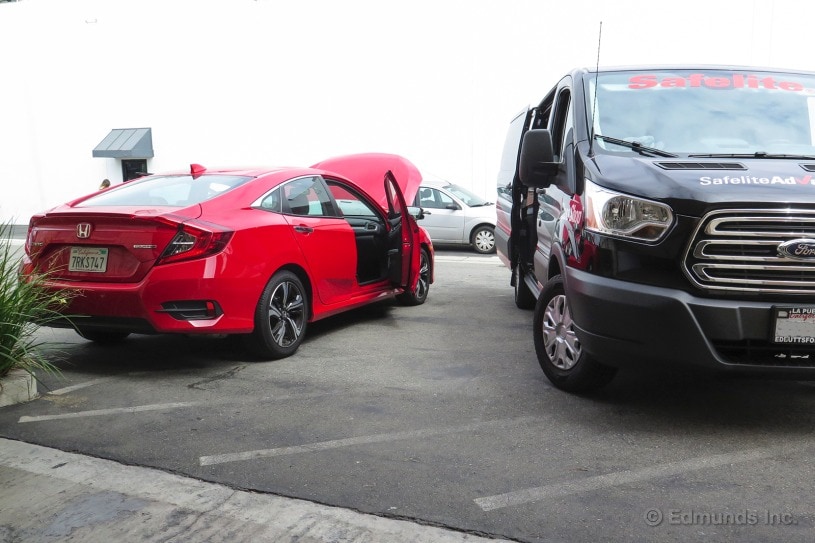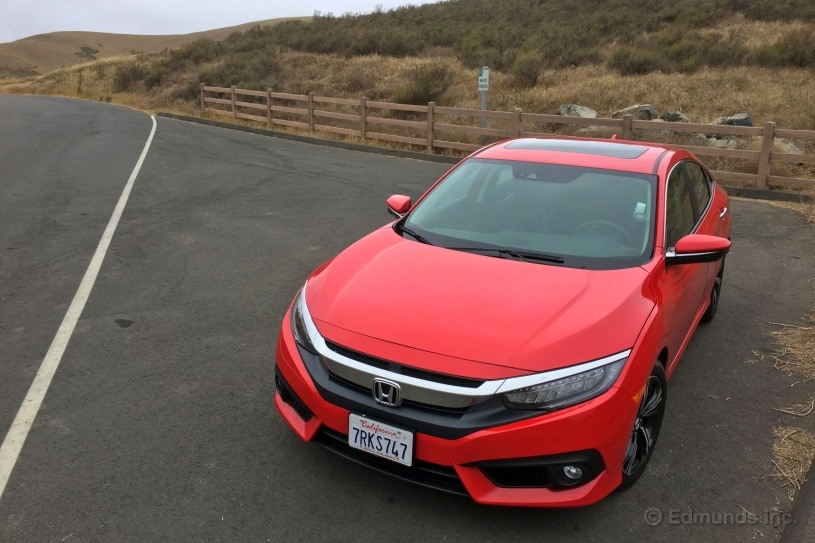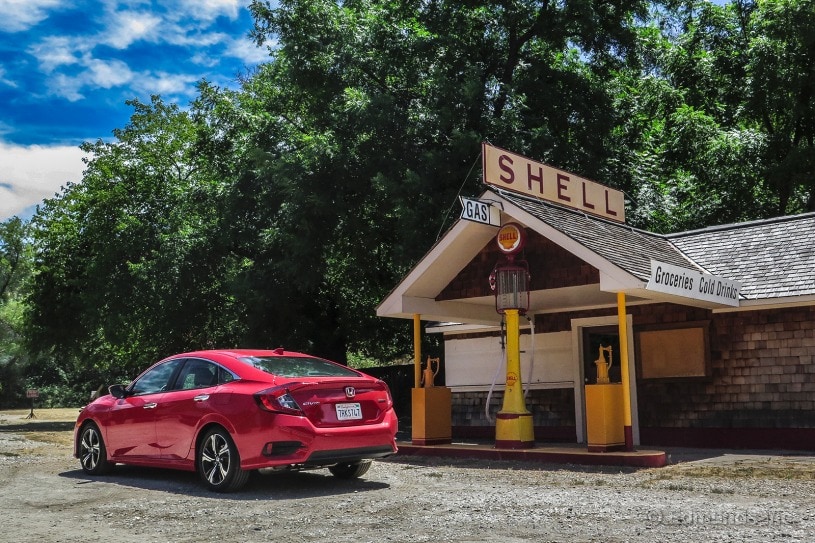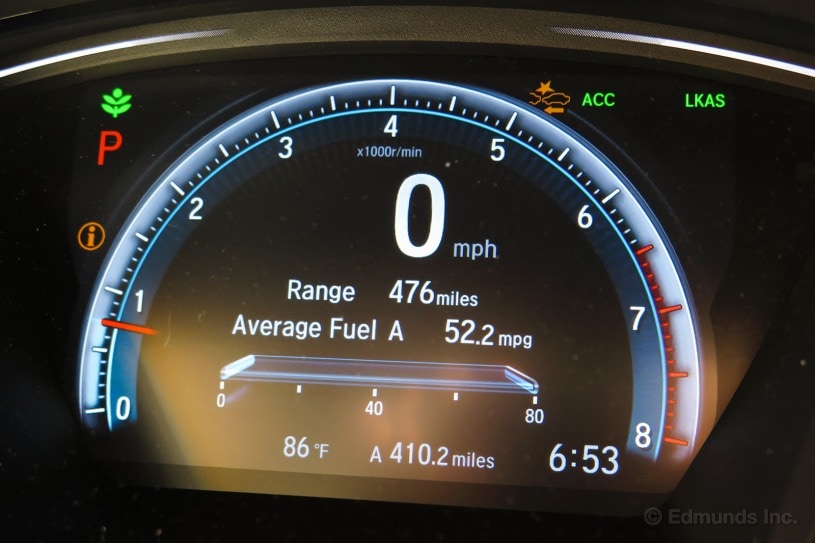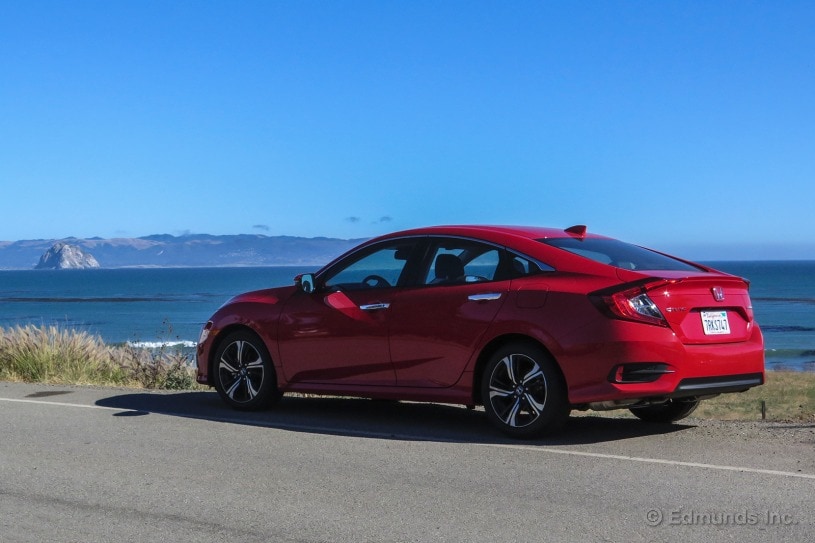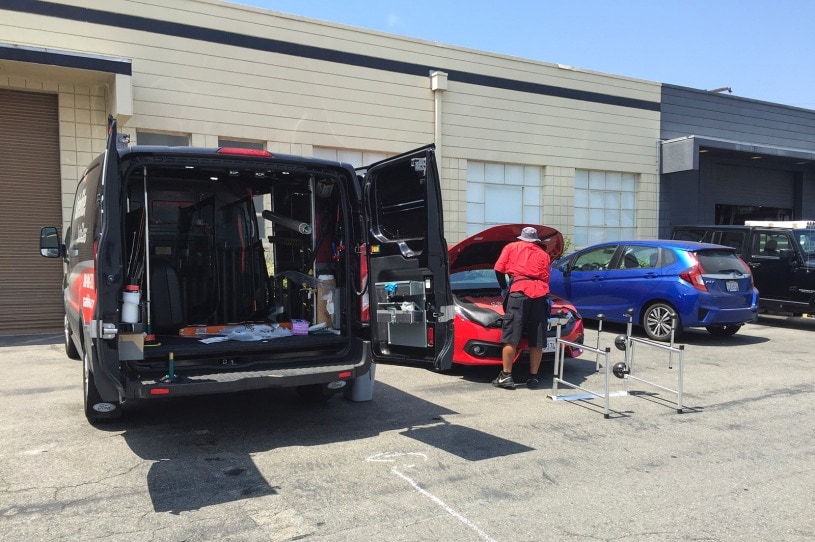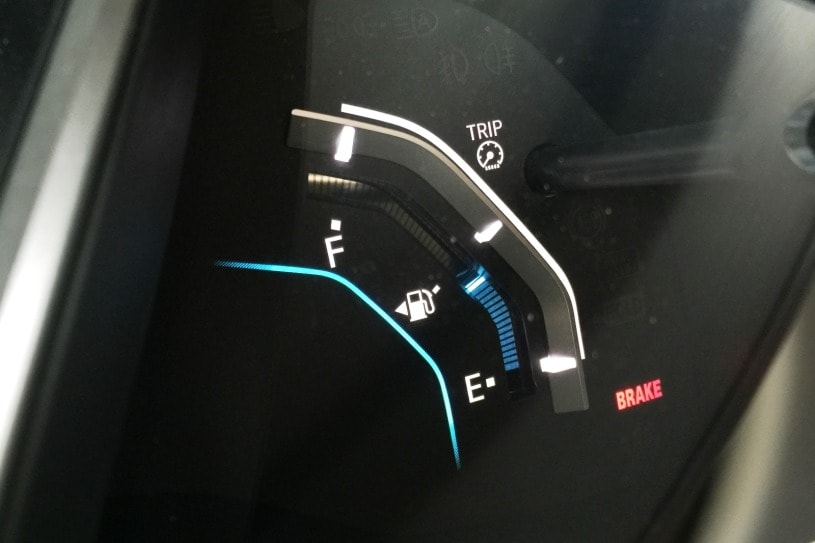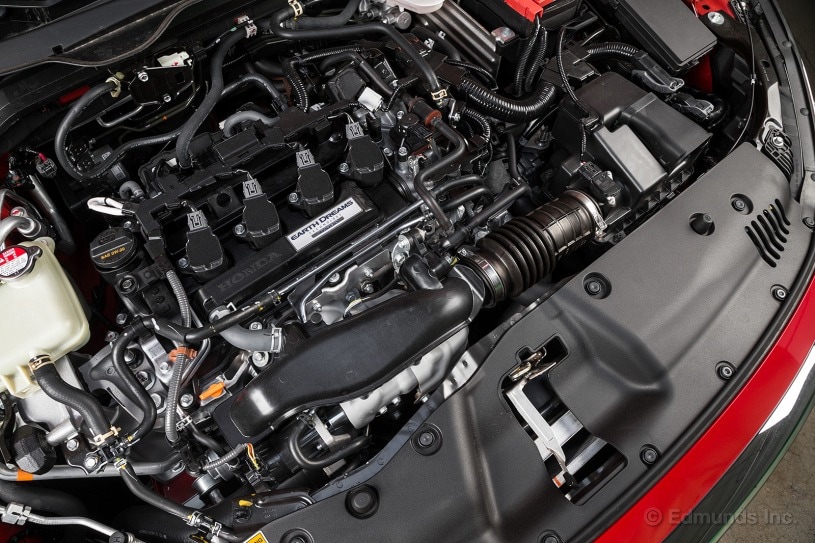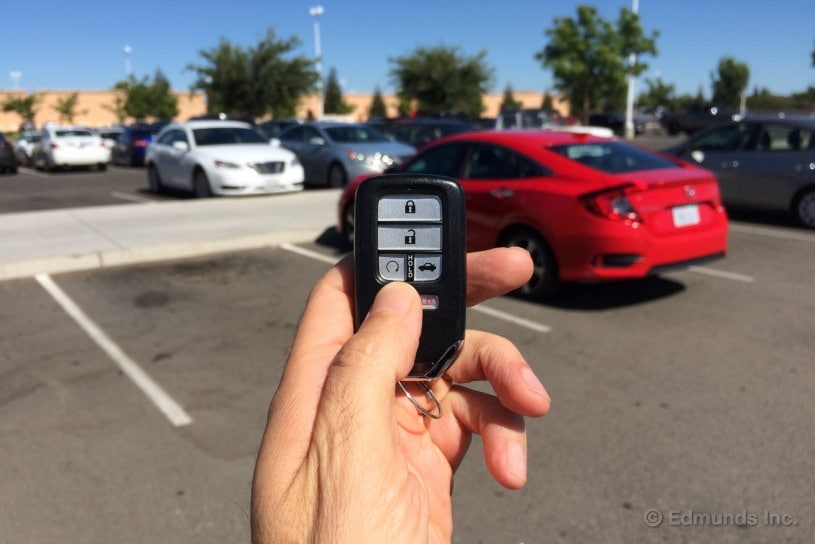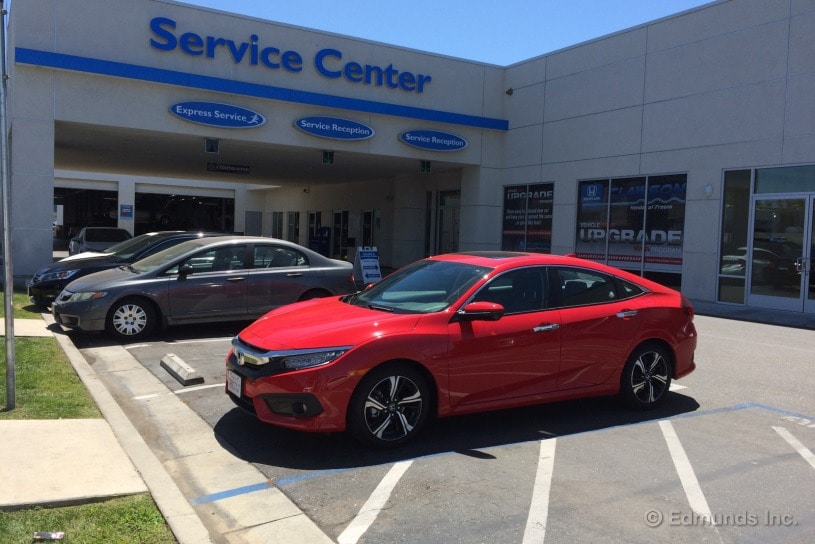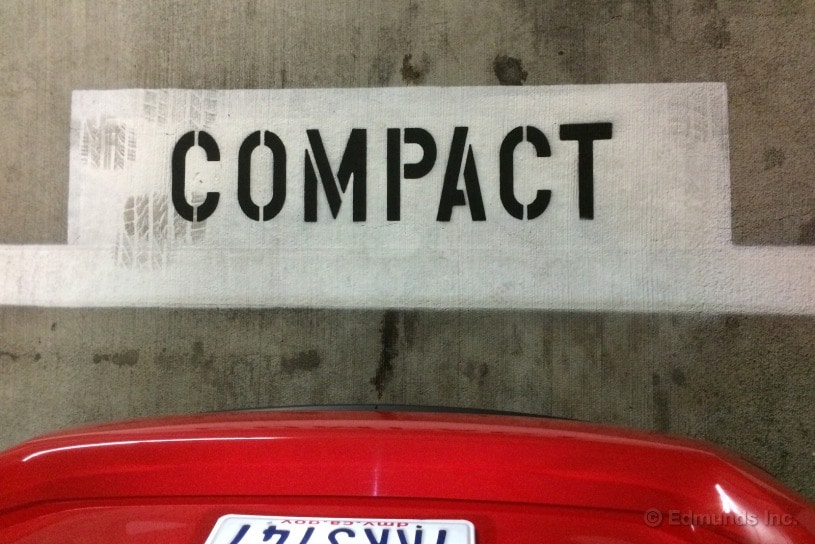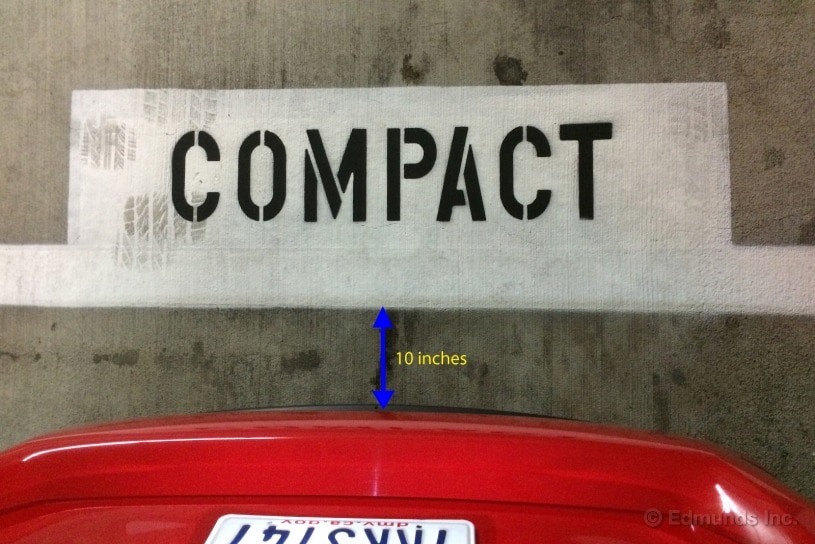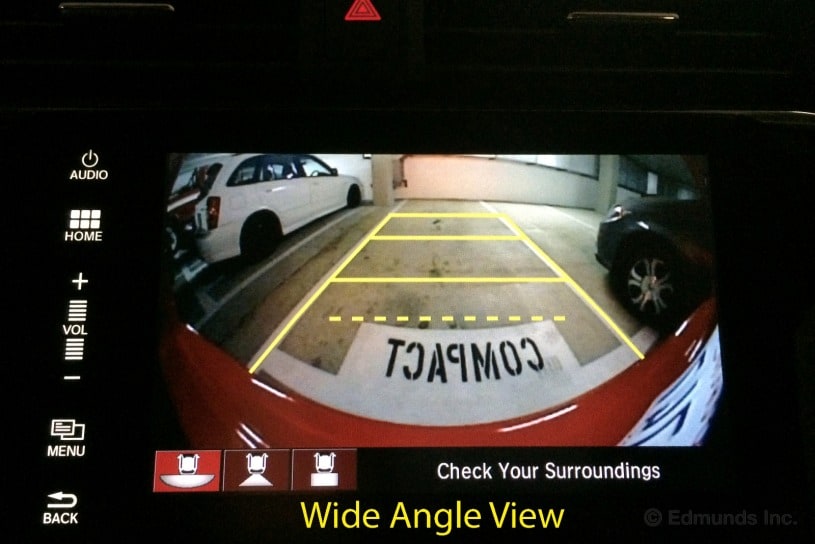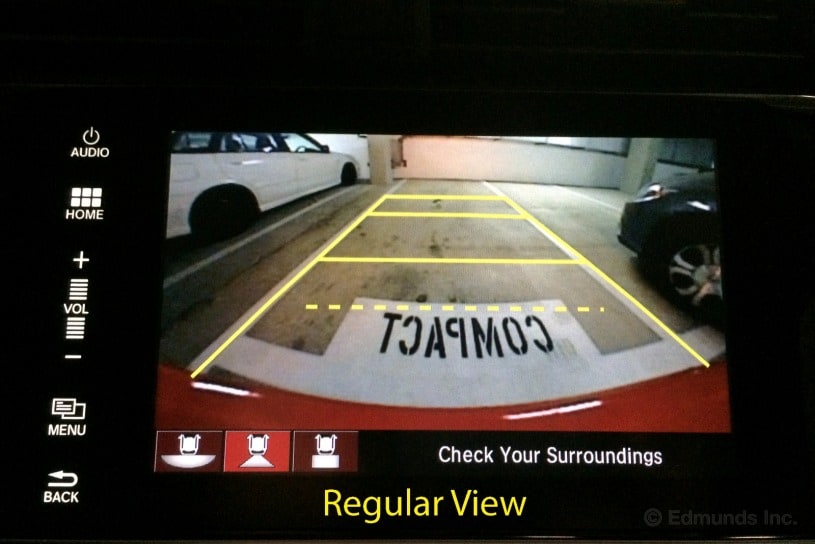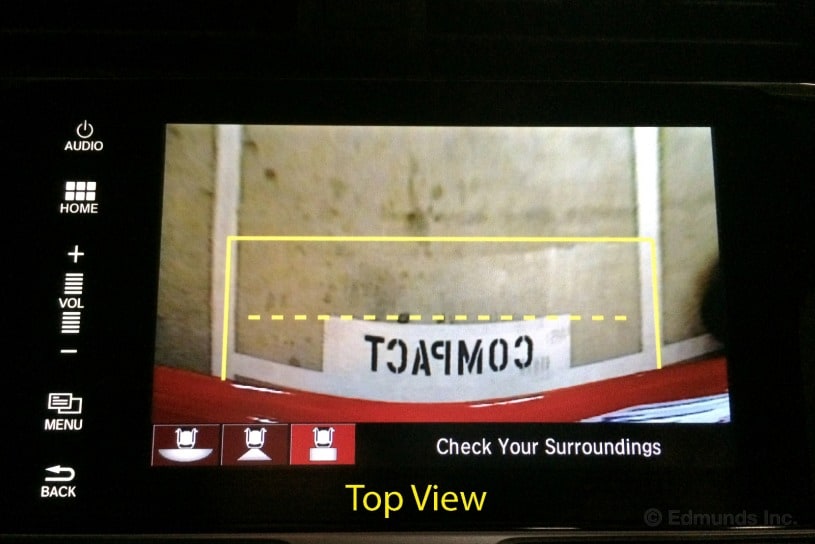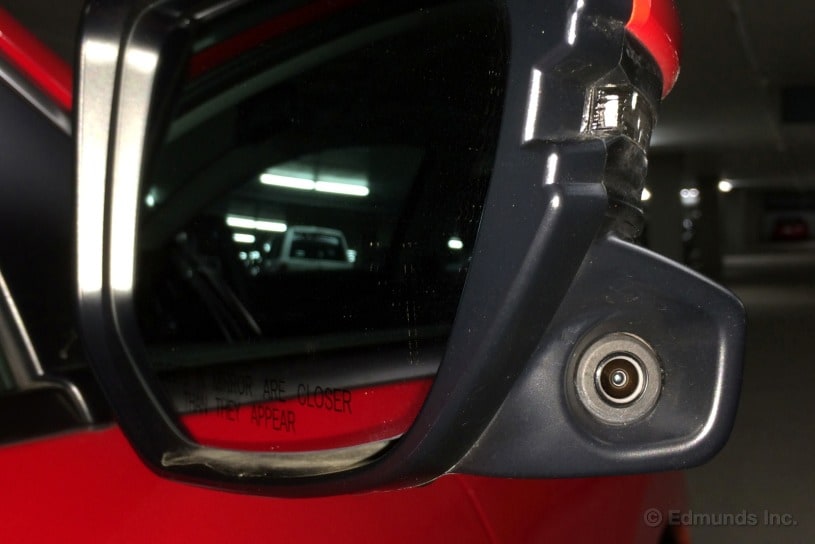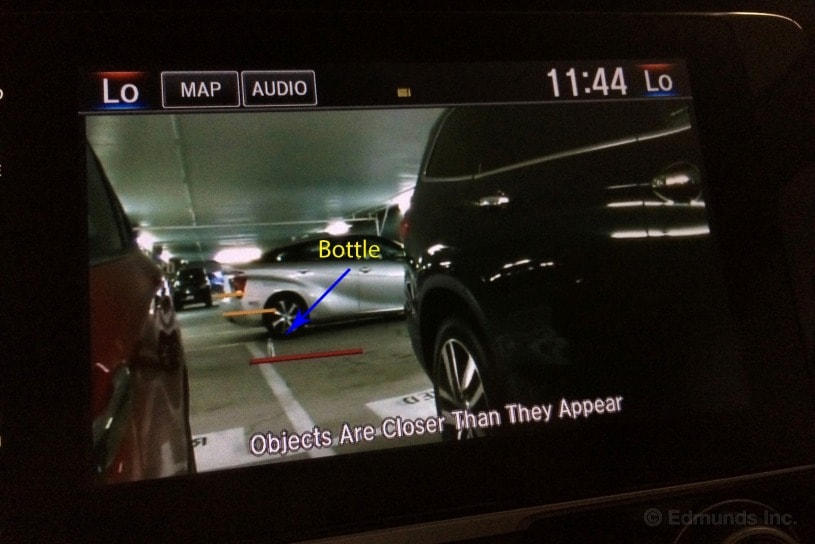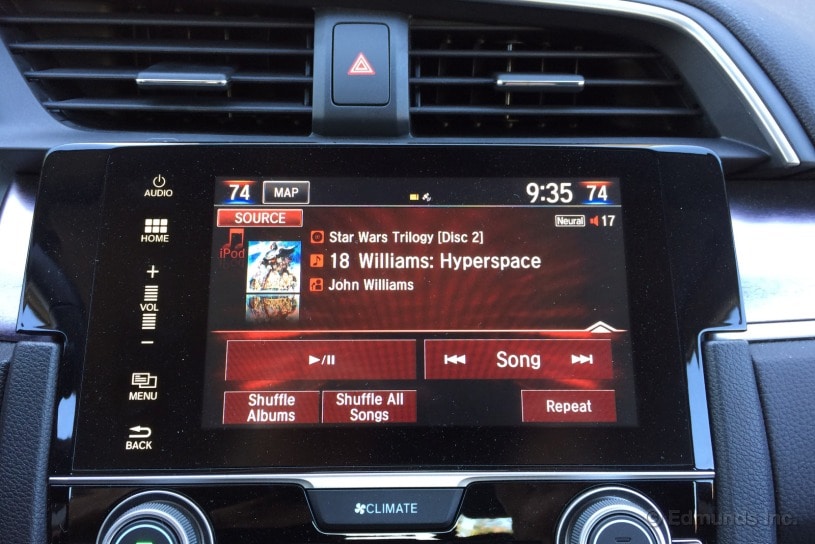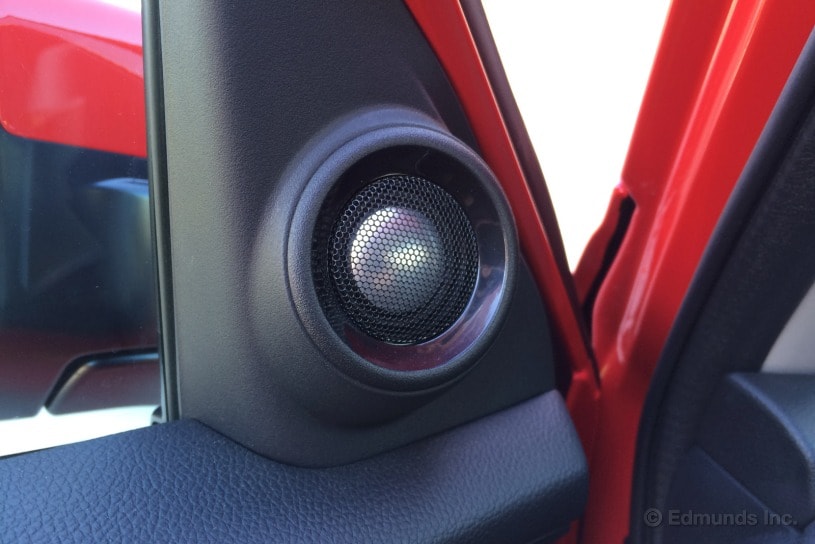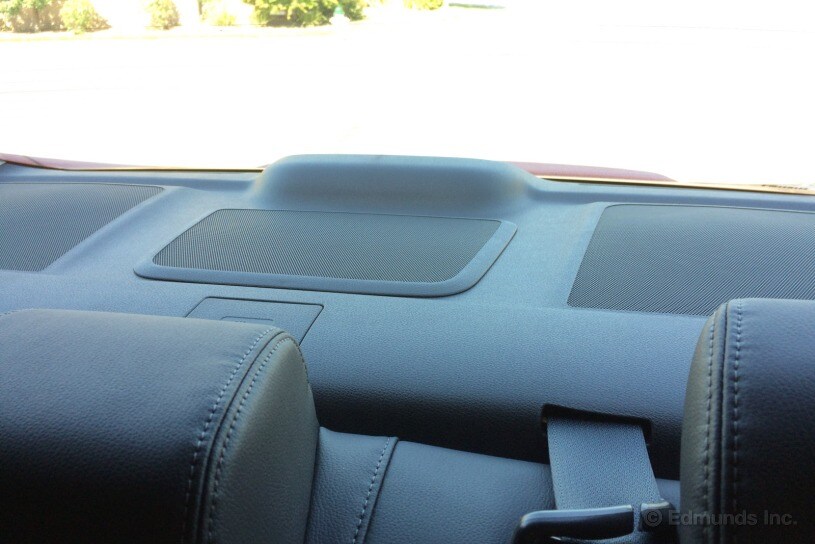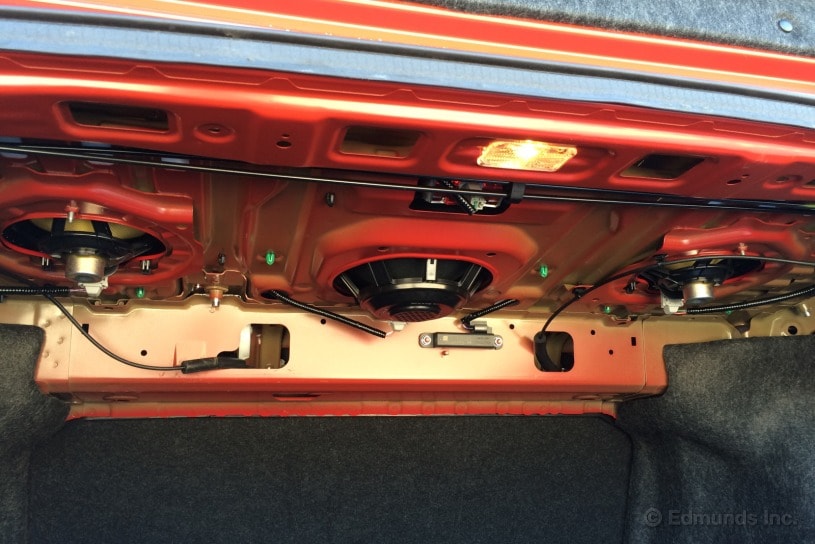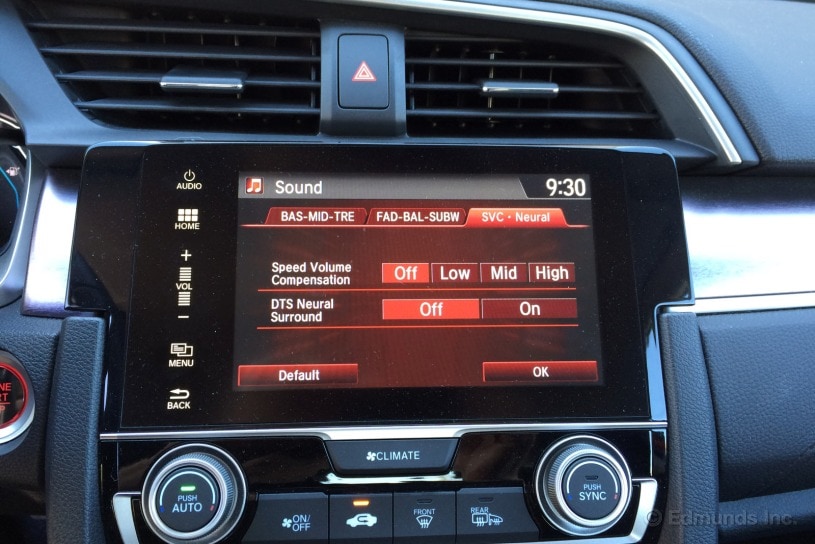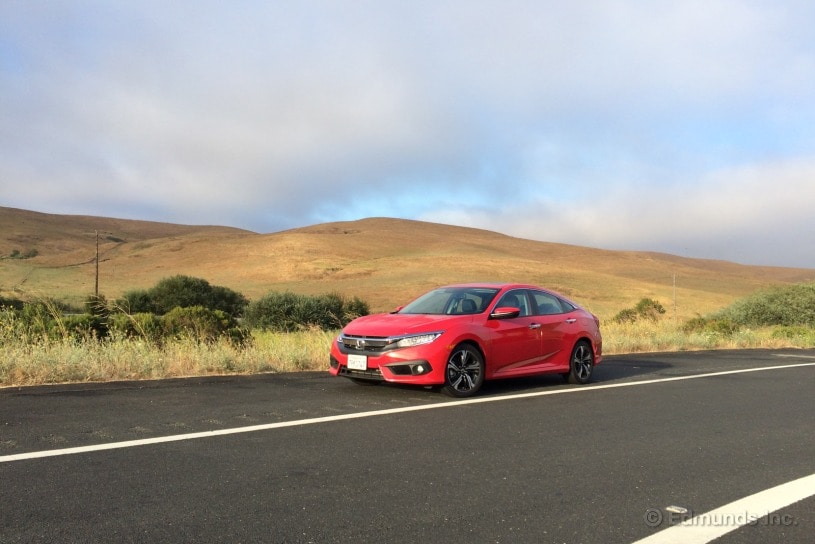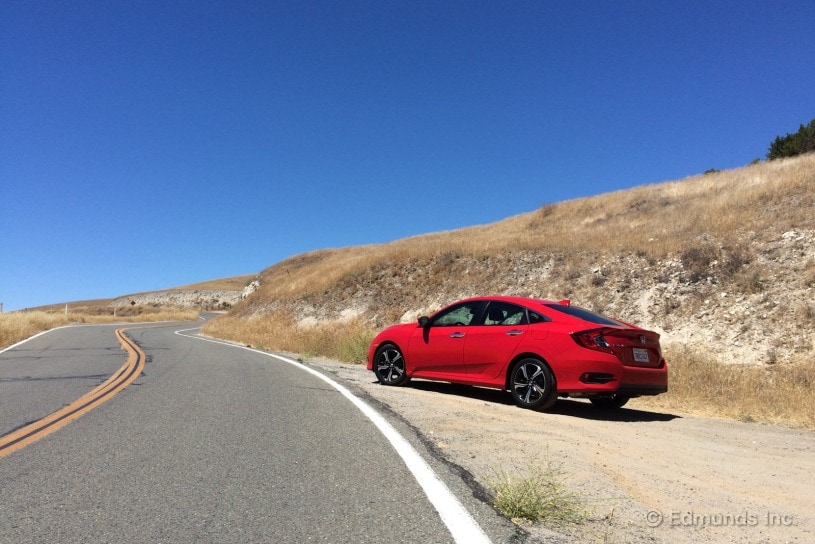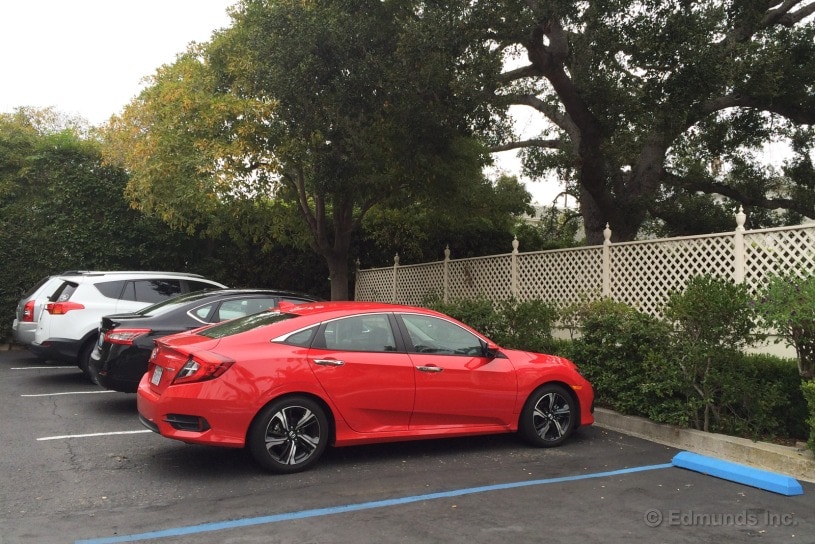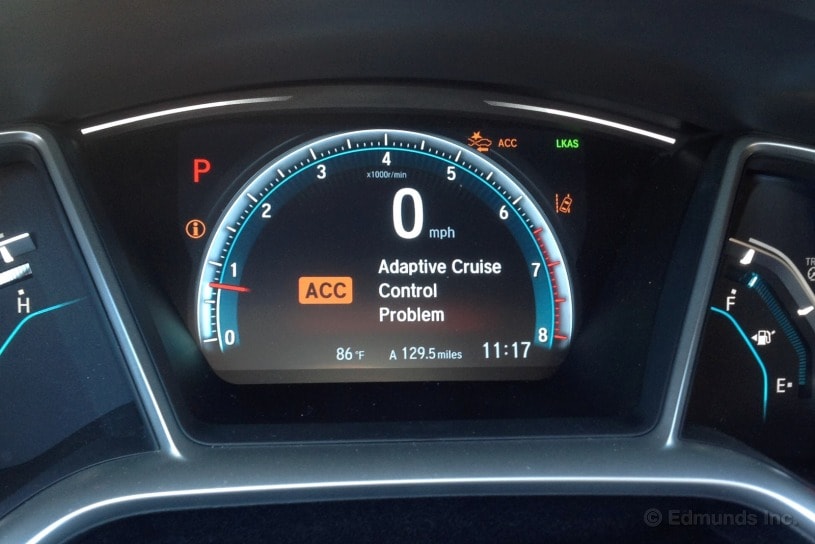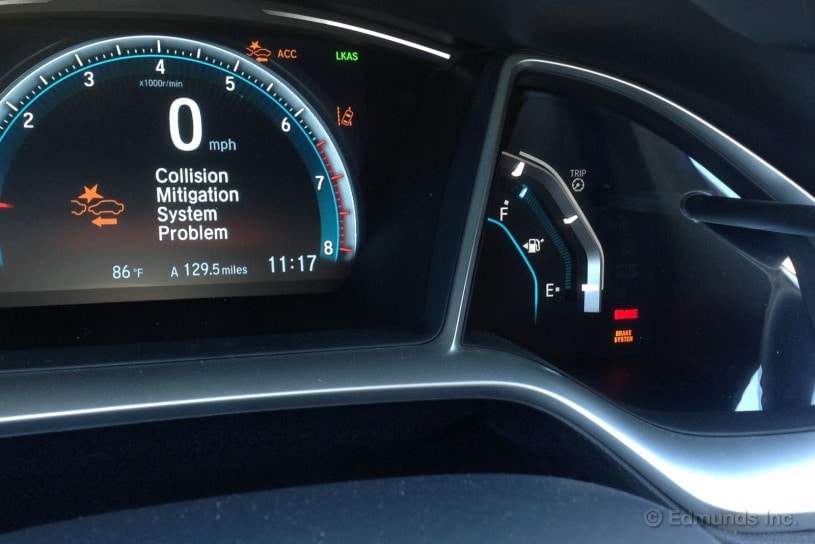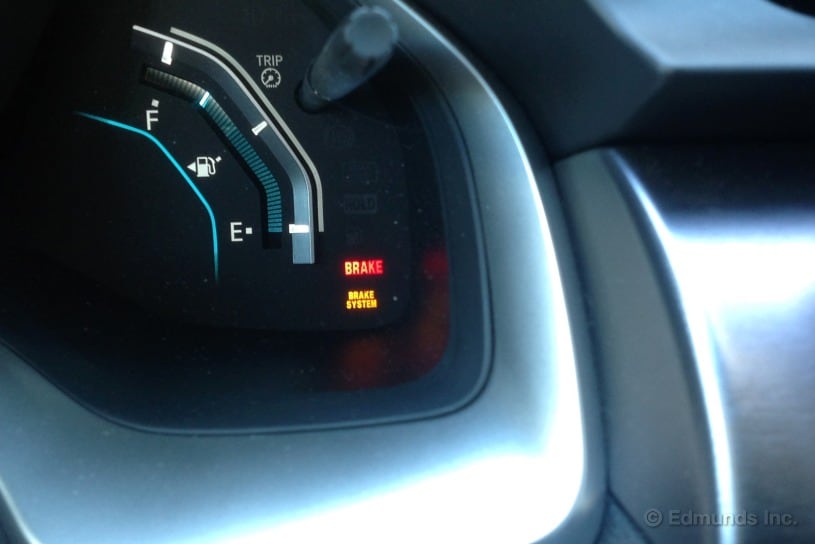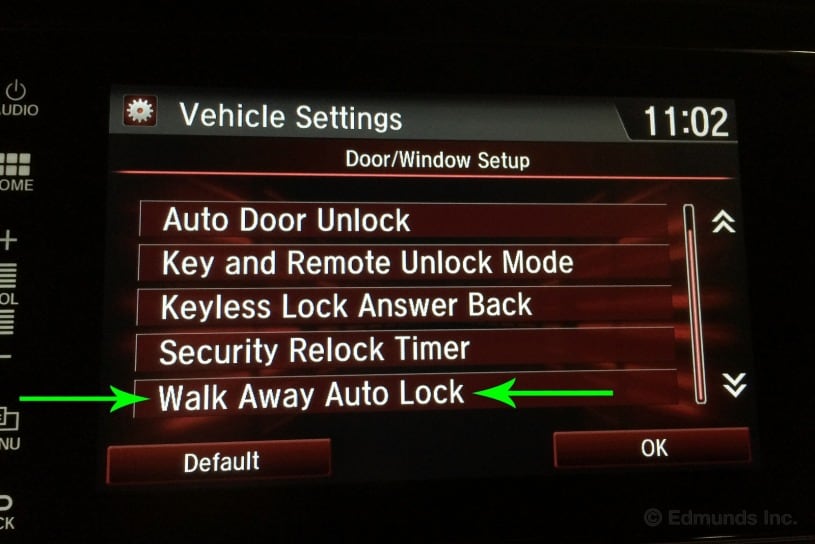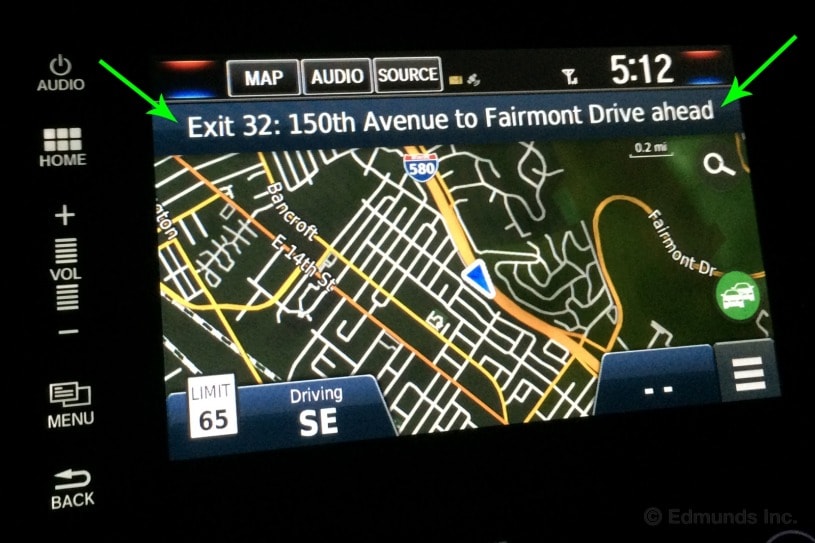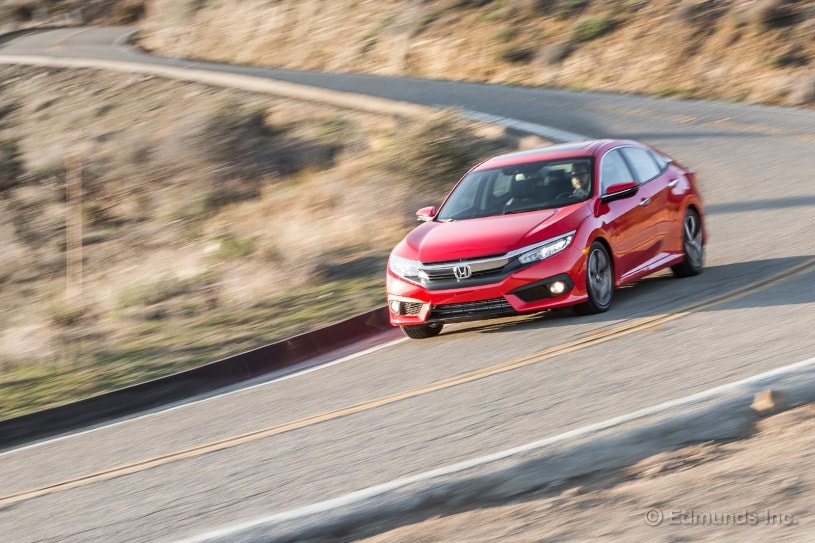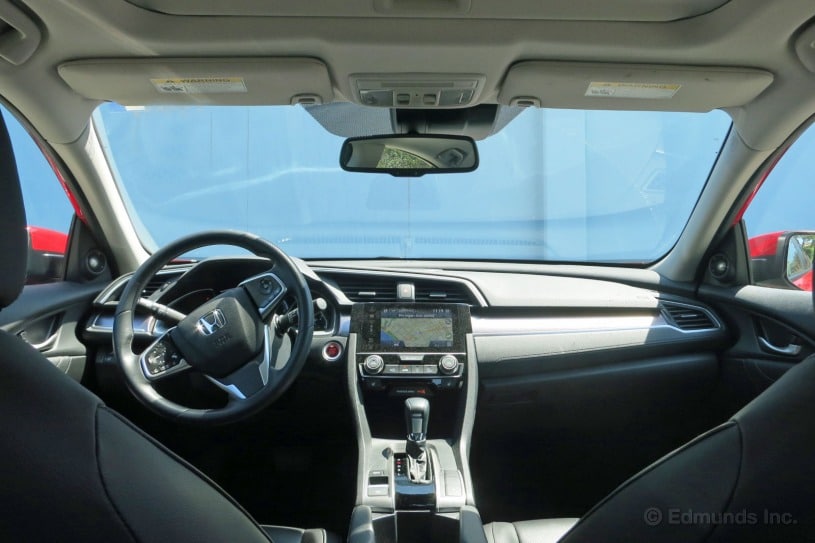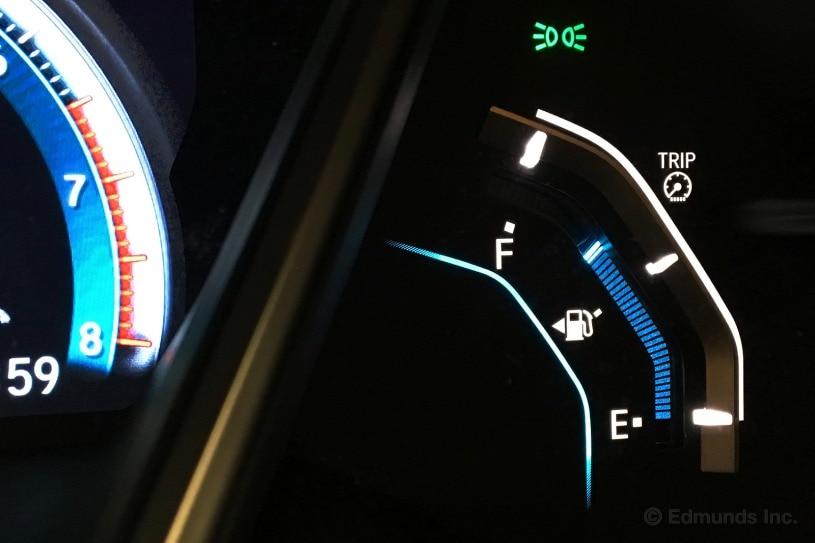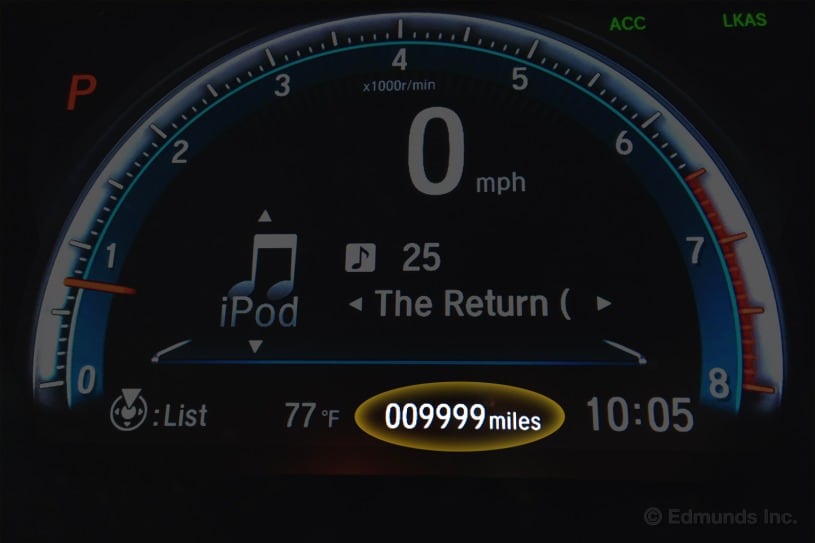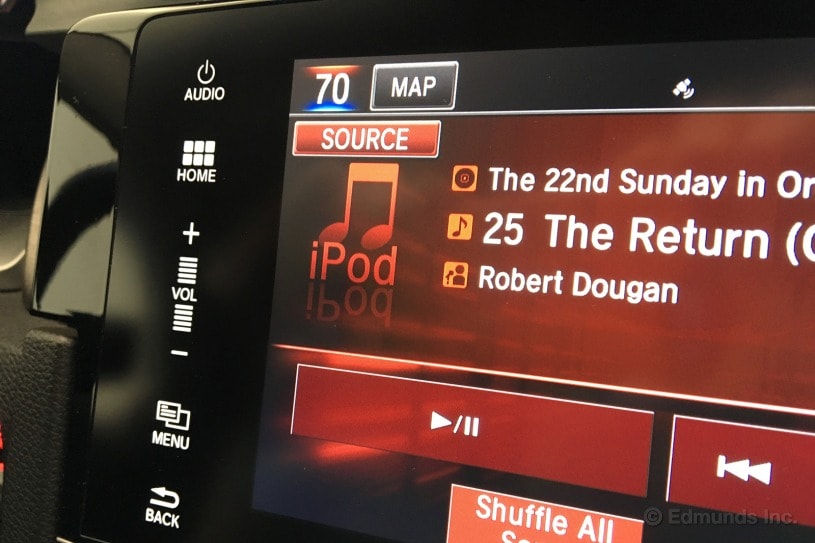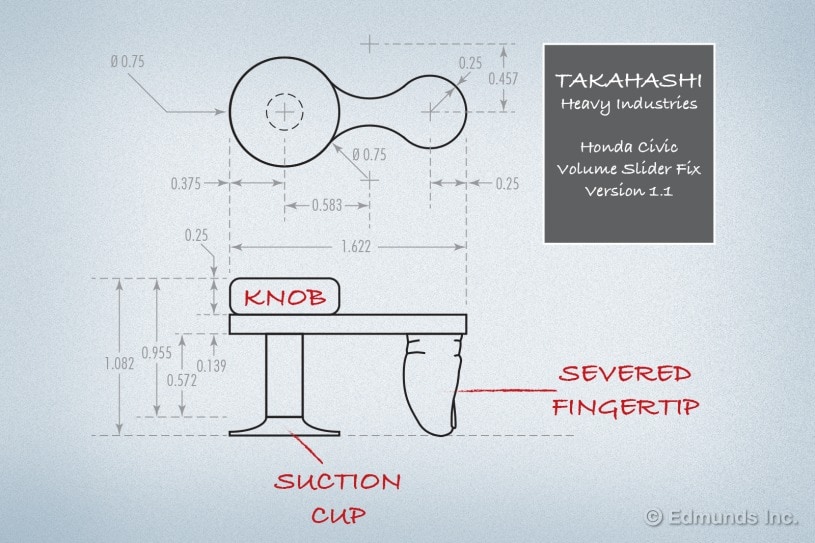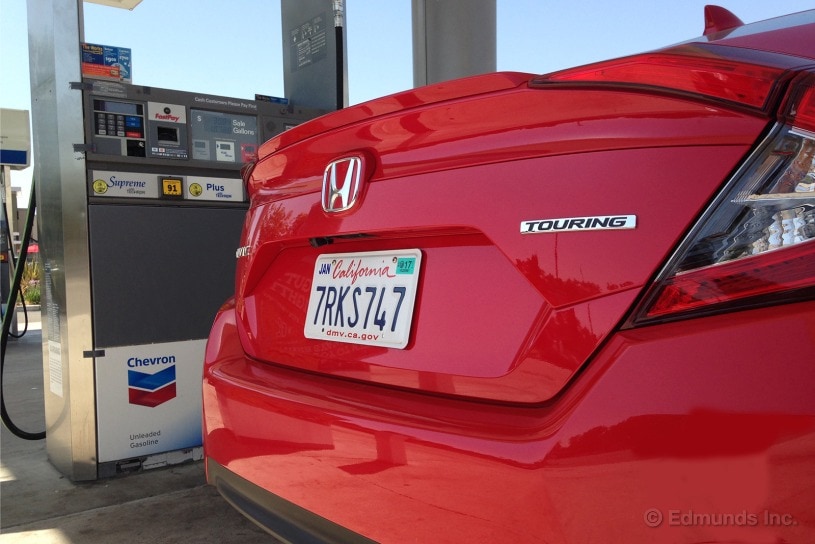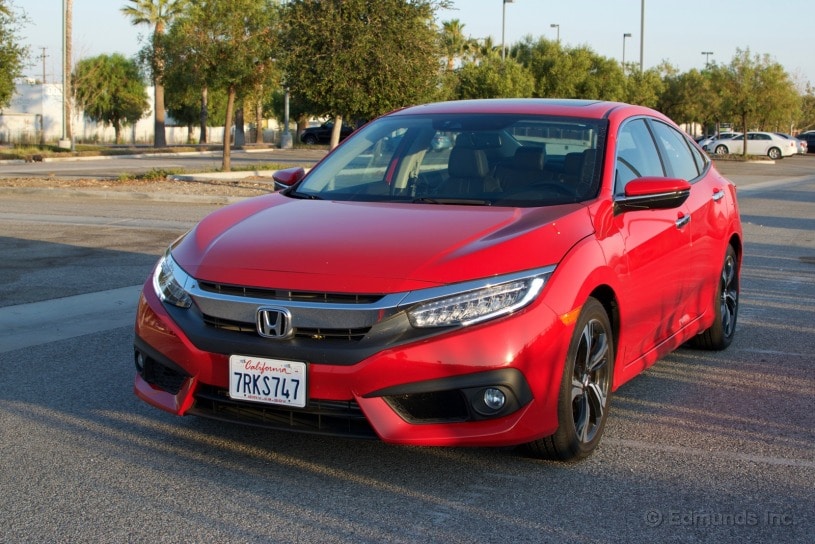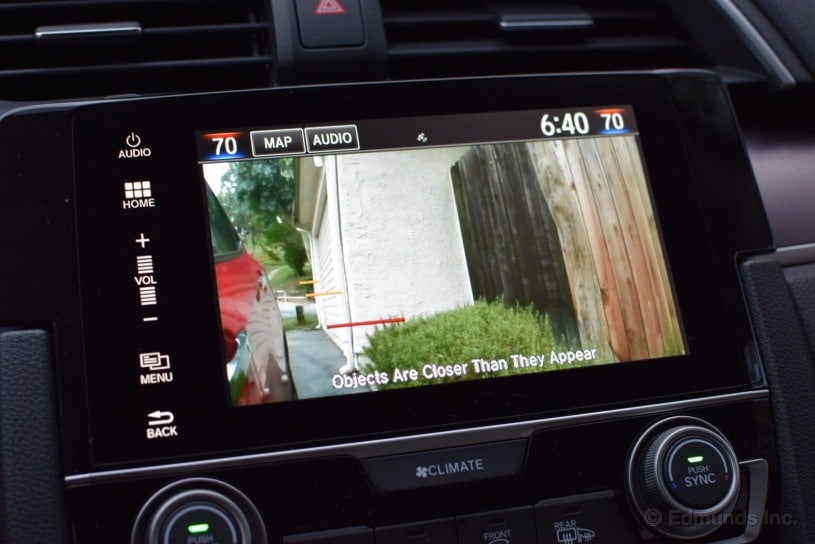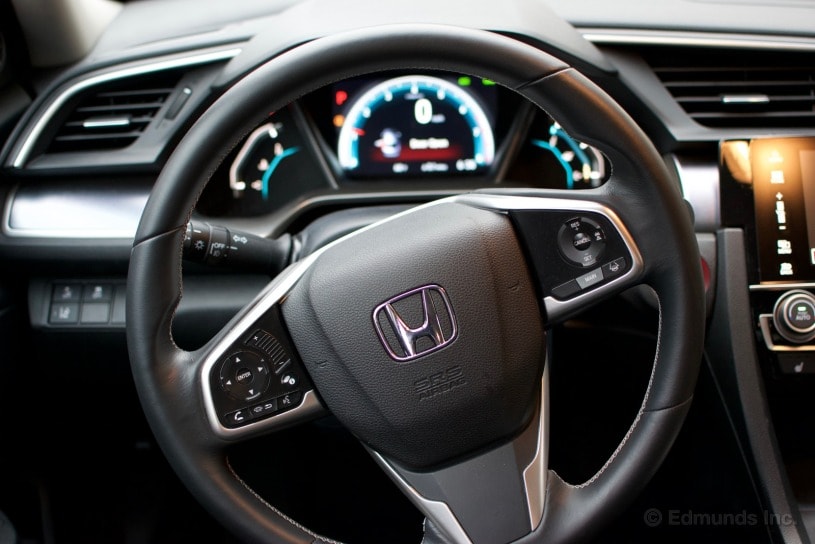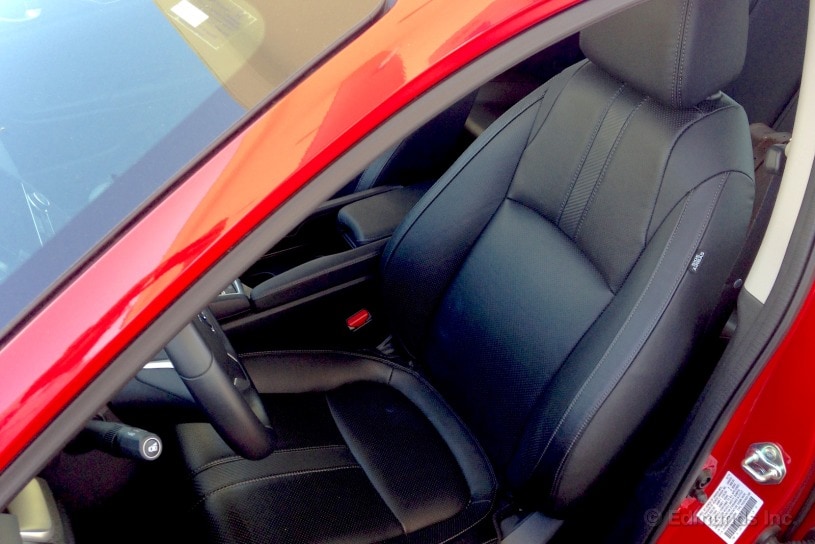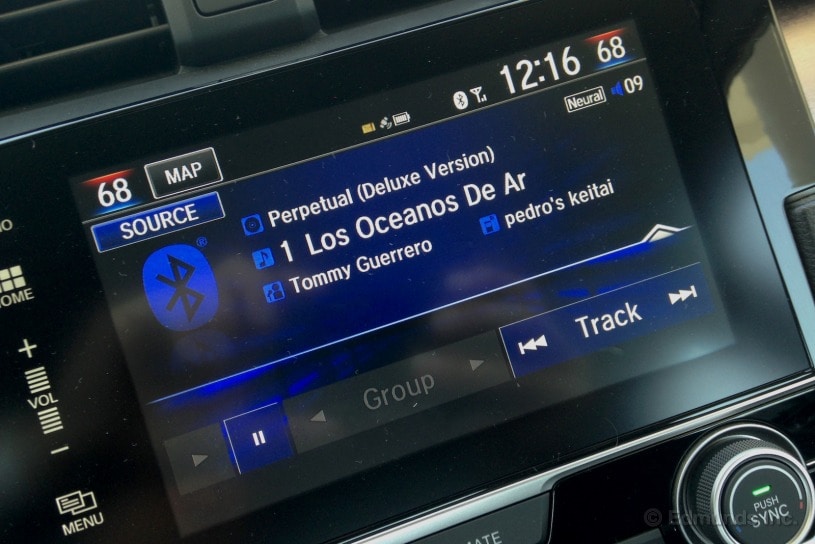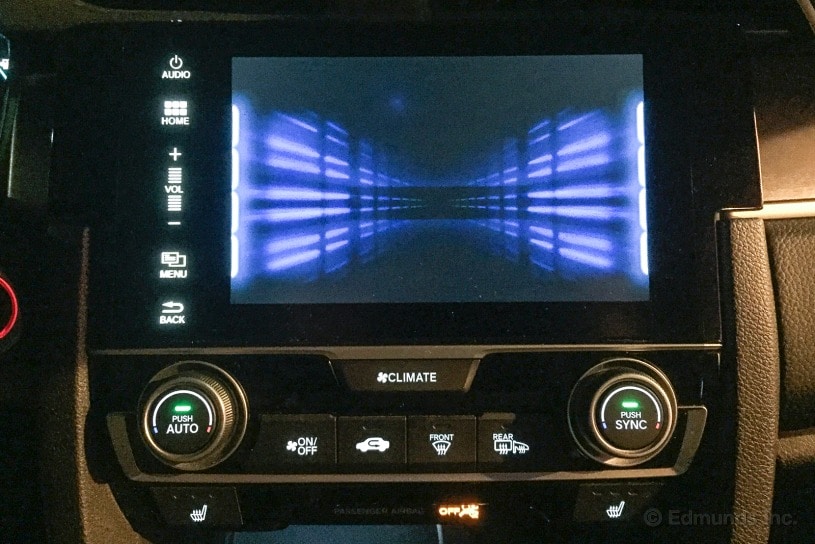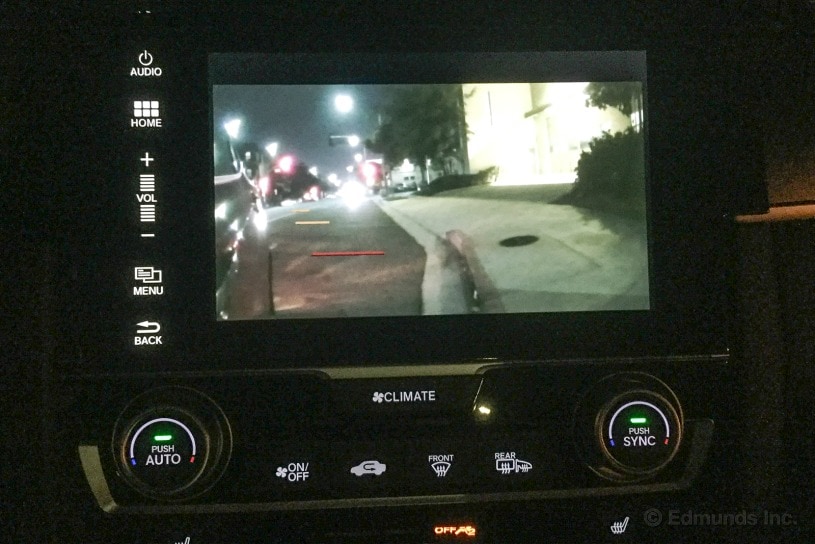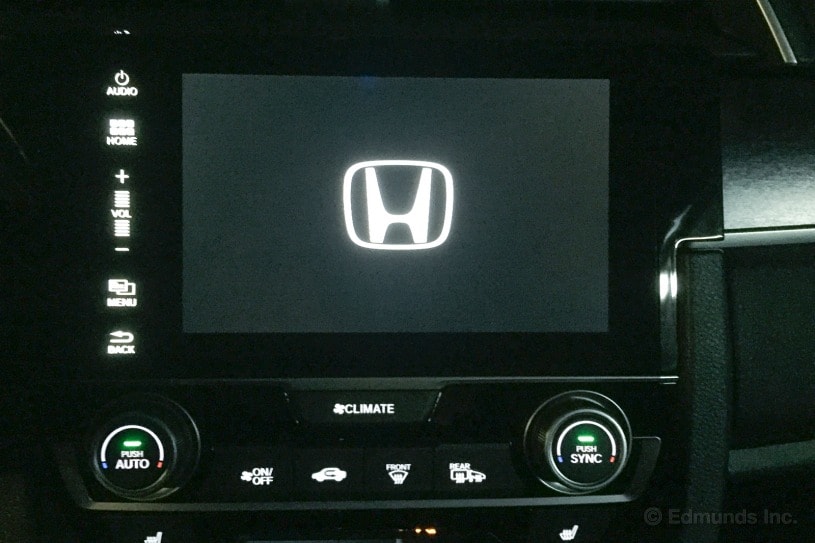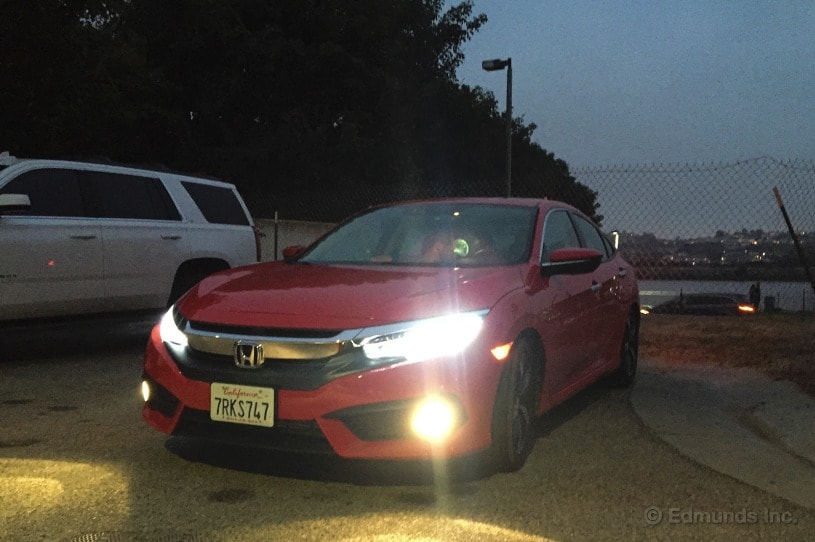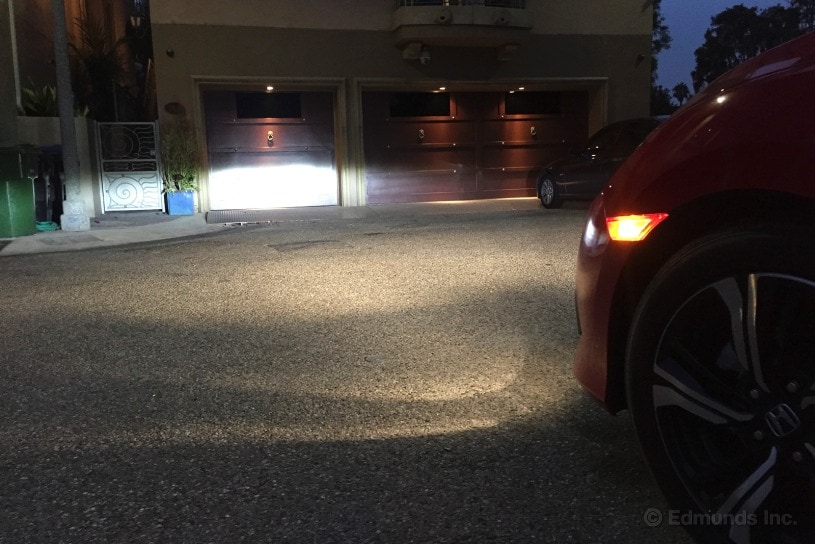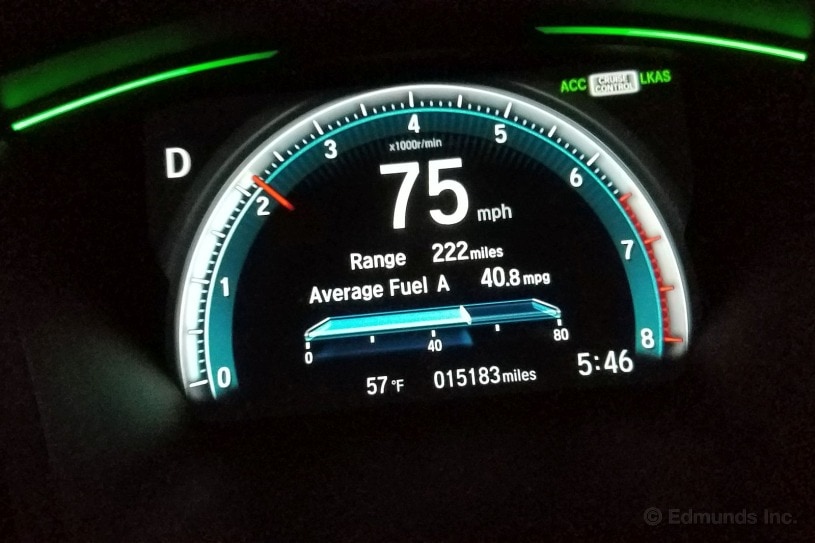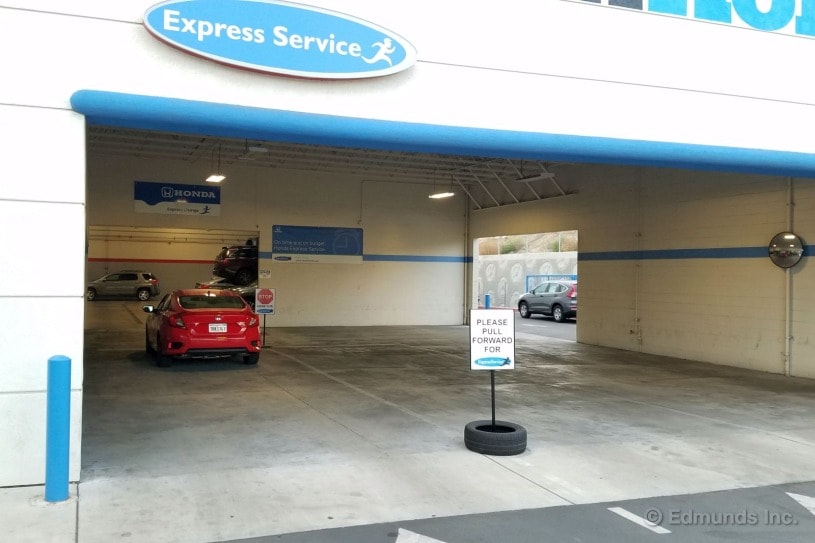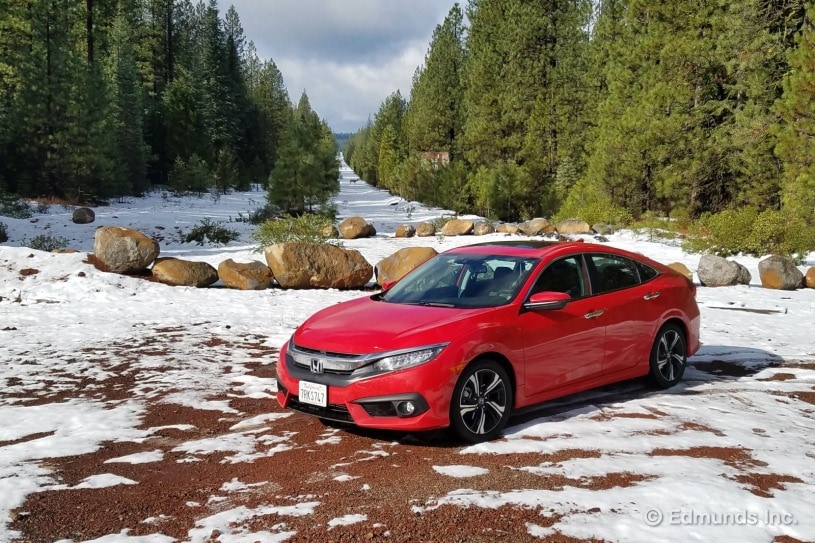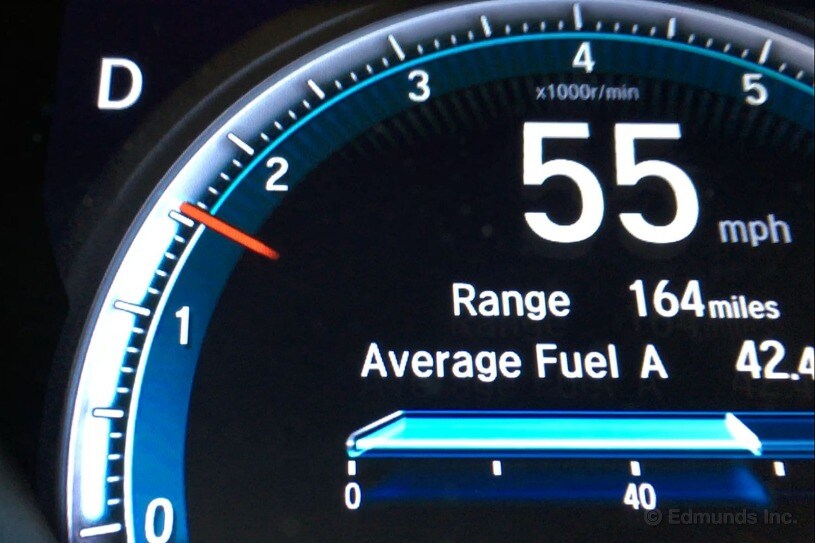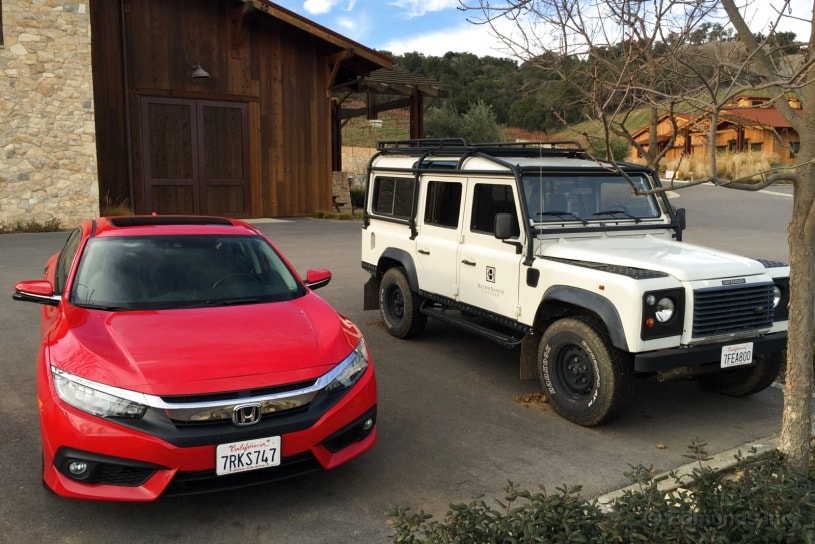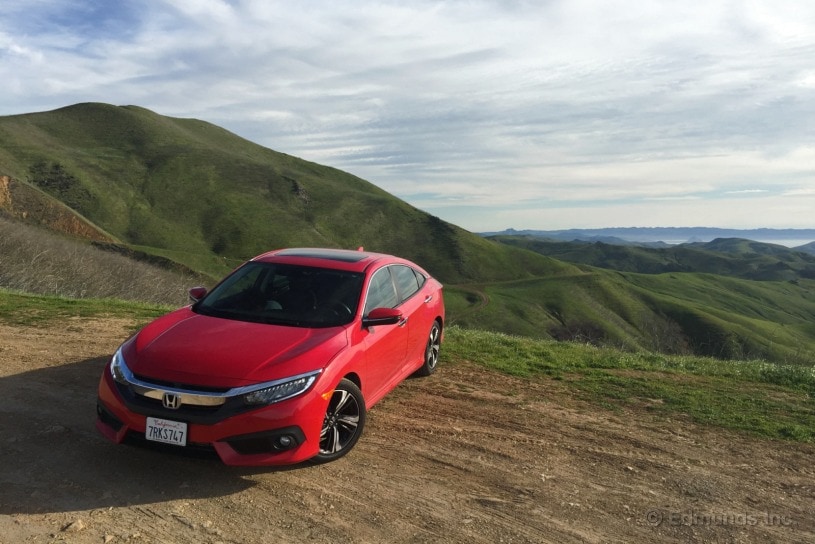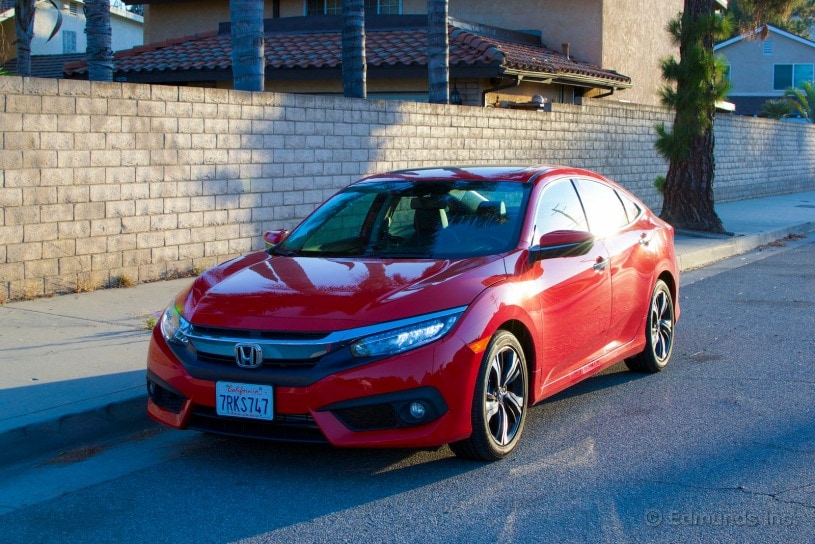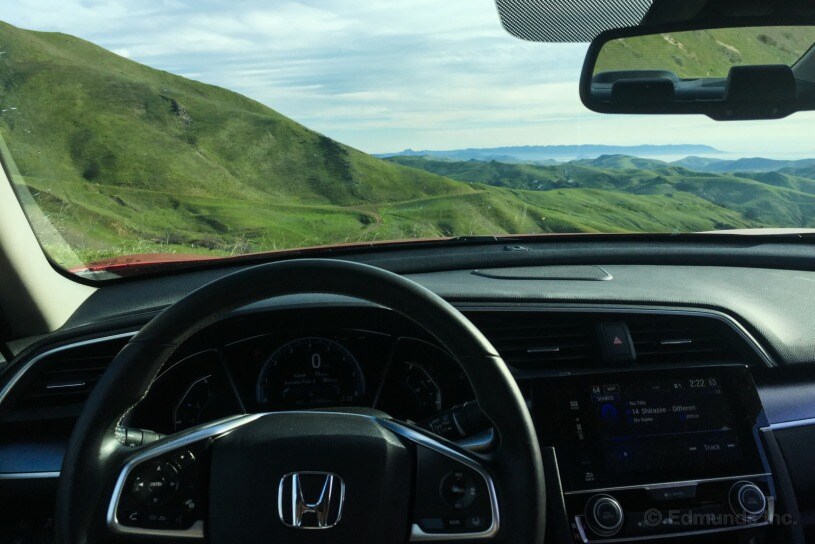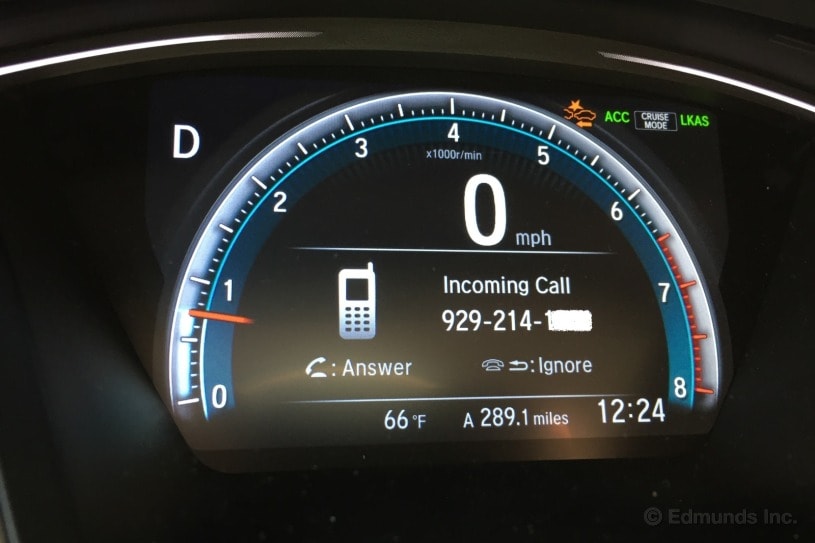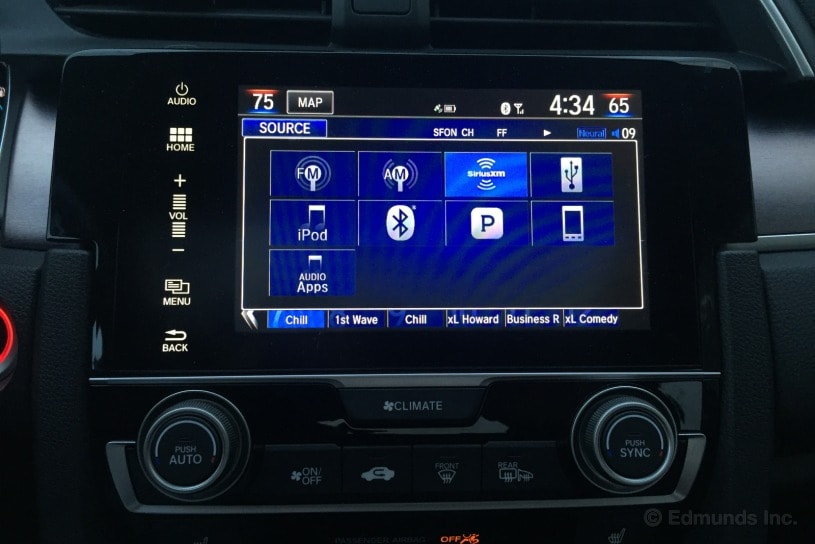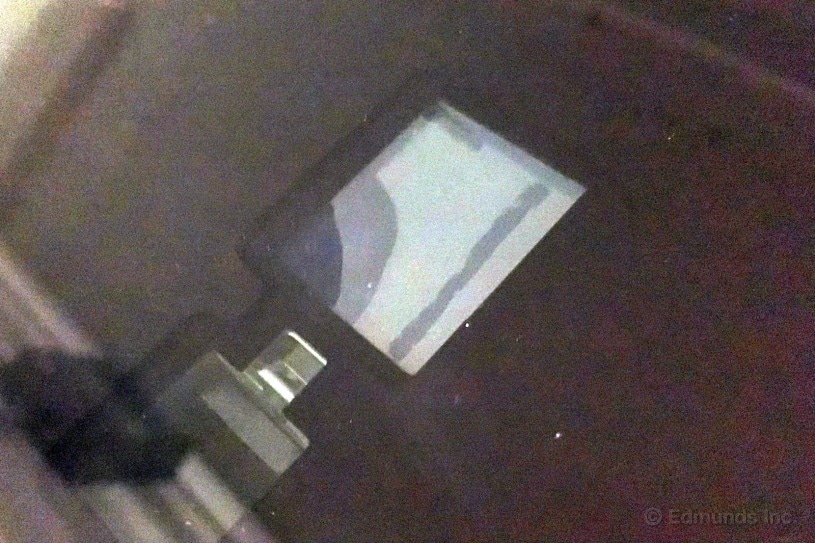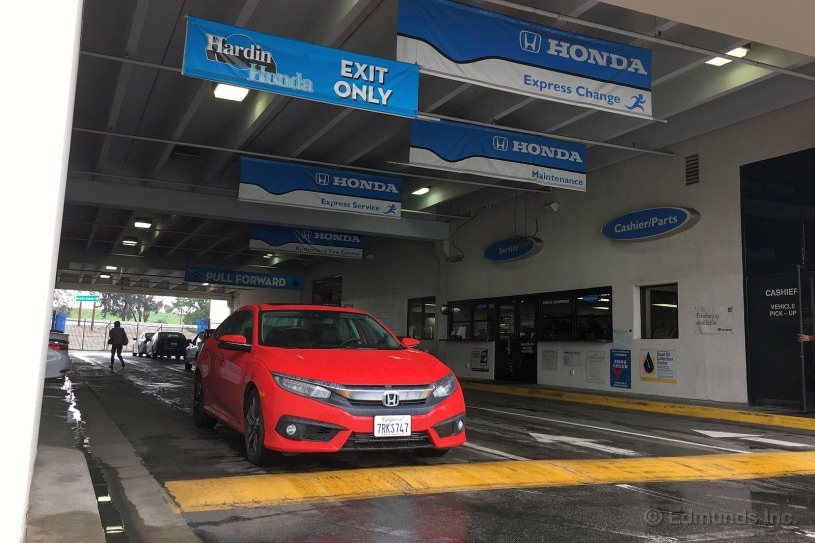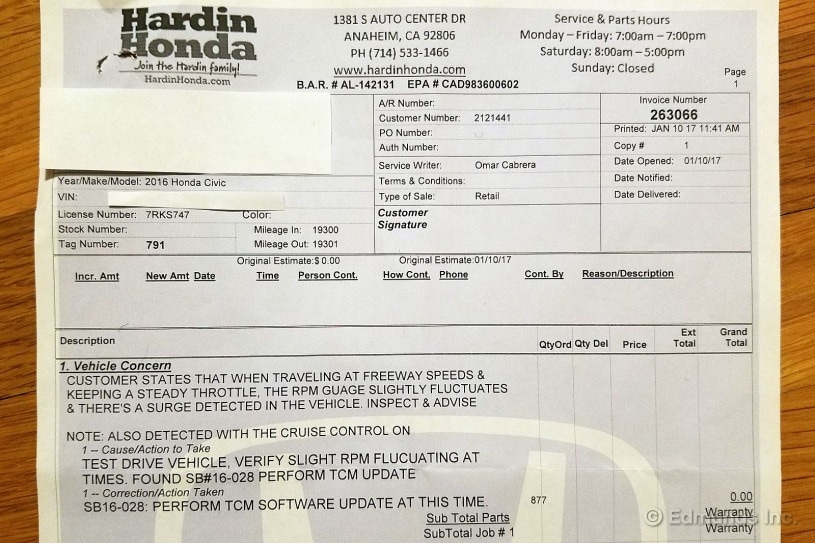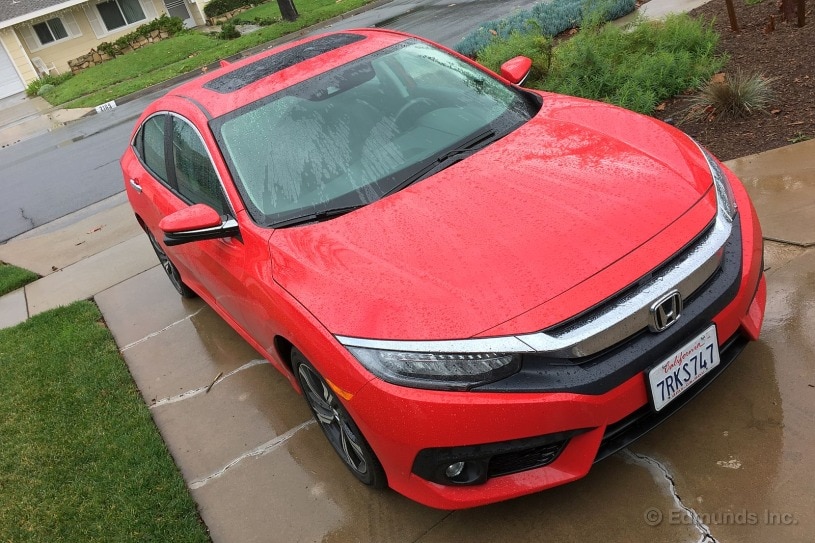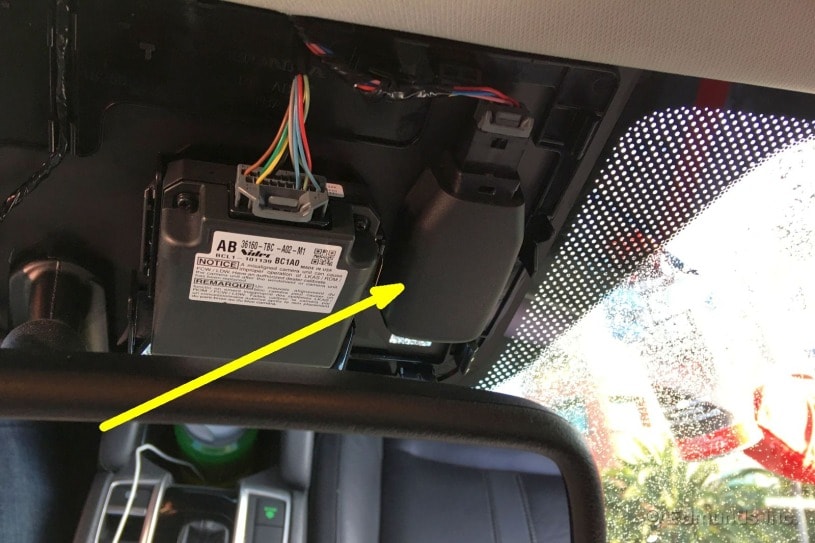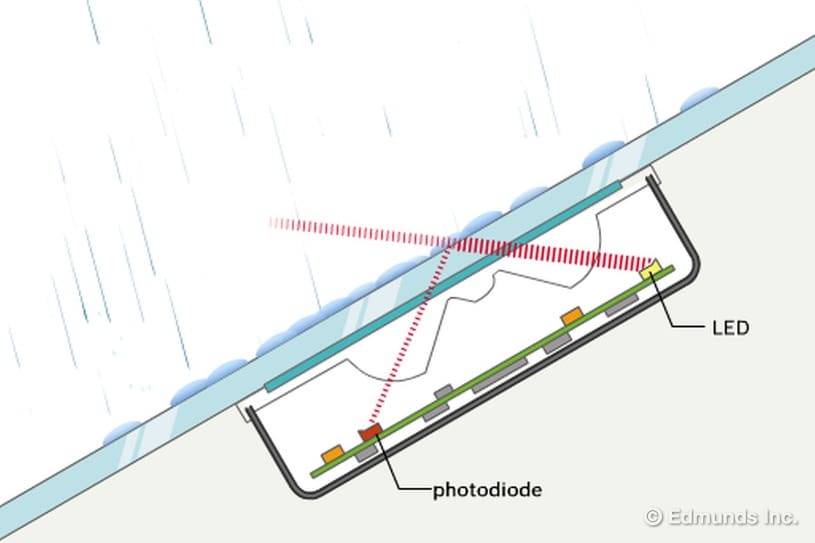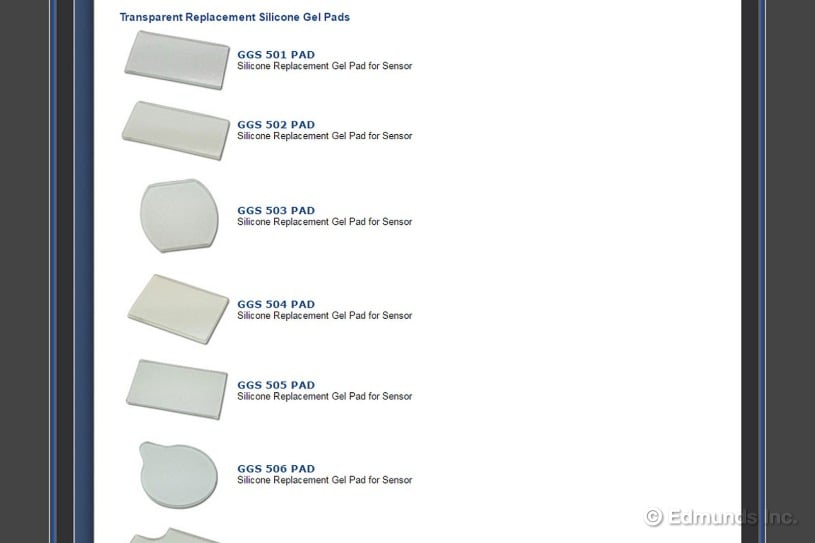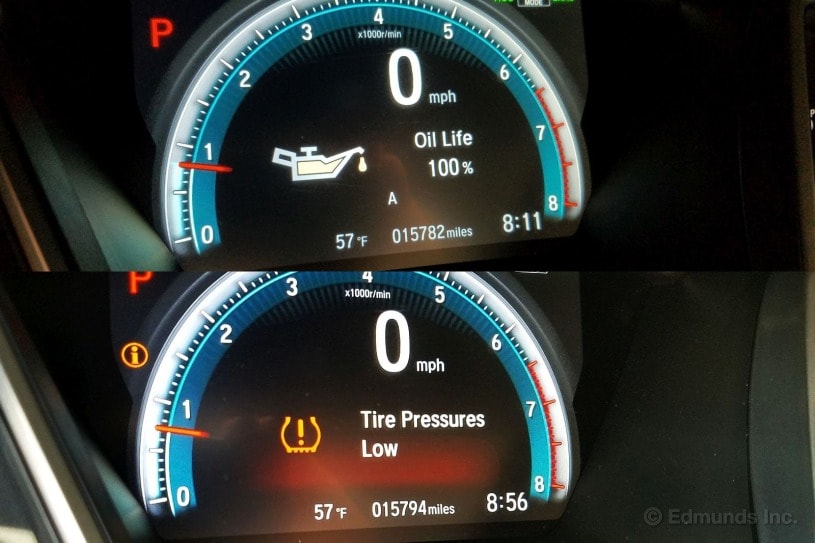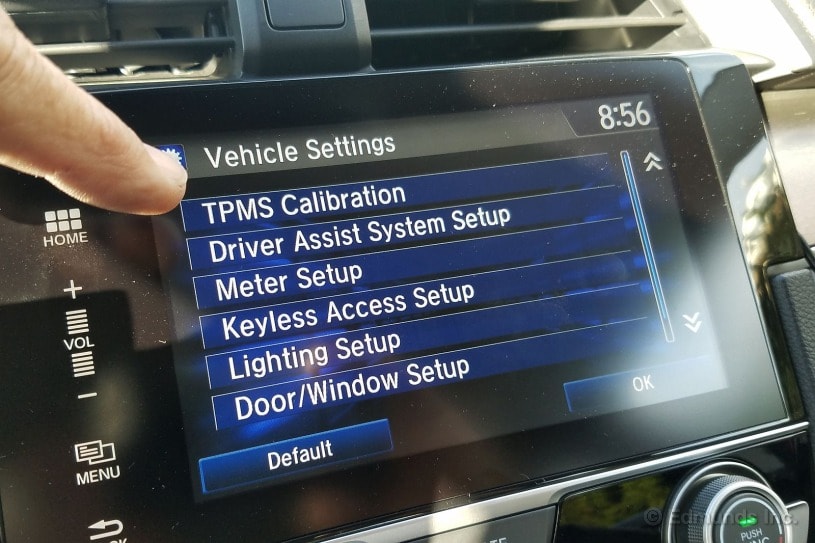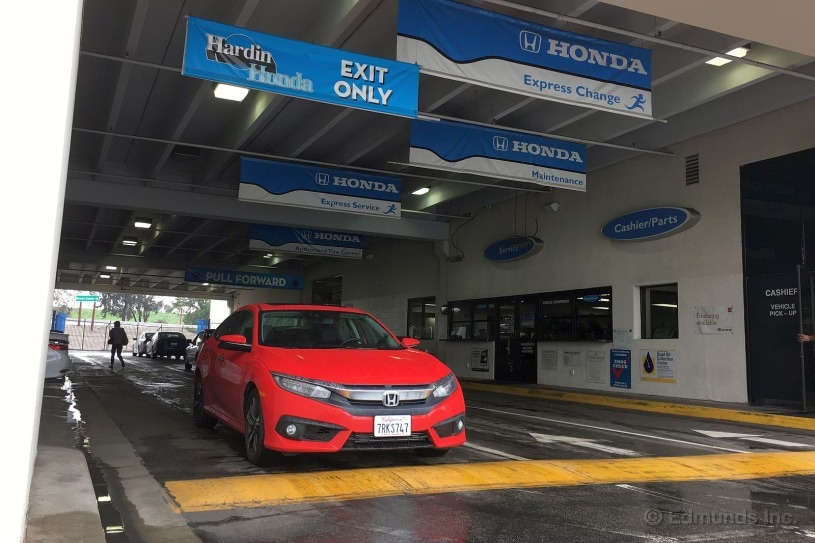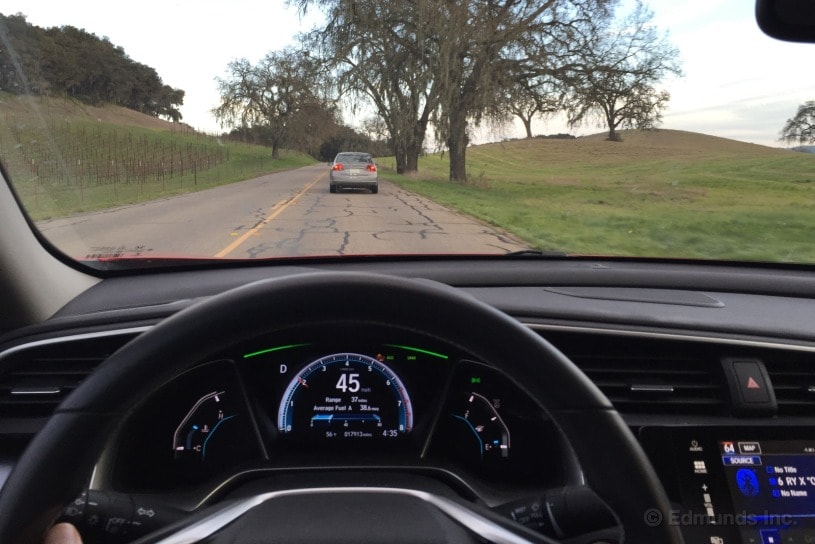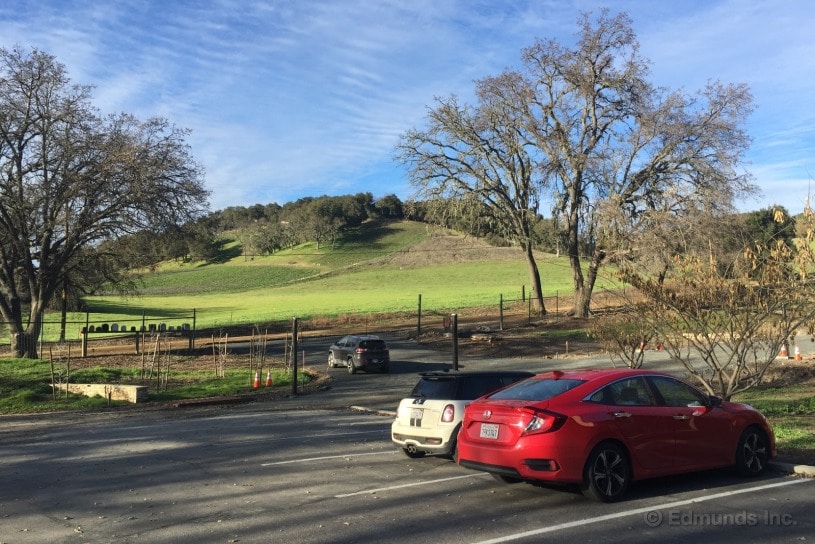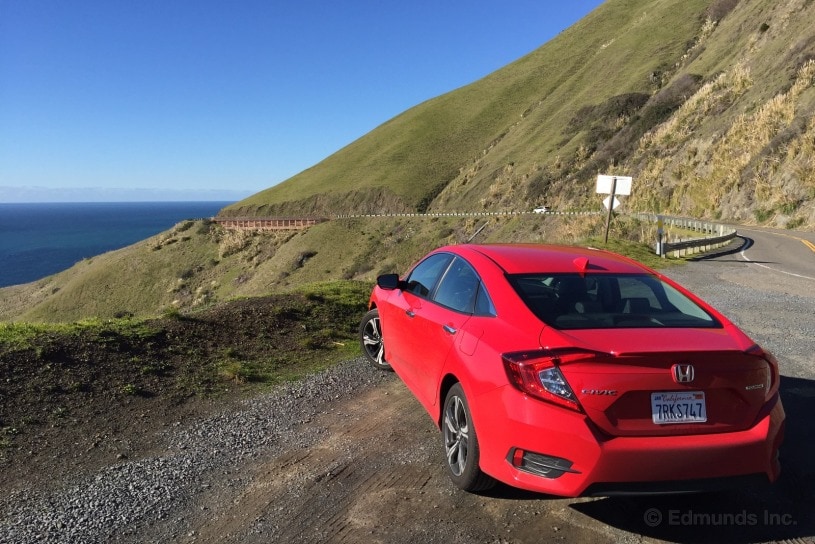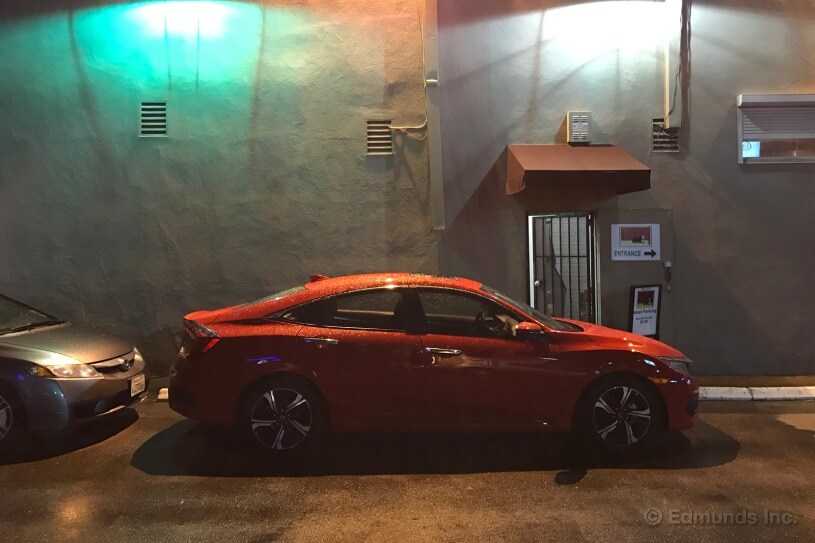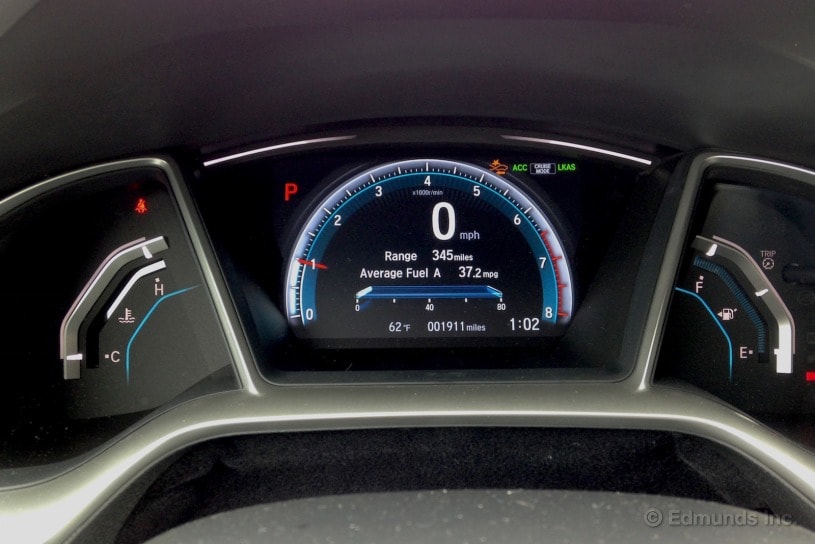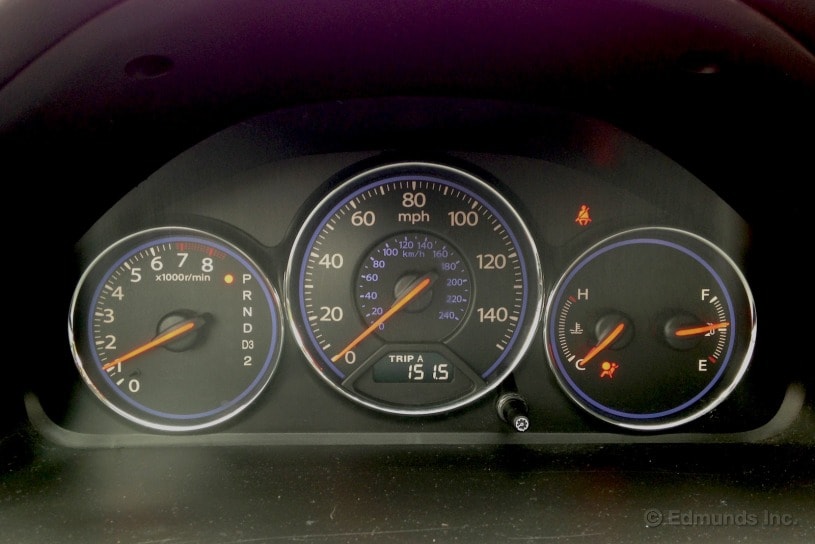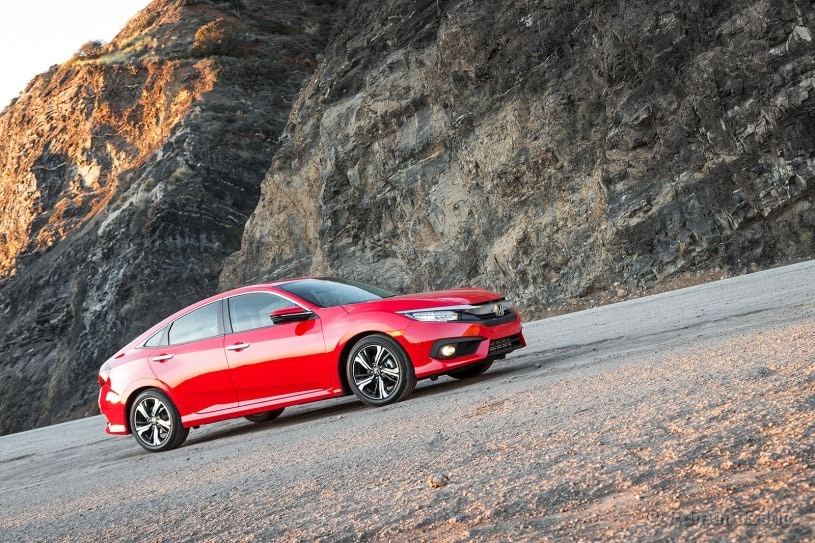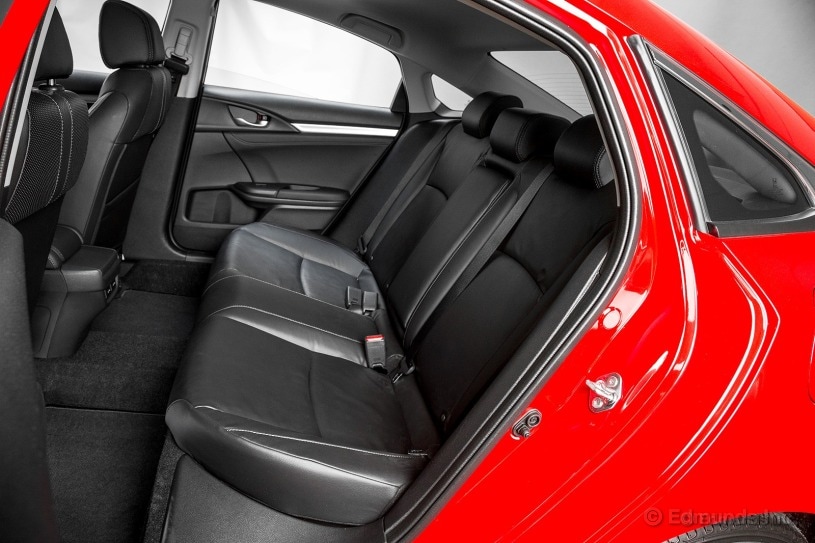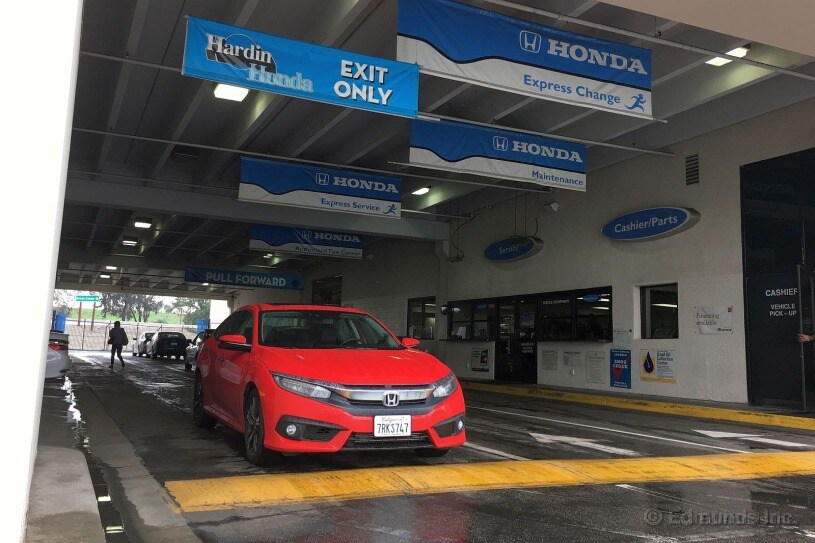2016 Honda Civic: What's It Like to Live With?
Read the latest updates in our long-term road test of the 2016 Honda Civic as our editors live with this car for a year.
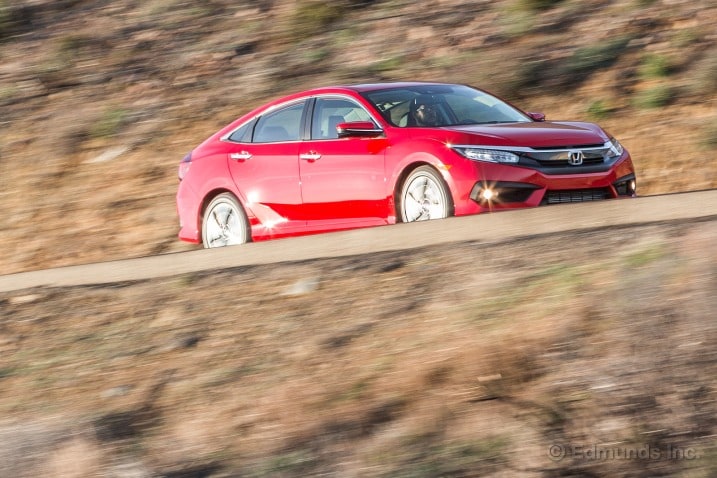
What do you want to know about?
- Introduction
- This Can't Be a Civic - It's Too Nice
- Not Much Of A Break-in Procedure
- Clever Pass-Through Makes for Tidy Interior
- Steering Wheel Volume Control Has Problems of Its Own
- Do You Like LaneWatch?
- At Least the Touchscreen Looks Cool
- Massively Improved Front Seat Adjustment
- Engine Looks Awful, Feels Great
- Unique Gauge Cluster Works Well
- Seats Are Good, Not Great
- Even the Wheels are Best in Class
- Performance Tested - A Deep Dive Into the Numbers
- Will the Giant XL 29er Mountain Bike Fit?
- Skin Graft
- Feels Expensive
- Monthly Fuel Economy Update for March
- Roomy Interior Means I Can Sit Behind Myself
- A CVT I Can Recommend
- Not Your Average Cruise Control
- Si Performance, HF Fuel Economy, and Van Halen Approved
- Installing Front- and Rear-Facing Child Safety Seats
- You Can Have Fun With It Around Turns
- Fuel Economy Update for April - Best Tank So Far
- Hypersensitive Crash Alerts
- Climate Control Consternation
- Heated Rear Seats
- 8 Ways This is a Staggeringly Good, Class-Leading Car
- Highway Cruising With Adaptive Cruise Control and Lane Departure Intervention
- I, Too, Found an Easter Egg
- Cracked Windshield Saga
- I Like The Rallye Red
- Fuel Economy Update for May
- They're Everywhere
- Cracked Windshield Saga Part 2
- 5,000 Miles and Counting
- Almost 50 MPG on the Highway
- 6 Things I Learned After 1,100 Miles
- Finally, the Windshield Has Been Replaced
- Strong June for Miles Raises Lifetime Average Fuel Economy
- Turbo and CVT Make for a Surprising Drive
- Remote Start Helps Cool You Off for the Summer
- First Dealer Service
- Getting Creative With Camera Angles
- Testing the 10-Speaker Sound System
- Enjoyable on a Road Trip
- How Big Has It Become?
- Malfunctioning Adaptive Cruise Control
- Simple but Brilliant Features
- Even More Fun to Drive Next Year
- It's Got a Big Trunk
- Great Outward Visibility
- Edging Closer to EPA Estimates
- Ten-Grand Milestone
- How I'd Fix the Volume Control
- August Fuel Economy Update - Daily Grind Takes a Toll
- An Exceptional Interior
- Best Seats In a Decade
- Choose Your Cruise
- No Bluetooth Browse
- HondaLink Glitches
- Good Headlights
- Damaged Door
- Monthly Update for November 2016
- The Dithering Throttle
- Monthly Update for December 2016
- Rain-Sense Nonsense
- Dithering Throttle Software Fix
- Rain-Sensing Wipers Back in Business
- Tire Monitoring System Reset Needed After a Tire Rotation
- Monthly Update for January 2017
- Monthly Update for February 2017
- Wrap-Up
Introduction
What Did We Buy?
When Honda redesigned the Civic in 2012, it felt half finished. It was still a strong, solid entry-level sedan and coupe, but it was no longer the clear-cut choice in the segment. Honda quickly updated the Civic and sales improved, yet it never had the cohesive feel of the many Civics before it.
The 2016 Honda Civic, now in its 10th generation, is a significant improvement over not only the previous Civic, but almost everything else in the segment. We came away impressed during our recent road test and gave the Civic an "A" rating. It recently walked away with the North American Car of the Year trophy, so we know we're not alone in our praise.
The new Civic draws influence from other recent Honda successes with a well-appointed and cleverly designed interior and a handsome, sporty exterior. There's also a unique new turbocharged engine that promises strong performance, along with the efficiency we expect in a Civic. Twelve months in our long-term fleet will go a long way toward determining how far this Civic has come, so we didn't hesitate to go out and buy for ourselves to get started.
What Options Does It Have?
The 2016 Honda Civic sedan comes in five flavors: LX, EX, EX-T, EX-L and Touring. A base LX starts at $18,640 and comes equipped with a 2.0-liter four-cylinder engine and a six-speed manual transmission. A continuously variable transmission (CVT) is an $800 option on the LX, and standard on all other models.
We were eager to test Honda's all-new turbocharged 1.5-liter four-cylinder engine. This 1.5-liter 174-horsepower engine comes standard in EX-T, EX-L and Touring models and promises both performance and fuel efficiency. Our Civic is rated at 35 mpg in combined driving, and in testing, a similar model ran from zero to 60 mph in 6.7 seconds. That's a tenth quicker than the last Civic Si we tested.
Rather than having stand-alone options, Honda packages features in different trim levels. At $27,335, our Touring model sits atop the Civic range and comes equipped with all the bells and whistles you could want. This includes power-adjustable heated leather front seats, heated rear seats, an upgraded audio system, a 7-inch infotainment display, rear- and sideview cameras, dual-zone automatic climate control and LED headlights and taillights.
The Touring model also comes with the Honda Sensing package, with features like ACC (adaptive cruise control), CMBS (collision mitigation braking system) and LKAS (lane keeping assist system). This package is a $1,000 upgrade on all other models.
Using Edmunds Price Promise®, we purchased our Civic from Norm Reeves Honda in West Covina, California. We were able to find this exact car through Price Promise for $25,160, which saved us $2,175 without ever having to haggle.
Why We Bought It
The Civic is one of the models that built Honda's reputation. It's been one of the best cars in its class for decades thanks to its combination of value, efficiency and practicality. That reputation took a hit with the last model, even though it was still a strong seller.
After our initial drives of this new Civic we were impressed. It feels like the new model is back to the form that made it a household name. It's spacious, quick and efficient, yet it also offers the latest high-tech safety features in a package that's affordable and practical.
Over the next 12 months we'll see if it maintains its class-leading composure. We'll be interested in testing the all-new engine over 20,000 miles and seeing how well the new, high-grade interior holds up. In the end, we'll know if the Civic has redeemed itself after a few years of midpack performance.
Follow its progress on our long-term road test page for our latest thoughts and impressions of this compact sedan.
Edmunds purchased this vehicle for the purpose of evaluation.
Smooth ride over city potholes? Check. Nice leather interior with all sorts of pretty surfaces? Yup. A big back seat, quick steering and high-class looks? Affirmative. This can't be a Honda Civic. It's too nice.
At least a dozen of my buddies drove Hondas in high school (many of them Civics) and none of them were even remotely as nice as our newest long-termer, the 2016 Honda Civic.
Four days driving our long-term Civic left me with a lasting impression that this is a really, really nice car. Not surprisingly, it feels much nicer than the Accords from the 90's that my college friends drove and it felt significantly better than the last Civic we tested. The ride is excellent, I like the seating position and acceleration is more than enough.
My best memories in Honda Civics include late night Jack in the Box runs and carpooling to school in the morning with three guys in the back seat of a coupe. Nearly all the Civics I rode in during my youth were poorly modified kid-cars. Think about any of the cars in The Fast and the Furious circa 1998 and you get an idea of what my friends' cars looked like. No one older than 18 would've driven those things.
As a result, this whole civilized, more-than-basic-transportation Civic feels a bit foreign to me. If Honda was aiming for a bigger, better, more grown-up Civic, they definitely succeeded. But I'm not sure if it's what I want.
With the 2016 Honda Civic recently arriving to our long-term garage, I was curious what the break-in procedure looked like. Most car buyers get to experience the glory of a break-in a few times in their life, and the process (and its complexities) can be an important part of establishing a relationship between car and owner.
I pulled the Civic owner's manual from Honda's website and searched for "break-in." Nothing came up, even after trying different variations. So I started reading.
About two-thirds of the way through, you'll find the "Driving" section on page 90. It starts by listing some exterior and interior checks that Honda recommends you perform before operating the car.
On the following page, there's a small section with two bullet points titled "In addition." They read:
-
During the first 600 miles (1,000 km) of operation, avoid sudden acceleration or full throttle operation so as not to damage the engine or powertrain.
-
Avoid hard braking for the first 200 miles (300 km). You should also follow this when the brake pads are replaced.
Pretty minimal, huh? You also won't find mileage intervals listed for oil changes. Reason being there's a digital maintenance minder that gives you a warning when one (or another service) is drawing near. The closest thing you'll find to an oil change interval is this asterisked recommendation at the bottom of the maintenance page: "If a Maintenance Minder indicator does not appear more than 12 months after the display is reset, change the engine oil every year."
I was hoping for a more in-depth process to follow, but that's because I'm weird. I'm sure the 300,000-plus people that buy a new Civic this year will find this simplicity refreshing.
Reach into the 2016 Honda Civic's center console, just ahead of the shifter, and you'll find a hole. This hole leads down to the lower storage area, where you'll find a USB port and a power outlet. It's a pass-through for cables.
Plug your USB cable into the port and run it through the hole and it'll hang out in the upper center console. It's the perfect spot for a smartphone.
This makes it both easy to connect your phone when you hop in the car and helps keep the interior looking tidy by hiding an unsightly cable. Why do so few cars do this? Considering how well Android Auto works, I plan on having my phone set up like this all the time.
And here's a bonus: That lower storage area? It's an excellent place for a purse or small bag.
Smart stuff, Honda.
Steering Wheel Volume Control Has Problems of Its Own
Presenting another pedantic entrant from the Honda volume control saga (1, 2, 3).
Our long-term 2016 Honda Civic is a fabulous car, but it can't escape Honda's propensity for bad volume control.
I can see the retort now: "Just use the toggle on the wheel!"
Two problems with that: One, traditionally a toggle can't make big volume changes as fast as a dial can. Two, the toggle has a problem of its own.
The toggle functions as you'd expect. Pressing plus or minus changes the volume accordingly, but the entire switch is touch-sensitive. This allows you to swipe up or down for quick and dramatic volume changes.
In isolation, this solves Problem One detailed above. In reality, it creates Problem Two. This touch-sensitive switch sits in a place where you rest your hands, so you wind up making accidental volume adjustments regularly.
This annoyance doesn't significantly detract from the quality of the Civic, but it makes one wonder — again — about Honda's insistence to reinvent volume controls.
Given the enormous number of Honda vehicles sold, there's a very good chance that many of you, good readers, have by now had the chance to sample the LaneWatch blind spot camera available in the 2016 Honda Civic and most other new Hondas.
So, I ask you, do you like it? Is it useful? Is it useless? Is it better than a mirror? Better than a blind-spot warning system?
Over the next year, you will no doubt read a multitude of complaints regarding our 2016 Honda Civic's touchscreen interface. There's a very good chance that I will agree with each and every one of those complaints, complaints that make up the majority of what is otherwise a rather complaintless car.
Instead, in an effort to start things off on a good note, I would like to state that the touchscreen is at least aesthetically pleasing.
That's actually putting it mildly: I think it looks fantastic. I love how it sprouts up from the center stack and away from the trim behind without looking like someone bolted an iPad to the dash. This integration is new, it's different, it's cool. The lack of those pesky buttons and knobs also creates an ultra-clean appearance bolstered by cool-looking icons that glow white.
I can easily see someone getting into a Civic at a dealership, taking a look at how cool and futuristic the touchscreen looks, and leaving with that as their lasting impression.
Which is all to underline the importance of giving electronics interfaces their own thorough test drive. For looking great tends to lose its luster when its functionality makes me want to smash it with a hammer. But more on that later.
The seating position of the previous two Honda Civic generations seating position never agreed with my admittedly picky, 6-foot-3 self. The rear of the seat was always perched a bit high and/or didn't dip down far enough, and the seat itself did not move far enough back. Quite simply, I could never get comfortable.
It's a problem that extends, to a much worse degree actually, to Honda's Fit and HR-V. Ditto older CR-V's without power seats.
Well, I am thrilled to report that I find the driver seat in our long-term 2016 Honda Civic Touring to be more comfortable than anything else in the segment. By far.
Actually, I think it's more comfortable than the majority of cars period. The eight-way power seat dips far down in the back, tips far up in the front and motors further back than I need. The steering wheel also telescopes out sufficiently. Tall-friendly? Absolutely. Plus there's still just enough room in back for me to sit behind my seating position (pictured below).
Of course, all of this comes with the qualifier of "eight-way power seat." We haven't had the chance to test a 2016 Civic with the manually-adjustable seats that come on all but the top-of-the-line EX-L and Touring trims.
So the Civic is massively improved, but it could also be massively dependent on the trim you select. I shall update when we get a lesser trim in for testing.
This is the optional turbocharged engine in our 2016 Honda Civic. As you can see, the engineers who designed and built it didn't think twice about how it would look. And that's ok, because it feels great from the driver's seat.
This Civic is not a small car, so the fact that such a small engine (1.5-liters) still feels incredibly powerful from behind the wheel is a big deal. Whether you're in the city or out on the highway, this Civic feels strong. Fast even.
I'm also impressed by the feel of the transmission. It's a Continuously Variable Transmission (CVT) yet it feels much like a normal six-speed setup. There's very little lag between when you press the gas pedal and when the transmission responds. It jumps to life quickly so passing on the highway is easy and there's even a "sport" setting if you want it to feel even more aggressive.
This is easily one of the best engine setups you can get in a compact car today. If I were buying a new Civic, this is definitely an option I would consider.
This is a not a traditional gauge cluster design. There isn't a round dial in sight and there's a limited amount of information. I like traditional gauges clusters, yet somehow I like this one in our 2016 Honda Civic too.
Putting the big speedometer front and center while getting rid of a tachometer altogether makes sense for a car like this. Sure, it offers a manual transmission, but few will actually opt for it so a tachometer isn't really necessary. And the big speedometer leaves room for a little extra information underneath.
At first glance, I thought the separation of the auxiliary gauges off to the side looked a little odd. They almost looked too removed from my line of vision. After a few days behind the wheel, however, they grew on me. The detailing makes them look like the car is more expensive, which is rarely something that you glean from looking at a temperature gauge.
Here's how the display looks with the tachometer toggled off.
Overall, this setup is a huge improvement over the odd multi-tiered gauge layout in the previous Civic.
The seats in our 2016 Honda Civic look and feel great, especially for a car in this class. On my initial drives I liked their level of support and ability to adjust to my tall, lean frame.
During some longer stints behind the wheel, however, they're not quite as compatible.
After about an hour or so sitting in traffic, I've noticed that the bottom seat cushion gets uncomfortable. I start to shift around to find a better position and nothing seems to work. It's not terrible, just annoying. I would chalk it up to my particular body type for now. We'll see if anyone else on staff notices the same thing after some prolonged time behind the wheel.
It been awhile since I've looked at a new Honda and actually liked the style of the wheels. Our 2016 Honda Civic bucks that trend in more ways than one.
The 17-inch wheels that come on the Civic Touring look sharp. At first glance, you might call them a five-spoke design, but a closer look reveals that there's quite a bit more going here. Whatever you want to call them, they're slick for a sedan in this price range.
Then again, this is the top-of-the-line Touring model, so of course it gets the best wheels. With that in mind, I looked into the rest of the lineup. Turns out the wheels on the lesser trims aren't bad either.
Some of the styles are a little busy, but at least they're interesting. And remember, we're talking about a basic compact sedan here, not a luxury car. Which style would you choose?
Performance Tested - A Deep Dive Into the Numbers
This isn't the first time we've tested a 2016 Honda Civic, but this is the first test for our Rallye Red long-term car. Honda, a company known for its high-revving, naturally-aspirated engines, fitted a turbocharger to the new Civic's 1.5-liter four cylinder engine.
This is a significant step for a company that has only sold one other turbocharged car in the U.S. We're interested to see how the Civic performs during its 12-month stay, but first we need to see how it performs at the track.
Vehicle: 2016 Honda Civic Touring
Odometer: 887
Date: 2/23/2016
Driver: Carlos Lago
Price: $27,335
Specifications:
Drive Type: Front-wheel drive
Transmission Type: Continuously-variable transmission
Engine Type: Turbocharged inline four-cylinder
Displacement (cc/cu-in): 1,496/91
Redline (rpm): 6,500 (Revs no higher than 6,000)
Horsepower (hp @ rpm): 174 @6,000
Torque (lb-ft @ rpm): 162 @ 1,700-5,000
Brake Type (front): One-piece ventilated discs with single-piston sliding calipers
Brake Type (rear): One-piece solid discs with single piston sliding calipers
Suspension Type (front): MacPherson strut front suspension with 26.5mm tubular stabilizer bar
Suspension Type (rear): Multi-Link rear suspension with 17mm solid stabilizer bar
Tire Size (front): 215/50R17 91H
Tire Size (rear): 215/50R17 91H
Tire Brand: Firestone
Tire Model: FT140
Tire Type: All Season
As tested Curb Weight (lb): 2,920
Test Results
Acceleration
0-30 (sec): 2.8 (w/ TC on 3.7)
0-45 (sec): 4.6 (w/ TC on 5.6)
0-60 (sec): 6.9 (w/TC on 8.1)
0-60 with 1-ft Rollout (sec): 6.6 (w/TC on 7.7)
0-75 (sec): 9.9 (w/TC on 11.8)
1/4-Mile (sec @ mph): 15.07 @ 93.39 (w/TC on 16.08 @ 89.1)
Braking
30-0 (ft): 31
60-0 (ft): 119
Handling
Skid Pad Lateral acceleration (g): 0.83 (0.83 w/ESC on)
RPM @ 70: 2,000
Comments
Acceleration
Identical acceleration as previous Civic Coupe Touring we tested. Within 0.1 second. Slower than the first Touring sedan we tested. First Civic Touring we tested was faster than everything. Cooler test day.
Mashing the gas from a standstill results in a minor hesitation right around 2,500 rpm. After that, the Civic gets moving and pulls decently afterwards. Holding both gas and brake pedals simultaneously (pedal overlap) before launching allows you to bypass this hesitation. This also makes for the fastest acceleration, cutting significant time off results.
This CVT doesn't have fixed gear ratios like a normal automatic transmission, yet it fakes the sensation of shifting gears at full throttle. In D, these fake shifts try to simulate the feel of a normal automatic transmission, but in the process they add small delays that seem unnatural and weird. They also hurt acceleration, because time it takes to fake a gearshift is time that could be spent accelerating the car. In the S shifter position, the Civic still fakes gear changes, but doesn't drop engine speed as much. It also seems to re-engage power more smoothly.
In D and S, the engine never touches its 6,500 rpm indicated redline; it "shifts" around 6,000 rpm instead. The "L" shift setting produces the fastest acceleration. This mode eliminates the time-consuming fake gearshifts and, at full throttle, parks the engine at its 6,000 rpm power peak.
Aside from the fake gearshifts, I like this transmission. Throttle tip-in is smooth and responsive, and helps make the engine feel powerful when you're cruising at light throttle loads. It doesn't feel turbocharged, either. The power comes on strong, but in a linear fashion without noticeable lag. It feels somewhat like an electric car.
Braking
Minimal tire noise and a little clicking and shuddering from the ABS make emergency stops feel stable and controlled. None of the stops during testing required steering corrections to keep the car straight. The brake pedal is responsive and easy to modulate. Braking performance didn't degrade noticeably from the driver's seat over the course of five stops, and the Civic didn't exhibit odor or fade after testing. The first and shortest stop took 119 feet, while subsequent stops hovered around 124 feet. This is around two to four feet longer than the Civic Touring we tested earlier this year.
Handling
Nicely balanced in steady-state cornering for a front-drive compact car on the skidpad. Stability control intervention is smooth, and it helps the Civic stay on the driver's intended line without panicking and grabbing the brakes. Unfortunately you can't fully disable stability control. Even when the dash tells you the system is off, you can still feel the brakes working away and holding the car on line.
There was no difference in average lateral g between stability control on and off settings. Steering is light on feel, but accurate. It's easy to sense the oncoming limit of the front tires by the sound and the movement of the chassis. Body roll hurt the Civic's ability to transition quickly, but it's a tradeoff I'm happy to accept for the ride quality - Carlos Lago
Will the Giant XL 29er Mountain Bike Fit?
My bike is big. It's a giant, in fact. In this case, that's more than a description because it's an XL-sized Giant XTC 29er, which means it has the large 29-inch wheels. Others might take up more space, I suppose. Mine is a hardtail, not a full suspension bike, but still.
I'd been planning to go for a weekend ride in the nearby Chino Hills State Park, but that was before I decided to sign out our new 2016 Honda Civic. Peering at the trunk for the first time, I was starting to think I'd have to change my plans and go for a hike instead.
There was only one way to find out which it was going to be.
Bike ride!
The trunk opening is pretty broad and fairly deep. Notice that the seat is still inside the confines of the trunk, and that's without loosening or lowering the seat post. The only thing I had to do was remove the front wheel, but I'd have done that anyway.
The rear seatbacks had to come down, of course, but a pair of prominent release handles made it easy to do that from back here. The pass-through opening is fairly narrow, so I had to use care and monkey with the position of the pedals as I scooted the bike into position. It was a bit like playing Operation, but without all that buzzing.
One nice side effect of the 2016 Civic's generally enlarged backseat accommodations (1.2 inches more rear legroom than the last model) is that you probably won't have to scoot the front seats forward to create sufficient room for the rear seatbacks to flop down.
When they do flop down, they get pretty close to fully flat. If I'd wanted to, I could have strung a bungee cord between the two exposed seatback catches to keep the bike from shifting around.
Sure, a trunk may not be the best option for regular bike hauling, but then this approach does offer excellent security if you need to mix in a few errands on the day you go for a ride. And if the Civic's trunk and pass-though can handle this, it's a sure bet it can haul a lot of other odd-shaped things, too.
Might be a little hard to see in the picture, but that's my leg (sorry for the unappealing closeup). And right above it, the underside of our 2016 Honda Civic's instrument panel. Look closer and you'll see what looks like some dust on the corner edge there.
Except that dust is some skin that my shin left behind while I stepped back into the driver seat after running an errand.
My legs are short, so I always slide the seat forward more than would a driver of average height. This kind of thing happens to me now and then, but it's been awhile. I think the last car to grate my shin was the Corvette Stingray. The odd thing is, I've got a 2005 Civic with this same array of buttons (although with different functions) on the lower panel and have never once collided with its corner.
This painful little episode underscores that the 2016 Civic and I have just not gotten off on the right foot (sad, indirect pun intended). I want to like it, but we're not communicating well. More on that another time.
There has been plenty of discussion about the cost of our 2016 Honda Civic. With a base price of just over $27,000, it's on the expensive side for a sedan in its class. Is it worth it?
After considerable time behind the wheel I think it is. This Civic might be expensive for the class, but it also feels expensive. From the sound of the engine to the look and feel of the interior, everything is polished to a slightly higher sheen than most compact sedans.
Although the seats don't always agree with me, I like the overall feel of the cabin. There's good visibility, a simple climate control setup and sharp-looking gauges. I even like the sliding volume control button on the steering wheel that some seem to despise.
Unlike some compact sedans, and even the previous Civic, this car rarely gives you the impression that you're missing out on something. I would be very content to have this Civic as a daily driver and not feel the need to constantly wonder if I should've stretched for a more expensive midsize.
The fuel economy in our long-term 2016 Honda Civic is clearly suffering from the slings and arrows of life in the crowded-and-congested city of Los Angeles. After almost two months in the fleet, our best fuel fill has barely beat the EPA's city estimate of 31 mpg. Its lifetime average is even further off the mark.
Basically, we need to stretch the Honda's legs and get it out on the open highway for a road trip or two. We've spent the last several weeks getting acquainted with the Civic but it's time to set it loose. Luckily, this is just the beginning of our 12-month test with the new Civic and there's plenty of time left to correct this trend. Here's a breakdown of the Civic's mileage so far.
Worst Fill MPG: 24.2
Best Fill MPG: 33.3
Average Lifetime MPG: 28.6
EPA MPG Rating: 35 Combined (31 City/42 Highway)
Best Range: 337.7 miles
Current Odometer: 2,081
At 6-feet 4-inches tall, my height often prevents me from thoroughly enjoying compact cars, coupes and sedans alike. There are a few that fit me just fine, including the Mazda 3 and Volkswagen Golf/GTI. Others have roofs that are too short or a driver's seat that doesn't lower enough, both of which make my hair brush the headliner. Since I consider this an immediate deal breaker, it means I can never buy a Kia Forte or a ninth-generation Honda Civic (2011-'15).
The new 2016 Honda Civic has a 0.4-inch reduction in headroom from the 2015 model, so when I took it home for a night, what I found was surprising.
The new Civic fits me just fine. There's enough headroom to keep the top of my head from grazing the roof and the seat provides more thigh support than I anticipated. It isn't just roomy in the front seat either. I slipped into the backseat to test things out and sure enough, there was enough legroom to sit behind myself. This is an impressive feat not matched by many compact cars.
Finding a livable seating position in the Civic's rear seats requires less bodily contortion than in many of its competitors. Rear headroom is compromised by the sloping roof, so I can't fully rest against the seatback without hitting the headliner but that's pretty common in this class, and space in the Civic is better than some rivals.
Good on Honda for making the 2016 Civic accessible for taller people like me. Even though I liked the old Civic, I didn't fit in the driver seat so it was a non-starter. The new Civic fixes that. And the rest of the car is amazing, too. It joins the Mazda 3 as one of my favorite compact cars.
A whole lot of vehicles these days employ fuel-efficient continuously variable transmissions (CVTs), and that's generally bad news for the driving experience. Many CVT-equipped cars are only too happy to peg the tachometer needle near redline during acceleration, making the engine sound like a distressed vacuum cleaner until you ease off.
But I've finally found a CVT-based powertrain that I enjoy interacting with, and it's right here in our long-term 2016 Honda Civic.
The secret sauce is the combination of the CVT's multi-step acceleration programming and the turbocharged engine's robust midrange torque. When you press the gas pedal down about halfway, the CVT boosts you up to roughly 3,000-4,000 rpm, rather than screaming toward 6,000 rpm like more primitive CVTs. It's an in-between option that plays well with the plentiful turbo thrust.
I rarely find myself putting my foot to the floor; there's more than enough juice in the midrange for daily driving. And because it's not being flogged mercilessly, the engine doesn't make a racket. Perfect pairing.
Some have complained that the turbocharged Civic doesn't have paddle shifters for a simulated manual mode, but if you ask me, it doesn't need 'em. I'm with Ed — this is one CVT-having vehicle that I can genuinely recommend, just the way it is.
There's been plenty of talk about the left side of the steering wheel in our 2016 Honda Civic. But what about equal time for the other side? Yes, the slightly less used but still important right side of the steering wheel houses all the cruise control buttons. Are they as convoluted as the radio controls?
Turns out, these cruise control buttons work quite well, mainly because they function in a very traditional way. Unlike the volume slider for the radio, increasing the speed of the Civic in cruise control mode is done by simply pushing up on the control pad. It doesn't get more basic than that.
If there's anything surprising about this setup it's the fact that it includes controls for both adaptive speed control and lane keeping assist, two features that are just now dropping down into mainstream vehicles like the Civic. They come standard on the top-of-the-line Civic Touring and both systems work quite well.
I'm a little less sold on lane keeping assist compared to adaptive cruise. The latter is useful in a variety of situations while the former is more like a backup when your attention span gets a little too short. Better to just pay attention.
Si Performance, HF Fuel Economy, and Van Halen Approved
Back in March, Ed Hellwig wrote that the engine in our 2016 Honda Civic "feels great." Here's another example of what it's like to drive.
Yesterday, I was piloting our Civic and needed to pull out from a city side street onto a major thoroughfare. Looking to my left, I could see some approaching traffic, with the nearest car in the far-left lane. There was a suitable gap for the closer lanes, though, so I entered the thoroughfare and hit the gas. The Civic's 174-horsepower, 1.5-liter turbocharged engine quickly spun up towards redline.
Driving a typical small sedan, I would have largely expected that nearest car to sail past in my peripheral vision and get ahead of me. But it didn't happen with the Civic. In fact, the other car only pulled about even with me before we were of equal speed. The other car? A gray eighth-generation (2006-'11) Civic Si coupe. Two young guys were in it, and the both looked over at me. Based on their expressions, I'd like to think they were at least a little impressed by our new Civic's vitality.
Got boost? Sure enough, Civic fans.
If you read our recent performance test, you likely saw that our Civic accelerated from zero to 60 mph in 6.9 seconds. That's actually quicker than the old Si. We tested an Si coupe of the eighth-generation (197-hp 2.0-liter engine) and recorded a 0-60 mph time of 7.1 seconds. Our new Civic was quicker in the quarter-mile, too, by a tenth of a second (15.0 versus 15.1). More recently, a 2012 Civic Si (201-hp 2.4-liter engine) matched our car with a 6.9-second time.
You could say it's a wash for track-test times. But I'd wager that if you were to line up both cars with average drivers, the new Civic would be quicker just about every time. Because it only comes with a continuously variable transmission, you just mat the gas and go. With the Si and its manual-only gearbox, it takes skill to launch perfectly and avoid bogging or roasting the tires.
Granted, the new Civic Turbo (my name for it, but it has a nice sound to it, doesn't it?) doesn't have the soul of the Si. The special thrill you get with shifting gears and winding out an old Si, listening for the "VTEC" kick at high rpm, is absent in our Civic. But for typical driving, the Civic's new turbocharged engine (available in the EX-T, EX-L and Touring) is crazy good.
Plus, when you're not giving the new Civic the spurs, it just hums along, sipping gas. It's EPA-estimated combined fuel economy of 35 mpg is 2 mpg better than the 2012 Civic fuel mileage champ, the HF, which had special tires and aerodynamic enhancements for better mpg.
Did I mention you can just fill it up with regular?
With the Civic's new engine, feel free to crank up this old Van Halen song.
Installing Front- and Rear-Facing Child Safety Seats
One of the changes Honda made to its redesigned 2016 Honda Civic is a roomier backseat. My coworker Cameron Rogers, who is 6-feet 4-inches tall, previously wrote how he can sit in the back seat in relative comfort even with the driver seat positioned for himself. I was also curious to learn how well the 2016 Civic fares for parents with little kids, so I grabbed my reversible child safety seat to find out.
The pictured safety seat is an older Britax Marathon seat but it still serves its purpose for checking out vehicle compatibility. I first placed it in its rear-facing position, which is used for babies/toddlers once they've graduated from rear-facing infant seats. This position is often tricky for small sedans since these cars don't typically have a wealth of rear legroom and these seats take up a lot of room. (Rear-facing infant seats are similarly bulky.)
In the photo, you can see that the front edge safety seat is very close to the Civic's front passenger seat. But I had also positioned the passenger seat to be comfortable for typical adults. There was no need to move the passenger seat forward at all. For comparison, I did a similar test in our long-term Mazda 3 a couple years ago in which I had to move the front seat up to make room for the rear-facing child safety seat.
After the ease of trying the seat as rear-facing, I figured that putting the Britax seat in its front-facing position would be a relative piece of chocolate cake with rainbow sprinkles on top. Alas, no cake for you, Brent! To my dismay, our Civic has fixed rear head restraints that can't be removed. (Near as I can tell, the previous-generation Civic had removable restraints).
These fixed headrests can get in the way of getting a front-facing safety seat to fit flush with the car's seatback and be at the correct angle. (High-back booster seats for older children also won't fit flush with the seat because of this.)
I had to use a rolled up towel underneath the safety seat's base to help out. The head restraint also makes it harder to reach in and secure the top LATCH anchor buckle.
The Civic's lower LATCH anchor points are pretty easy to get to, at least. And the rear seat cushions are wide and flat, so you don't have to worry much about bolstering getting in the way.
If it wasn't for the head restraints, the new Civic would be aces for parents of small children.
The best Honda Civics through the years have always had a reputation for being entertaining to drive despite the car's transportation-for-the-masses mission. Pleasingly, this reputation holds true for the redesigned 2016 Honda Civic.
I drove our long-term Civic along a deserted stretch of curvy backroad recently and came away impressed. It feels light and eager to charge around turns. There's some personality here, as if the car is encouraging you to have some fun. You can zip around corners and still feel like you have complete control of the car. Credit goes to the quick steering and the nicely tuned suspension that keeps the car taut and stable as you transition from one turn to the next.
The steering wheel itself is pleasing to grip, and I also like the view through the windshield. The front roof pillars (A-pillars) are pretty thin and unobtrusive, while the front edge of the car is easy to ascertain. It's a wide view that gives you extra confidence in placing the car on the road.
The mandatory CVT in our Touring model is a bit of letdown in this driving scenario, as there's no option to take full control in the way you could with a manual transmission or even an regular automatic with manual gear selection. The best the Civic's CVT offers is an "S" and "L" mode; unlike some other CVTs, it does not include a simulated manual mode.
Even so, I'd say the Civic is near the top of the list as a driver's car among small, affordable sedans.
Fuel Economy Update for April - Best Tank So Far
We didn't put many miles on our 2016 Honda Civic last month. It stayed close to our Santa Monica office and totalled about 1,200 miles. We're still down compared to what the EPA says to expect for fuel economy, but we did observe a best fill-up so far in April.
That tank was after driving 345.6 miles and filling up with 9.376 gallons of gas. I did the driving during that time and would estimate it was about 250 miles of highway and the remainder around town. The result was 36.9 mpg, significantly better than the EPA combined estimate of 35 mpg.
Our lifetime average also ticked up to 29.4 mpg. OK, so admittedly we're still looking at some middling figures here. But they're not unexpected given the bulk of our driving so far has been around Los Angeles. I'm optimistic we'll see improving numbers in the coming months.
Worst Fill MPG: 20.5
Best Fill MPG: 36.9
Average Lifetime MPG: 29.4
EPA MPG Rating: 35 Combined (31 City/42 Highway)
Best Range: 345.2 miles
Current Odometer: 3,271 miles
Let's talk about the crash alerts in our long-term 2016 Honda Civic. Specifically, how sensitive they are.
I would posit that they are too sensitive.
The Civic's crash alert — a flashing "BRAKE!" sign in the instrument cluster and an insistent BEEPBEEPBEEP — triggered numerous times in my rush hour bumper-to-bumper crawling commute. And I mean crawling. There was no imminent crash, no significant speed differential (or speed at all), and the brake pedal was already applied. Just oozing along.
It became so tiresome that I perused the center screen to turn down the crash alert's sensitivity only to find it was already set to its least-sensitive setting. Well, poop.
Not all crash alerts are created equal. The one in our long-term BMW 340i, for example, is excellent, staying mute until there's a real possibility of things getting out of hand.
As for the Civic's, I'm tempted to turn it off.
No doubt there was extensive discussion at Honda HQ about how to lay out the climate controls in the 2016 Honda Civic Touring.
I regret to report that the "let's bury everything in the touchscreen" camp won the day.
Okay, not everything. The dual-zone temperature controls get their own knobs, and you've also got buttons for the recirculate and front/rear defrost functions.
What you don't get is any kind of physical fan-speed control. Or airflow selector. Or A/C switch.
That's where the "CLIMATE" button comes in.
Press that button and this screen pops up. Fan speed, airflow, A/C — check. But why add the extra layer of complexity? Also, why make the climate screen go away automatically after a few seconds of inactivity, thus necessitating a fresh stab at the CLIMATE button for every subsequent adjustment?
I mentioned my concerns to Editor Riswick and got an interesting second opinion. He said he's a set-it-and-forget-it kind of guy, so he'd probably just let the automatic climate-control system do its thing. Fair enough. If you're like him, maybe this setup won't bug you that much.
But if you're a fiddler like me, it's the pits. Sometimes I want air blowing on my feet; other times I don't. Sometimes I want a blast of warm or cool air; other times I prefer a gentle breeze. I feel like these functions should be readily accessible, not hidden in a background menu.
Am I right, or weird? Or both?
Our long-term 2016 Honda Civic's sticker price may seem steep at $27,335, but I think it's perfectly reasonable given its roomy interior and surprisingly potent powertrain.
Another plus is a plentiful features list, which includes automatic headlights, remote start and dual-zone automatic climate control. The Civic Touring also includes a feature that is fairly rare for this class: heated rear outboard seats.
There are only a few competing cars that also offer heated rear seats. The following rivals allow your backseat passengers to toast their buns:
- Chevrolet Cruze Premium with Enhanced Convenience Package: $24,860
- Hyundai Elantra Limited with Tech Package: $25,685
- Kia Forte EX with Premium Plus Package: $26,135
- Kia Soul + with Primo Package: $24,850
The heating function in the Civic is activated by hitting a toggle switch located on the back of the center console. It offers two adjustment modes as opposed to the front seats' three modes, and unfortunately the "Low" is barely perceptible. "High" is the sweet spot though and it provides a good amount of heat without being unbearable.
Well done, Civic.
8 Ways This is a Staggeringly Good, Class-Leading Car
The 2016 Honda Civic is staggeringly good. Perhaps our loaded Touring trim and the accompanying turbocharged engine represents its best foot forward, but nevertheless, to me, the new Civic exists on a pedestal high above all others in the segment not named Mazda 3.
In fact, when driving the Civic the other day I found myself comparing it to our departed Mercedes-Benz CLA250. Similar size, also turbocharged ... and you know what? I'd take the Honda Civic. Happily. Instead of a Mercedes-Benz. Sure, the CLA is a bit crummy, but really, it says more about how fantastic the 2016 Civic is.
Here are just some of the reasons for the 2016 Civic's superiority...
1) That turbocharged engine. There is low-end power here that makes every little high-strung Honda four-cylinder engine before it seem gutless and underpowered. In the ways that real people drive — puttering around town, passing on the freeway — the Civic has gone from feeling anemic to energetic. It's also energetic in ways real people do not drive, turning in some of the segment's quickest acceleration numbers at our test track. Oh, and it also returns superior fuel economy. Win win win.
2) The continuously variable transmission. It simulates gears, it doesn't cause overtly bovine-like noises and unlike most CVT's, it is not terrible. The Mercedes-Benz CLA 250 would be so much better if it had this transmission. Now, would I prefer a manual? Sure, who wouldn't? Oh wait, no one else.
3) The ride. Civic beats the CLA here too, along with just about every other compact car as well. The last Civic actually rode quite well, too, so this is just a pleasant evolution. Still, the composed and compliant ride goes a long way toward the heightened levels of refinement and sophistication this car possesses.
4) Steering feel and driving experience. All the control weights and efforts are just right in the Civic. It feels natural to drive. It isn't sporty per se, but it also doesn't leave you out of the action.
5) The interior. This is a lovely cabin and even if you were to remove our fancy leather seats, the dash and door materials would still be of a high quality. After back-to-back drives in the Civic and also-redesigned Hyundai Elantra, the difference between to the two is clear: one feels like an economy car, the other does not.
6) The seats. This just might be our car's eight-way power driver seat, but at 6-foot-3, I find myself more comfortable in the Civic than I am in everything else in the segment. By far. There is more than enough seat and wheel adjustment available, which stands in sharp contrast to past Civics and their manual seats, which never went far back enough or dipped downward in the rear for better under thigh support. The seats themselves are also highly supportive.
7) The space. This is a big car, and indeed, I think it's big enough to make buyers think twice about stepping up to an Accord. Given the Civic's new found refinement and performance, the gap between Honda's bread and butter cars has narrowed significantly.
8) Small item storage. The center console is clever and useful, with its grippy smartphone storage try and center bin that consists of sliding cupholder and tray units plus a deep bin below. Like much of the car, it's well thought out.
I'm sure I could go on, but I think I've made my point: the 2016 Civic is a great achievement for Honda. It's a clear class leader, a clear leap forward from its predecessor, and an alternative to not only other compact sedans, but bigger and pricier models as well.
Highway Cruising With Adaptive Cruise Control and Lane Departure Intervention
We still haven't taken any multi-day road trips in our 2016 Honda Civic, but I've taken it on a couple five-hour drives recently. Based on those drives, I think the new Civic will be an agreeable companion should one of my coworkers decide to head out of California this summer. In another interesting twist, our Civic Touring has both adaptive cruise control and lane departure intervention, two features that are rare for small sedans and can influence long-distance driving comfort.
First, I'll note the redesigned Civic is more enjoyable to drive on the highway than prior Civic generations. It's quieter and rides more smoothly over rough pavement. There's minimal engine and wind noise at 70 mph, so most of what you'll hear is tire/road noise.
I'm not claiming that the Civic has entered luxury sedan territory, but it should be fair to say that this is now one of the better small cars for piling up endless interstate miles. And although its range isn't substantially better than rivals, you can go pretty far without having to fill up thanks to that EPA-estimated 42 mpg on the highway and a 12.4 gallon fuel tank.
As for comfort, Ed wrote previously that he found the Civic's driver seat to be "good but not great," highlighting he couldn't stay entirely comfortable for more than an hour or so. I like them more than he does considering I've been able to sit in the saddle without issue, but we probably need more input from other coworkers on this issue. I will say I found the driver door armrest to be deficient in padding, and its hardness got to be uncomfortable for my elbow on my drives.
On to the technology. The Civic Touring comes standard with the Honda Sensing safety package that includes adaptive cruise control, lane-departure warning, lane-departure intervention and forward-collision alert with automatic emergency braking.The Honda Sensing safety package is optional on all other Civic sedan trims, so conceivably it's a popular package for all Civic sales.
Adaptive cruise control (ACC) allows the car to maintain a set distance behind a vehicle ahead of you by automatically applying the gas or brakes as needed. The Civic's lane departure warning system will beep at you and vibrate the steering wheel if it thinks you're crossing out of your lane, and the additional intervention part (I'll refer to it as LDI later on, but Honda also calls it "Lane Keeping Assist") automatically steers the vehicle (up to a point) to maintain lane integrity.
Having the lane-departure warning and lane-departure intervention systems switched on can potentially minimize accidents due to driver inattention or drowsiness. Also interesting, though, is that on relatively straight stretches of highway, using ACC and LDI systems can give you a nice glimpse into the autonomous car future. I'm in no way recommending that you do this, but it is possible to not using your feet or hands at all and observe the Civic drive down the highway by itself. Based on my two drives, the LDI system seemed capable of steering along gentle highway curves as well as just simple lane integrity. Look mom, no hands! But the Civic will alert the driver that actual steering is required after about 12 seconds of inattention and disengage the system if you don't obey.
As for ACC, it's only OK. It's distance and smoothness adjustment for slowing down is, for the most part, accurate, but it's certainly in no hurry to get you back up to speed after that slowdown. That slowness in acceleration can get annoying. To Honda's credit, you can turn off ACC and just use regular cruise control if you want. On some other cars, you have to use ACC or nothing.
After reading Mark's post about an Easter Egg he found hidden in our long-term 2015 Dodge Viper, I was reminded of something that was hidden away in our 2016 Honda Civic.
Below the rubber mat on the inside of the console is this illustration of some of Honda's other ventures. It's a neat nod to heritage without slapping it in your face like some other vehicles. I'd like to say I discovered this myself, but I have a friend who was an engineer for the new Civic. After he read our introduction, he sent me a text telling me to look in the console.
It pays to have a man on the inside.
"Hey Travis, here are the keys to the Civic. I cracked the windshield, hope you don't mind. See ya later!" That might not be exactly what Editor Brent Romans said when he and I swapped cars last week, but it's pretty much how I remember it.
Brent was driving our long-term 2016 Honda Civic for a week and on a freeway drive back to Los Angeles, a semi-truck kicked up a rock that caused the chip/crack you see here. The crack was big enough that we couldn't repair the windshield, we'd have to replace it, so I started calling around. Hilarity did not ensue.
The first (closest) dealer I called quoted me $804 dollars for the windshield replacement. That included parts and labor. That might seem expensive, but remember that our Civic is a Touring model. That means it has the Honda Sensing package (adaptive cruise control, collision mitigation braking, lane keeping assist, etc.) and rain sensing wipers, both of which require a different, more expensive windshield.
After the quote though, the dealer said the windshield wasn't "available for purchase yet." The earliest they could order the windshield was six weeks (!) away. I thanked the dealership, hung up (thinking they were clearly delusional) and called Safelite.
Safelite has replaced windshields for us before so I figured they'd have something in stock. After all, we've had our Civic for four months, we can't be the only people who've cracked a windshield. Right?
The extremely nice lady on the other end of the phone quoted me $864 for the replacement "plus tax and disposal." Then she told me that the windshield was "limited availability" and that I'd have to come in to a Safelite location. They'd need to take a look at the car before they could replace the windshield. She wasn't sure they had the right one in stock. Confused, I decided to try elsewhere before scheduling an appointment.
So, I called another, much larger Honda dealership. I hoped that they'd have better access to the parts.
New dealer, same story. "The part is $408.99 but it's gonna be on backorder status, 'cause my system doesn't show an ETA. So if I order it, it'll be on backorder." I thanked the backorder gentleman and hung up.
I pulled out the big guns. I called the biggest Honda dealership I knew of in Southern California. If they didn't have it, no one would. "It's going to be $524.35 for the windshield, $18.41 for the top moldings and $5.89 for each of the two side moldings, plus labor. But it's on backorder, so there's no ETA on when we'd get it if we ordered it." The dealer recommended I call their local independent shop, so I took down the phone number and called them next.
"That trim is classified as dealer glass only. We don't have any right now but we have it on order. I can take your phone number and call you back when we get it in?"
I decided to give Safelite another shot. They were the only ones that didn't categorically deny having the windshield. I called back, gave them my details and they confirmed that they had the windshield in stock and set up an appointment. This new rep asked if I wanted to go to the shop or have them come to me. A strange development since the first rep at Safelite didn't think that was possible, but I considered it a stroke of luck and asked for a home install.
They would come to me and the earliest date they could do it was a week away. The windshield would cost $854.95, plus $24.99 home install, plus taxes and disposal fee. Pricey, but really my only option. The rep at Safelite also told me that my local shop would call me and keep me updated.
"Wait, what? Keep me updated on what?" I thought. I vocalized my concern.
During the call, the rep had placed me on hold, called the shop and set up an appointment, but they might not have the right glass. According to her, the Civic's windshield was "not regularly available for the autoglass industry." So, they would call me at some point in the next week to let me know whether the appointment was still on. Generally defeated, I agreed to the appointment and crossed my fingers. Now, I wait and see what happens next.
I've never owned a red car. Maybe it has something to do with the fact that I fail the red-green part of the colorblind test. Maybe red cars have always seemed to flashy to me. Maybe it's the busted myth that they cost more to insure. Whatever the case, our long-term 2016 Honda Civic is definitely a car I'd be proud to own, and one I wouldn't mind owning in red.
Apparently my neighbor agrees with me (see: other side of the street in the photo) as they purchased their Civic in the same color. Rallye Red is the official name for our Civic's paint and there's only one other color in the Honda catalog I'd choose for the Civic: Aegean Blue Metallic. Everything else is just a bit too dull for me. Take that with a grain of salt though, remember, I'm colorblind.
Assuming you'd buy the Civic (which is definitely a smart move) what color would you get? Here's a link to their configurator so you can choose for yourself.
I gassed up our 2016 Honda Civic today, but it's June already, so those miles don't count yet. What counts is the 1,453 miles we rolled up in May, which required 41.16 gallons of regular old 87 octane.
I'll save you the trouble. That's 35.3 mpg during the month of May, which is right bang smack on top of the EPA Combined number. We did it! Brent told you things would improve as the Civic ventured farther from L.A., and indeed, he took it to Fresno on one of those tanks — setting a new record of 38.1 mpg — while I drove to San Diego on another.
It wasn't all highway, though; on the contrary, it appears to have been a healthy mix. Does this mean the Civic could be the rare turbocharged (gasoline) car that lives up to its EPA potential? Time will tell, but I'd say the odds just shifted in Honda's favor.
Worst Fill MPG: 20.5
Best Fill MPG: 38.1
Average Lifetime MPG: 30.6
EPA MPG Rating: 35 Combined (31 City/42 Highway)
Best Range: 407.4 miles
Current Odometer: 4,624 miles
I've been seeing the new 2016 Honda Civic everywhere here in Los Angeles, which makes sense given how well they're selling. It was Honda's best-selling nameplate in the United States in May 2016, moving 35,396 units — that's up 20 percent from last year and therefore the previous model. It also stands in contrast to the Accord, CR-V, Odyssey and Pilot, which all went down from last year.
Therefore it seems like a reasonable assumption that the Civic's improvement is indeed a result of its redesign. Frankly, I'm surprised there hasn't been an even greater jump given just how superior the 2016 Civic is to its previous model (not to mention most competitors). Then again, I wouldn't be surprised if the jump were greater here in Los Angeles, given Honda's popularity here in the Golden State. The Civic and Accord were the No. 1 and No. 2 best-selling vehicles last year in California (respectively). Yes, vehicles, as in "not the Ford F-150."
So buying a 2016 Civic therefore may not be an especially distinctive decision, but it would nevertheless be a good one.
When last we left our long-term 2016 Honda Civic, I was waiting on a new windshield to arrive. Brent Romans had a run-in with a rock on the highway and thanks to the Civic's adaptive cruise control (and other forward-camera based systems) the windshield was tough to find.
After deciding that I'd have Safelite do the job (for multiple reasons, including parts availability — see that story here) I set an appointment for the replacement. Unfortunately, things didn't go as easily as I'd hoped.
A few days after I set the appointment with Safelite, they called (and e-mailed) to tell me that they couldn't find the right windshield. They needed my VIN to order the right glass and it would take a few more days than originally expected.
Before I called Safelite back, I called two of the larger Honda dealerships in the area to confirm what they told me a week ago: they still had delays on locating the ACC-friendly glass. According to their research, it was on backorder (or unavailable) and it would be at least a month until they could get one in house.
So, I stuck with Safelite. I called them back, they ordered the windshield, and they told me that a unique molding was required. They'd have to order that, too. I okayed that extra cost, then, through a series of emails, we set up an appointment that fit my schedule.
Mind you, this appointment was three weeks out from the initial phone calls when I shopped around for quotes. It was four weeks from the time the windshield had been cracked. If the windshield were shattered by a larger item, instead of just having a small, unobtrusive crack, the car would be sidelined this entire time.
Regardless, my appointment with Safelite was set. They sent a confirmation email saying that they'd be to me between 8:00 a.m. and 1:00 p.m. that Tuesday. At 12:30 p.m. I got a call. The tech informed me that he couldn't make it on time. I resisted my urge to complain or yell or throw things. Instead, I asked him when he'd arrive. He'd be an hour late, arriving at 2:00 pm. With no other option, I accepted these new terms. Two o'clock rolled around and he was a no-show. Then 2:15. Then 2:30. I got fed up and called the tech.
"Yeah, I'm just talking to a customer in Santa Monica right now, I'm on my way. I'll be there in 20 minutes." I was less than pleased.
At 3:10 pm the Safelite tech showed up. He commenced with small talk, thanked me for waiting and got to work. He taped up the corners of the Civic's hood and showed me the new glass. It had a Honda logo and it was in a Honda bag with Honda part numbers. Perfect.
I went inside to do some work on my laptop, but less than 10 minutes later, the tech called me back outside. I should've known better than to get my hopes up.
He didn't have the right molding. He didn't know where it was or why they didn't send it with the other parts. This was particularly annoying because of the Safelite phone rep who called me just a few days prior to confirm that they now had the windshield and the molding, ready for install.
According to the tech, he had the windshield and the top molding, but not the proper stuff for the sides or the bottom of the windshield. He could use non-Honda molding but he advised me that there would likely be seal issues and extra wind noise. I declined and asked how long it would take to get the proper molding in. He didn't know. He'd ask the office. He packed up and left.
At this point, I was fed up.
The next day, I called Safelite to check on how long it would take to get the right molding. After about five minutes on hold, they told me the molding was a Honda part and it would take about two business days to get. I accepted and hung up, but rather than just wait, I decided to call the Honda dealerships again.
It had been a few weeks, maybe they'd have the parts now and I could just cancel my appointment with Safelite? Not so lucky. I called three local Honda dealers and none of them had the glass. Still on backorder, with estimates for availability ranging between two weeks and a month. Safelite it is.
TL;DR? It's been a month since the windshield was cracked and we still haven't been able to get it replaced, but not for a lack of trying. One small part is still holding things up, and as soon as Safelite gets the part in-house, we'll schedule another appointment, trying to put this whole debacle in our rearview.
I really like our 2016 Honda Civic. And I'm fairly certain that most of the other editors in the office have a similar opinion.
In light of this, it seems to me that it has taken longer for the Civic to reach 5,000 miles than it should have. June 11th represents four months and one week of ownership for us. That's just over a third of its scheduled time and yet we're only now at the one-quarter mark in terms of mileage.
We've got some work to do, and it wouldn't hurt for it to go on a road trip or three. After all, most of its early miles have been amassed close to home. The exception was May, a 1,453-mile month that saw a nice mix of city and highway that actually matched its 35-mpg EPA combined rating.
Our Civic needs more of that. It deserves it.
I just took our long-term 2016 Honda Civic on an 1,100-mile road trip (more on that soon) and without much effort, I blew the EPA's highway estimate of 42 mpg out of the water. Our previous best was 38.1 mpg and I knew I could do better. Most of the Civic's miles had been driven in the city and I was ready to sit down for a long, cruise-controlled haul.
From the Interstate 80 on-ramp near Nevada City, to the Edmunds office in Santa Monica, it's almost exactly 410 miles. I figured that was plenty long enough to get a decent highway number, so I filled up at a gas station just a few feet from the on-ramp, pressed the "Eco" button, put the Civic in drive, then hopped on the highway.
From Nevada City to Santa Monica, there's an elevation drop of about 2,400 feet. Essentially, it's downhill, but there are several long uphill grades, including the Grapevine and the Sepulveda Pass. Also working against me was the heat. That day, along Central California, temperatures floated between 85 and 105 degrees and I left the A/C on the whole time, never letting the car's interior go above 70 degrees.
Most of the time, I had the adaptive cruise control set somewhere between 68 and 70 mph, with a few passes around 72 or 74 mph, but that's the fastest I ever went. I was on Highway 99 for most of the trip and traffic was clear.
When I pulled off the freeway after six hours of driving, I filled up and the trip odometer read 410.2 miles. The Civic took 8.304 gallons of 87 octane. For you non-math-wizes, that's 49.4 mpg. That's 7.4 mpg (or 17 percent) better than the highway-EPA estimate for this car, which is already one of the best ratings in the class.
Sure, I was a bit light-footed, but I definitely wasn't hypermiling. I passed dozens of semis on the way home and even a handful of slower motorists, too. With 4.1 gallons of fuel left in the 12.4 gallon tank, at 49.4 mpg, the Civic could've gone another 202 miles. Essentially, if you drive with just a little bit of care, it has a 600-mile range.
All of that in a car that accelerates from zero to 60 mph in 6.7 seconds? Color me impressed.
After driving our long-term 2016 Honda Civic 1,100 miles over a long weekend, I've got a few distinct impressions. As Dan Edmunds noted, the car deserved a good road trip, and a lazy cruise up and down California was perfect for that.
1. It's easily capable of 50 mpg. The Civic is one of the fastest cars in the class and it can still get hybrid-worthy numbers.
2. I'd leave Adaptive Cruise Control off the options list. It doesn't follow close enough for my liking and it causes the revs to jump up and down when you get behind another car. That makes for these tiny lurches back and forth that you can't un-feel once you feel them.
3. The seats are excellent. Good in the canyons, great on the highway. Seldom does a seat cause me zero discomfort over such a long trip. I can't remember adjusting for butt/back-soreness once during five days of driving. For a guy with chronic hip/back pain, that's a game changer.
4. It's one of the most versatile vehicles on the market today. It comes in coupe, sedan, soon-to-arrive hatchback, there will be an Si and Type-R. You can get a Grand Touring like ours, or a base model and they're all good value.
Need a crossover? Forget it, get a Civic, it's got plenty of space. Want a sexy sports car but you don't have much cash? Civic Coupe. Looking for something just as comfortable/well-equipped as an Accord or a small Acura? You guessed it: Civic.
5. If I bought one, I'd modify it. And that's a good thing. I'd start with an aftermarket grille, different wheels/tires, tinted windows, a louder sound system. My inner 16-year-old is full of all kinds of hooligan modification ideas. This is a trick that Honda successfully pulled off with the late-'90s Civics and I haven't wanted to mess with one since, but this new Civic gets me legitimately excited about driving a small Honda again.
6. It's a lot bigger than it used to be.
When last we left our long-term 2016 Honda Civic, it had a cracked windshield and it needed a new one. After weeks of trying to locate some new glass, Safelite came through with an OEM replacement. The windshield showed up and we were ready to have it installed, but it wasn't meant to be.
Our installer was missing the proper molding the first time we met, so we had to put off the installation for a later date. They came back a week later, prepared and with a second set of hands, and got the job done quickly and correctly.
Setting up the second appointment was easy and the Safelite van showed up inside the promised time frame. The whole process including installation, payment and wait time for the windshield to set, took less than three hours.
Here are the original price quotes we received and what we ended up paying in the end.
June 3 Safelite Price Quote: $782.76
June 7 Dealer Price Quote: $804
June 7 Dealer 2 Price Quote: $864 + tax and disposal fees
June 15 Safelite Price Quote: $756.58
June 29 Safelite Price Quote: $858.94
Final Price Paid to Safelite: $816.41
Strong June for Miles Raises Lifetime Average Fuel Economy
Our 2016 Honda Civic was driven more than 2,500 miles in June, thanks in large part to a long road trip for which it served as steed. Along the way it notched its highest single-tank fuel economy and range yet observed.
The mile-heavy month did a lot to bolster its lifetime fuel economy performance.
The Civic again achieved the EPA Combined estimate of 35 mpg over the course of the month, just like it did during May. As a consequence, the Civic's rolling lifetime average fuel economy rose to 32.1 mpg, which is still shy of its EPA Combined number, but a big rise from last month's rolling average of 30.6 mpg.
Worst Fill MPG: 20.5
Best Fill MPG: 49.4
Average Lifetime MPG: 32.1
EPA MPG Rating: 35 Combined (31 City/42 Highway)
Best Range: 410.2 miles
Current Odometer: 7,123 miles
Note: Cars are sometimes refueled well before their fuel tanks approach empty. As such, "best" and "worst" fuel economy entries above are not necessarily the result of an entire tank's worth of driving.
With its turbocharged four-cylinder and continuously variable transmission (CVT), there's an expectation of a distinct rubber band-y power delivery in our long-term 2016 Honda Civic.
It is not so. Instead, the Civic moves smartly and feels intuitive, in that revs rise with some relation to vehicle speed. Only if you stand on it from a standstill can you catch it flat-footed, as there's a pause while the engine and transmission try to figure out how to best meet your acceleration request. Once underway, it's quite responsive.
There's little sensation of being "off boost," and many people may not even guess that it's got a CVT based on how it moves in city driving. And every time you accelerate, there's the trump card of the CVT: an interruption-free, seamless shove seems to never end. It's something no other transmission can match.
Overall, I've been pleasantly surprised by its power delivery. There's a technique to maximizing its driving experience, though.
I'm constantly moving the selector from 'D' to 'S' and often 'L' in order to tap into increasing levels of engine braking when slowing. It works pretty well — if S doesn't provide enough slowage, I click it one more time into L.
Oddly enough, at full whack, D and S modes will "shift" when the engine speed reaches the rev limit. Thus it forgoes some of the CVT's unique ability to hold revs at peak power (where it would accelerate the quickest) in exchange for providing a familiar soundtrack. So when I want to squeeze all the thrust out, I drop it into L, where the Civic produces the quickest acceleration.
There's some irony in here, manually manipulating a transmission with no fixed gears so that it can be in the mode where it doesn't try to emulate a conventional gearbox.
Remote Start Helps Cool You Off for the Summer
One of the new features for the redesigned 2016 Honda Civic is remote engine start. Standard on the EX trim level and above, it allows you to start the Civic from outside the vehicle, facilitating pre-heating or cooling. While remote start is a common feature for 2016, not every small sedan offers it, and its near-standard availability on the Civic gives the car a subtle boost in appeal.
Using remote start with the Civic is quite easy. As long as the vehicle is locked and you're within range, just press and hold the rounded arrow button on the key fob for a few seconds until the engine starts. According to Honda, the automatic climate control system will then do its best to get the interior to 72 degrees. On a hot summer day, that means the Civic will crank up the air-conditioning on recirculation mode.
I'll admit to feeling that using remote start can feel a bit over indulgent. Am I really suffering terribly for those first few moments when I get into a sun-baked car? Just open the windows. Nor am I interested in letting our Civic idle for minutes until it gets to 72 degrees. But I can see the appeal, though. Even 30 seconds' worth of time before you get in is enough to get the cabin into a more tolerable condition on a 100-degree day.
As our 2016 Honda Civic approached 7,500 miles on its odometer, a notification appeared in the car's gauge cluster driver information display: an "A1" service was going to be needed soon. In Honda-speak, this is an oil change and tire rotation.
I booked an appointment at my local Honda dealer to get it taken care of.
A few days later, I showed up at Clawson Honda in Fresno, CA. My advisor, Andrew, entered our Civic's information. It turned out that Honda had also issued a recall notice regarding our Touring model's 10-speaker sound system. The amplifier needed to be reprogrammed, apparently. Andrew said it wouldn't take long so I approved that in addition to the oil change and tire rotation.
I hung out in Clawson's decidedly clean and upscale waiting area. About two hours later, the Civic was ready to go. Four quarts of 0W-20 oil, an oil filter, labor and various fees set us back $69.95. The Civic's sound system didn't sound any different than before, but I'll assume it's now pumping out tunes in true high fidelity.
Days out of service: 0
Total cost: $69.95
I recently wrote a post on the efficacy of our long-term BMW 340i's front bumper cameras. While our 2016 Honda Civic isn't equipped to thwart clown ambushes like the BMW, Honda has certainly made useful advances in its rearview camera technology.
The Civic's rearview camera is interesting because it provides three angles to select from. The bumper shot here (taken with my phone) shows the location of the Civic within a parking space, about 10 inches off the back line:
Below is what appears on the touchscreen from the various angles.
But wait, there's more!
A fourth camera on the passenger-side mirror powers Honda's LaneWatch system. Some people find it either useless or distracting. But I'm in the third camp and find it useful for multiple scenarios, including monitoring curb distance during parallel parking. Here's where it lives:
As for those guidelines on the LaneWatch screen, they function as distance markers for cars in the adjacent lane and aren't useful for parking. The water bottle below is roughly 10 feet off the bumper, yet it's already at the red (closest) marker.
Overall, while the Civic's "multi-view" rearview camera doesn't offer the panoramic coverage of the fancy multi-camera systems, it costs less and still provides advantages over single-view cameras. And it's standard equipment on all new Civics, even the base LX, while LaneWatch comes standard on EX and above.
Our 2016 Honda Civic is the top-level Touring trim. Among a few other exclusive features (LED headlights and a power front passenger seat, for example), it comes with a 10-speaker stereo system. The system is rated at 450 watts of power, according to Honda, and is the most premium factory system ever to be put in a Civic.
Pleasingly, it lives up to its billing.
The speaker setup consists of four mid-range speakers (one in each front door and two in the rear deck behind the rear seats), four tweeters (one at the base of each A-pillar and two again in the rear deck), a center channel speaker on top of the dashboard and then a subwoofer mounted in the rear deck.
An A-pillar tweeter
The rear deck
From inside the trunk
I'm not going to claim to be an audiophile, but I have spent plenty of time with our Civic. For a system in a so-called economy car, I'm impressed. Instruments and voices are distinctly staged and, if you're of a younger generation, you'll probably enjoy the robust bass response and way you can give the volume a good cranking. I don't think the system is quite as accurate or faithful to sound quality as some premium-branded systems I've listened to, but if you're just looking for something you can plug your phone into and immediately enjoy, it definitely delivers.
Speed-dependent automatic volume and DTS Neural Surround are adjustable features.
There's also a "DTS Neural Surround" feature that supposedly imbues regular two-channel audio with a surround-sound-like quality. I tested it out on a few different pieces of music, and the results were mixed. Some songs sounded more rich and distinct, while others were different but not noticeably "better." Either way, though, you're getting an extra add-on to play with that's not often found on standard systems.
The 2016 Civic Touring has an MSRP of $26,500 (not including destination), which is $1,800 more than the EX-L with Navigation trim level below it. The 10-speaker system doesn't justify that price by itself, but it does help make the Touring a suitably desirable model at the top of the range.
Over the last seven days, I drove our 2016 Honda Civic about 1,400 miles. This wasn't a straight shot like Dan's recent haul to Oregon in our long-term Honda Pilot. Instead, I drove back and forth from southern to northern California for both work and personal reasons.
Our Civic was a pleasing companion the entire time.
It was the Civic's broad range of abilities that impressed me most. You could call it a jack-of-all-trades type of car. My week with the Civic started when I drove from L.A. to northern California to attend an automotive manufacturer event. Then I returned home and took my family (wife, two small children) on a road trip to visit my in-laws. After that, my wife and I left the kids with Grandma and did our best to emulate our life before kids with a weekend getaway.
Here are a few specific thoughts on how our Civic performed during my time with it.
Comfort
The Civic rode respectably well on broken pavement and stayed decently quiet at highway speeds. I was fine sitting in the driver seat, too, even after a full day of driving.
Room
The backseat was plenty roomy for my kids, and the big 15.1-cubic-foot trunk easily handled our luggage and gear.
Storage Space
The big center console bin, tiered front cubbies/trays and wide door bins worked well in holding our personal items, drinks and snacks.
Technology
I used our Civic's navigation system a few times and found it accurate and easy to program. In fact, I preferred the nav interface to using my cell phone via the Apple CarPlay navigation app function. As for the adaptive cruise control, I didn't find it as bothersome as Travis did recently. It's not the best, but I still used it most of the time.
Fuel Economy
Our Civic returned 38.3 mpg for my approximate 1,400 miles of driving. The majority of my drive was on the highway, but factor in some city driving, those typical elevated California highway speeds (70 mph-plus) and plenty of air-conditioning use and 38 mpg (the EPA says to expect 42 mpg on the highway) seems pretty good to me.
Performance
I passed a handful of slow-going trucks and was impressed by how quickly the turbocharged Civic accelerated at full throttle. I always had plenty of time to safety move back into my lane.
Fun and Personality
I also drove along a lengthy stretch of a curvy two-lane road. The Civic proved to be entertaining and playful thanks to its respectable grip around turns and precise steering. The Civic's styling is also fresh and distinctive.
Overall, I was quite happy to be driving our Civic. Certainly, there are other vehicles one could point to that are more comfortable, roomier, sportier or more fuel-efficient. But it would be rare to find one in the Civic's price range that hits all of those notes so nicely.
Travis' recent picture of our long-term 2016 Honda Civic next to a second-generation Civic got me wondering: How big has the Civic become? Could I conceivably claim that you no longer need to buy the Honda Accord to get family-friendly interior space?
I started my initial research by comparing our Civic's dimensions to those of an early-2000s Accord. I figured they'd be pretty close.
2016 Civic
Length: 182.3 inches
Width: 70.8 inches
Wheelbase: 106.3 inches
2002 Honda Accord
Length: 189.4
Width: 70.3
Wheelbase: 106.9
Well, like Josh in his 3 Series to 5 Series comparison, I'm partially dog-darned. The old Accord is still longer. In fact, I'd have to take my hot tub time machine all the way back to the late 1980s to get an Accord with a shorter overall length than the latest Civic.
But check out the similar wheelbase measurements. That span between the front and rear wheels can be a more significant factor for passenger space. Indeed, the Civic has only a half-inch less rear legroom (37.4 to 37.9) and headroom (37.1 to 37.6) than the 2002 Accord.
In Edmunds' review of the 2002 Accord at the time, one of our Pros was the car's "spacious interior." Do such dimensions still count as spacious a decade and a half later? It seems they do, as we've previously reported that six-footers can fit in the Civic's backseat with ease, and installing rear-facing child safety seats likely won't require any sliding forward of the front seats.
If that doesn't qualify the new Civic for full "family sedan" duty, I'm not sure what would.
During my recent highway-heavy drive-fest in our 2016 Honda Civic, there were a couple of instances when the Civic's adaptive cruise control system (ACC) suddenly stopped working. At the time, I wasn't sure if it was an isolated problem or something more systemic. Then it happened again yesterday.
When the problem first reared its head, I was driving on the highway and had selected the ACC's shortest following distance. The system had been working fine, but then a slowing vehicle ahead required it to apply the brakes, and instead it became indecisive and/or confused and didn't brake as much as it should have. After that, the ACC switched off completely, followed by a bevy of warnings that popped up on the driver information display.
Collision Mitigation and Road Departure Mitigation weren't working, either.
The "Brake System" warning light was also illuminated. (Note that the parking brake was engaged in these photos, so the red "Brake" light wasn't a malfunction.)
I was paying attention when it happened, thankfully, so there was no danger of rear-ending the vehicle in front of me. The brakes (driver-operated!) still worked. I was a little rattled, though, so I pulled off at a rest stop and turned the ignition off and back on. All of the warnings disappeared. According to the Civic, everything was A-OK.
I got back on the highway and a similar scenario played out an hour later. At that point, I thought maybe it had something to do with all of the highway driving I had been doing; maybe the ACC sensor (located in the front bumper) was covered with bug guts, affecting its performance. I stopped again, switched the car off and on, and that seemed to be the end of it.
But yesterday it happened for a third time, and I know it didn't have anything to do with a dirty sensor since I actually looked at it this time to confirm.
The system still worked normally for the vast majority of my time in the car (more than 1,400 miles of driving, mostly on the highway). When the first hiccup happened, I was driving at lower speeds (slowing due to highway construction), while the other instances were perhaps around 60 mph. For what it's worth, the lane departure warning and intervention system continued to work normally.
It's too bad this ACC problem happened after we had the car in for its recent first service. Otherwise, we could have brought it up with the service advisor then. As it is, we'll likely have to schedule a separate appointment.
Manufacturers are always looking to be innovative with new vehicle features. Sometimes they are huge hits — ventilated seats, for example — and other times, they're a swing and a miss.
Our 2016 Honda Civic is great example of how smart, subtle thinking can be more effective than an over-the-top idea. Below are two simple features I discovered recently that make me love this car even more.
1. Walk Away Auto Lock
No, it's not a new idea and yes, it does exactly that. Back in my high school days, aftermarket car alarm systems were all the rage. The auto lock feature, more commonly referred to as "passive arming," was more of an annoyance than a convenience. The problem with your car locking itself back then was that it could happen while your keys were still inside.
But with keyless entry/ignition technology and the ability to detect key fob proximity to the vehicle, passive arming is now just a really convenient feature. No more fumbling around with hands full of grocery bags, no more backtracking three blocks because you don't remember hearing the "beep."
2. Navigation street prompts
This feature proves its worth when you're driving in unfamiliar areas. What it does is prompt you with the very next cross street, or if you're on the freeway, the next exit. It's displayed at all times on the navigation map screen, and it's done in a way that's entirely unobtrusive.
Again, this isn't a new idea, and I couldn't tell you the first vehicle to have this feature. But I'd point out that many modern navigation systems do not have this feature — or else they execute it poorly — and it's also one of the few advantages an in-car system has over Google Maps or Waze.
With both of these features, I like that Honda didn't try to reinvent the wheel, or the door. They went with KISS instead.
The Honda Civic has long enjoyed a reputation for being respectably sporty, at least as far as regular small sedans are concerned. This fully redesigned 2016 Honda Civic keeps the tradition going. In fact, you might say it kicks it up a notch. Armed with the available 174-horsepower turbocharged engine, our long-term Civic Touring can accelerate from zero to 60 mph in 6.9 seconds, quicker than any other standard-level (i.e., non-performance-tuned) small sedan we've tested in recent years. And when the road bends, the new Civic can go around turns with a relatively high level of precision and stability.
Sounds good, right? Well, next year promises to be even more interesting if you're the type of small-car shopper who really likes to drive.
Why? Because Honda will introduce a four-door Civic hatchback to complement the sedan and coupe, and the turbo engine will be offered with a manual transmission on all three body styles. For 2016, the turbo is only offered with a continuously variable transmission. While it's hard to say whether a manual-equipped Civic will be any quicker (CVTs are actually really good at getting the most from a turbocharged engine), it should provide significantly more driver engagement, as Honda is known for making great-feeling shifters.
Also waiting in the wings are the high-performance Civic Si and Civic Type R models. There's little official information available for them at this point, but both will be turbocharged, and it's fair to expect the Type R will produce more than 300 horsepower. These sport-themed models will have higher price tags, of course, likely competing with luminaries like the Volkswagen Golf GTI (and Golf R) and Ford Focus ST (and RS).
In any case, it's nice to know that your Civic shopping options are about to get even more enticing in six months or so.
Go ahead, throw your week's worth of groceries in the trunk. The new Civic can handle it. How about a week's worth of luggage for a road trip? Heck, it might be able to do that, too.
The Civic's trunk is listed at 15.1 cubic feet of capacity. That's big for this class of car and encroaching on midsize sedan territory.
You'll like the way you can easily put your gear/groceries/luggage in here, too. The trunk lid is light, and the rear bumper's liftover height is low, which you'll appreciate if you've got to heft up heavy luggage. Once you've got the lid open, the opening itself is quite wide, too.
The trunk lid's hinges take up some space when closed, but that's pretty typical. All in all, trunk space is another highlight for the 2016 Civic.
Visibility isn't something that most buyers seek out in a new car. It's usually an afterthought, something that occurs to you after you've driven a car for a month or so. Yet every time I get in our 2016 Honda Civic, I notice how easy it is to see in every direction.
Unobstructed outward visibility isn't a given in new cars these days. As crash test requirements have become stricter, many vehicles have adopted thicker roof pillars. They help keep the car in one piece, but they're often hard to see around from the driver seat.
This Civic has modest front roof pillars, so it feels more open from the driver's seat. It also has a relatively low cowl, the area where the dashboard meets the windshield. Together they create a cockpit that promotes visibility and also feels noticeably more spacious than some other cars in the class. Something to think about that doesn't show up on a spec sheet.
It's been a busy month for our long-term 2016 Honda Civic. July saw the repair of a cracked windshield, the first scheduled maintenance visit and, thanks to a stint in our Fresno offices, an increase in the overall fuel economy average.
Our best and worst fill figures remain unchanged, but our lifetime average rose from 32.1 mpg in June to 33.2 mpg in July. It's looking like we may reach the EPA combined estimate of 35 mpg. While in Brent's care, the Civic also bested its former range record on a single tank by 3 miles.
Worst Fill MPG: 20.5
Best Fill MPG: 49.4
Average Lifetime MPG: 33.2
EPA MPG Rating: 35 Combined (31 City/42 Highway)
Best Range: 413.0 miles
Current Odometer: 10,000 miles
We're six months into our long-term test with the 2016 Honda Civic and we're on course to meet our target of 20,000 miles by the end of the year.
Over the first half of its stay, the Civic has pretty much fulfilled its promise of trouble-free operation.
We shelled out $69.95 for the first maintenance, which is no big deal. The $816.41 we had to pay for a new windshield, on the other hand, was a significant one. We probably won't need to replace the tires when we're done, so the windshield will likely be the costliest item in our final tally.
I like our long-term 2016 Honda Civic. I wrote up a road test last December that says so. There is one thing, however, that drives me absolutely batty, and that's the volume control. Rather than complain about it, I came up with a fix. Go on, keep reading. I dare you.
Honda's decision to use a slider instead of a knob baffles me. Perhaps I'd be a bit less irritated if it actually worked, but it doesn't. Not very well, at least. I brought this up to someone at Honda and their response was along the lines of, "The younger-generation drivers are more accustomed to using this."
My response to that was, "GET OFF MY LAWN!"
If you want to turn the volume up, you swipe your finger up the strip. But one swipe doesn't take you from silence to full blast. To reach what I consider normal listening volume, I have swipe up about three times. Finer adjustments mean you have to carefully slide up or down by very small increments — a task that occupies more of my attention than I prefer while operating a horseless carriage. To lower the volume in a hurry, like if you think you hear distant sirens, it's swipe swipe swipe again.
Even worse, sometimes it seems like it's not registering my inputs at all, when in fact it's stacking multiple inputs and preparing to execute them all at once a few seconds later. Imagine my surprise when I tried multiple times to increase the volume, gave up, then a few seconds later the system went into "eardrum shattering mode." Thanks for the tinnitus.
So here's my fix. It's a knob on a suction cup. There's an arm extending from the knob that holds a severed human fingertip, perhaps from the person who greenlit this slider nonsense. You stick the knob next to the slider and the fingertip touches the slider. Done. Easy, and only one person gets hurt.
August Fuel Economy Update - Daily Grind Takes a Toll
After hanging out with Editor Romans in Fresno for a while and getting some good combined suburban/highway miles, our 2016 Honda Civic returned to Southern California and the stop-start urban hustle in August.
We added 1,350 miles and the Civic responded with decreased fuel economy. Our best and worst fills remained the same, but we averaged 30.4 mpg, well shy of the EPA combined estimate and even a bit below the city estimate.
The Civic is well into its test at this point, so it's hard to see the overall average of 32.8 mpg improving dramatically. Or perhaps the red rocket's been spending too much time with Editor Kavanagh, who has made known his propensity for squeezing out every last drop of thrust.
Worst Fill MPG: 20.5
Best Fill MPG: 49.4
Average Lifetime MPG: 32.8
EPA MPG Rating: 35 Combined (31 City/42 Highway)
Best Range: 413.0 miles
Current Odometer: 11,313 miles
(NOTE: Cars are sometimes refueled well before their fuel tanks approach empty. As such, the "best" and "worst" entries above are not necessarily the result of an entire tank's worth of driving.)
Editor Kavanagh looked at me and said, "You should drive it." He was talking about our 2016 Honda Civic. Jay's tone implied that this one was worth a look apart from its predecessors. It sounded like a fair suggestion, so I got the key from key-master Mike Schmidt and took the Civic for the weekend.
A lot of things are done well in this Civic, but the interior is what stands out to me. It looks welcoming, with lights guiding my eyes to important bits of information on the instrument cluster and infotainment display. Everything seems easy to operate. I felt myself quickly mold to the car.
I also like how the driver seat has eight-way power adjustments and bolsters that hold you in place without being too intrusive. I just wish it had better lumbar support. The seat itself may be shaped well enough to work for some drivers, but I personally like a prominent lumbar area for longer drives.
I was otherwise pleased and comfortable in the Civic. Jay was right. It didn't just get me from point A to B, it did so with style and an interior that stands apart in its class.
The verdicts are trickling in and most of us seem to like the seats in our 2016 Honda Civic.
Brent liked them on a long road trip; James and Travis too. Ed isn't sold on their long-haul comfort, but he said that could be due to his body type.
I'm a fan. There's plenty to like about this new Civic, but the seats are high on my list. It's strange, because the seats aren't especially firm or well-bolstered. They're shapely, but not particularly sporty. Still, they're the best seats in a Civic that I can recall since the 2006 Si model debuted.
Honda says the seat frames are 17 percent lighter and the range of the seat-bottom height adjustment has increased by almost a half-inch compared to the last model. Oddly, there's no lumbar adjustment. The fixed lumbar support isn't bad, though. Personally I'd prefer a little less, but I hardly notice it once underway.
There's really only one downside. The perforated leather is a neat touch, but the perforations are already filling with crud.
I appreciate when cars that offer adaptive cruise control, like our 2016 Honda Civic, still allow you to turn it off and use standard cruise mode. Even when set at the closest following distance, adaptive cruise systems typically leave enough of a gap for impatient drivers to slot in front of you. Legally, it's the smart thing for an automaker to do. As a driver on the highway, it can be frustrating.
Happily, the Civic lets you choose.
Holding down the adaptive cruise button toggles between adaptive and standard modes. I usually prefer to determine the following distance myself, but it depends on the situation. With a fairly open highway, say out on the desert flats towards Palm Springs, adaptive works fine. Drivers get impatient out there, too, but they're not as numerous and tend to buzz off quickly. That means the adaptive braking and acceleration isn't as frequent or annoying.
But in city traffic, I like to modulate the distance myself. It makes for a busy thumb, constantly tapping the cancel, set and resume functions, but I think I'm better than the radar at maintaining a safe distance without feeling like I'm impeding traffic behind me.
For all its high-tech form, the audio interface in our 2016 Honda Civic sacrifices function with a Bluetooth interface that doesn't offer device browsing.
Numerous makes and models now offer the ability to search your music library via Bluetooth connection, eliminating one of the last reasons for a wired USB connection (Apple CarPlay and Android Auto still make a strong case for the cable). But our Civic isn't among them.
Bluetooth gained device-browsing functionality with the advent of AVRCP 1.4 (Audio/Video Remote Control Profile). This profile has been around for a while, so it's a bit surprising that the new-for-2016 Civic doesn't incorporate it. Seems like it could be added through a firmware update, though my simple mind might be oversimplifying a complex transfer of ones and zeroes. We've sent an inquiry to Honda to learn more.
Is this a big deal? Not in the grand scheme, no. There was life before Bluetooth browsing. But as automakers seek to distance themselves from distracted-driving liabilities, they're wise to add solutions that give us fewer reasons to fuss with our phones on the road.
It would appear that the optional HondaLink system in our long-term 2016 Honda Civic is on the fritz.
On my way home from work last week, this frozen screen popped up, my Bluetooth connection was severed and my music stopped playing. None of the touchscreen buttons were responsive and none of the steering-wheel-mounted controls did anything either.
Ruh roh.
Unable to fix the problem while driving, I stopped at the grocery store, picked up a few things and got back into the Civic, hoping that the screen would reset. No such luck. It looked the same and was still unresponsive.
On the way home, I noticed that the LaneWatch blind-spot camera was working when I used my right-hand turn signal, so I figured the glitches had something to do with the HondaLink system that powers the infotainment screen.
I parked at home, left the car running and pulled out the manual to see if there were any restart instructions. Before I could get to the index page, the system reset on its own, displaying this Honda logo for a few seconds then returning to normal working order
I drove the Civic for four more days, waiting for something to happen, but it never did. Apparently the system was able to exorcise its demons on its own. We'll keep you in the loop if it happens again.
The optional LED headlights on our long-term 2016 Honda Civic are, in a word, excellent. They look good, but more importantly, they perform well. They cast clear, strong light with a solid cutoff at a reasonable height, and they light up the road for a reasonable distance in front of you.
The lights also cast a wide-enough beam to illuminate a broad swath of road on a dark mountain pass or empty freeway. If you want the LEDs, you have to get a Civic in the top-level Touring trim, but with all the other equipment that comes with them, I'd say it's worth it.
If you've been driving long enough, you've likely had a moment just like this. You walk out to your car, expecting everything to be exactly as you left it. Keys in hand, mind on wherever it is you're going. Then, you spot it.
A scratch across your bumper, a crack in your windshield, or in this case, a big ol' dent in your door. No note, no security camera footage to catch the culprit, nothing. That's what happened to our new Copy Chief, Kathleen Clonts, when she drove our long-term 2016 Honda Civic home for the night.
When the Civic was parked, it had no dent. When she came out the next morning, it had the dent you see above. The body shop said the damage was subdermal and it spanned one of the horizontal braces in the door, so paintless-dent removal wasn't an option. They'd need to replace the entire door skin and paint it to match the rest of the car. As you can imagine, that's a lengthy process, so the Civic has been out of commission for a few weeks now.
Once it gets back in the rotation, we'll be sure to let you know where it stands as far as regular maintenance, mileage and so forth.
Monthly Update for November 2016
Where Did We Drive It?
November was a big month. Our drivers added a total of 2,778 miles to our 2016 Honda Civic, with yours truly accounting for a large chunk of them. My wife and I drove the not-so-little red Honda north to Oregon to spend Thanksgiving with my parents, and our round trip consisted of 2,036 miles.
The usual route we take amounts to just over 1,700 miles, but this time we spent some time off the freeway on picturesque two-lane roads in Gold Country and out east of Mt. Shasta. Such voluntary detours added about 300 miles and several hours to our trip, but it was worth it.
Almost all of these miles qualify as some version of highway or interstate travel. But we did make several stops and poke our way through a few small towns. And I drove from the coast up the steep road to my parents' 1,600-foot hilltop home a couple of times, one of which was after a pizza run into town.
What Kind of Fuel Economy Did It Get?
The Civic averaged 39.3 mpg over the entire 2,036-mile distance. The best of its five fill-ups came in at an even 40 mpg on the first leg out of town, and that tank also set a new best range mark of 422.4 miles. But that record stood only for five days because we managed 435.3 miles on the last tank that brought us home.
Why didn't we get closer to the car's 42 mpg highway rating? Well, I wasn't exactly restraining myself on the freeway, and the off-piste miles wound up into the Sierra foothills with more climbing than there otherwise would have been. I could have achieved better mileage if I had settled for a pure freeway run in the neighborhood of 65 to 70 mph.
Anyway, the Civic's lifetime average is up to 33.0 mpg, an increase of about 0.5 mpg.
Average lifetime mpg: 33.0 mpg
EPA mpg rating: 35 mpg combined (31 city/42 highway)
Best fill mpg: 49.4 mpg
Best range: 435.3 miles
Current odometer: 15,721 miles
Maintenance and Upkeep
Our Civic's onboard maintenance-minder system winked on during the waning miles of the trip to indicate its need for the "B1" service, which consists of a 0W-20 synthetic oil and filter change, tire rotation and several routine inspections. We brought it to the express service line at a local Honda dealer and got the job done for $81.07, plus tax.
During the check-in process, our service writer discovered an open recall concerning a software reflash to correct a potential malfunction with the electric parking brake. Apparently the parking brake may not always engage properly if the driver attempts to set it after first shutting off the car. No one on our staff has noticed the problem, but that doesn't mean it couldn't happen. The reflash specified in NHTSA recall number 16V-725 (aka Honda service bulletin 16-090) didn't add any additional cost or appreciable time to our service visit.
Logbook Highlights
Comfort
"These are world-class tri-level seat heaters. They're hot, heat up fast and, most importantly, don't time out." — Tracy Edmunds, as told to Dan Edmunds, Director of Vehicle Testing
"I was quite comfortable in the driver's seat for the entirety of the 2,000-mile trip. My wife, on the other hand, vehemently disagreed. The lumbar support was too high, too prominent and non-adjustable. Thing is, my 6-foot-2-inch height makes me a 95th-percentile adult male, but her 5-foot-4-inch stature makes her a 53rd-percentile adult female. Statistically, she's average and I'm a borderline freak. By all rights the seats should be better optimized for her, but that does not seem to be the case." — Dan Edmunds
Technology-Audio
"Not a huge fan of the adaptive cruise control system's response to vehicles that don't pose a threat. Faster cars that move in ahead oftentimes provoke a braking response even though the car that passed is clearly moving away and building a gap. In these and other similar situations, the system brakes or slows when an attentive human would not consider doing so. Fortunately, it is easy to switch to standard cruise control, and that selection is remembered after the car is shut off and restarted numerous times." — Dan Edmunds
"Do we really need to rehash the touchscreen audio system's lack of a volume knob? Yes, we do. Podcasts and audiobooks tend to be mixed quieter and necessitate a higher volume setting than music that comes through the FM or Sirius radio bands, and so there's a sudden and oftentimes painful blast of sound when swapping modes. On this trip my wife scrambled to turn it down more than once, only to be stymied by the multi-step process and the slow and deliberate rate of change." — Dan Edmunds
"Few things drive me battier than a sound system that can't handle its bass. @kirkhilles1 wondered a while ago if our Civic Touring's premium stereo had the apparently common 'subwoofer rattle' issue. As you'll hear in the video, it sure does. That's a random techno song on SiriusXM's Chill station, with the bass setting roughly in the middle of its range (to be fair, I didn't check the separate subwoofer setting). The rear deck, which happens to be where the subwoofer is mounted, sounds like it's going to shake itself to pieces. According to this forum, the fix can be as simple as stuffing some foam around the sub, a service that was performed for at least one owner by a dealership technician. We'll put it on our list of things to investigate." — Josh Sadlier, Content Strategist
I just returned from a 2,000-mile journey to Oregon in our 2016 Honda Civic. It was an illuminating trip, but I didn't come away as enthusiastic about the Civic as I had been going in.
One of its more surprising and annoying traits became apparent during four long days behind the wheel.
The route to Oregon and back includes plenty of mountain passes and sinuous roads, but a surprising percentage of the distance — some 50 percent, I'd reckon — is straight and flat. Much of this mileage occurs on Interstate 5 and Highway 99 as they traverse California's great central valley.
It was on Highway 99 where I first noticed a gentle oscillating fore-aft tug, not unlike the feeling you sometimes get when towing a trailer. This gentle surge cycled at a rate of around two times per second, and it could last for miles on end if the road was farm-country flat and I held the throttle steady by using cruise control or merely locking my ankle in place. Either way, the surge was readily visible on the tachometer as a 50-rpm dither.
My wife even noticed it in the passenger seat. "What are you doing?" was how she put it. You know it's bad if it causes someone to look up from her phone.
Here's what it looks like:
This is not a particularly long-lasting example. Multiply this by 10, 20, 50 times, if you like. And the feeling itself is subtler than the jagged movement you see on the tach needle.
There wasn't one particular speed or rpm either. It happened at 55 mph, 63 mph, 73 mph — any number of typical freeway speeds on stretches of road that were flat enough to require no change in throttle input for a length of time.
I even noticed it at 35 mph as we cruised through a small town, and at that low speed the diminished background noise allowed us to hear a matching turbo-whistle oscillation. Imagine that sound cycling up and down to the tempo of the tach-needle pulsation for two or three minutes straight. Charming.
When doesn't it happen? Anytime there's a corner, a slight rise or dip, a change in traffic speed or a long hill to climb. The road has to be very flat and level, with no traffic influences on speed whatsoever.
I suspect this can only be happening because this car has a continuously variable transmission, a setup that can alter speed by either changing the throttle opening or subtly altering the gear ratio. It feels like some kind of ongoing steady-state calibration argument between the engine and transmission, with each trying to control the situation.
In my mind I'm picturing two outfielders trying to catch the same pop fly. Or maybe neither one can clearly see it and each is yelling, "You take it!"
On the other hand, this might not be a mere calibration weakness. It could signal the leading edge of a bigger problem. We're going to take it in and have it checked out to see if they can tell us what's going on.
Monthly Update for December 2016
Where Did We Drive It?
Our long-term 2016 Honda Civic's departure from the fleet is fast approaching, and we're doing our best to hit the usual 20,000-mile target despite a few out-of-service weeks due to damage repair. As I write this from a coffee shop in rainy Mill Valley, California, we've got about a month left with the Civic and roughly 18,500 miles on the odometer. I still have to drive the thing back to Los Angeles, so there's a decent chance that we'll reach the magic number with the rest of my trip plus a handful of commutes.
How's it been? On the whole, we're all impressed by how far Honda's come with this car after the previous-generation Civic's forgettable run. It's a top contender in the class, and we haven't said that with conviction about a Civic in quite a while. We've also recorded some hiccups with various technology features, however, so the report card isn't perfect. More on that below.
What Kind of Fuel Economy Did It Get?
I'm only halfway through my L.A.-S.F. loop, so I reserve the right to correct myself, but thus far I've been disappointed with the Civic's long-haul fuel economy relative to EPA expectations. My best tank — 37.7 mpg — consisted almost entirely of highway miles, typically with the cruise control set between 70 and 75 mph. The trip computer told me I got 40.4 mpg for that tank, which would have come closer to the EPA's 42 mpg highway estimate, but even that optimistic figure falls 4 percent short.
To borrow Dan's words after he topped out at 40 mpg on his Oregon trip, "I could have achieved better mileage if I had settled for a pure freeway run in the neighborhood of 65 to 70 mph." Sure. But I also have a thing for cars that hit their EPA numbers in ordinary (read: faster) highway driving, our long-term BMW 340 being Exhibit A in the current fleet. The Civic doesn't seem to be in that club.
In fairness to Honda, though, the "38 to 40 real-world highway mpg and 0-60 in 6.9 seconds" club is nothing to sneeze at.
Average lifetime mpg: 32.8 mpg
EPA mpg rating: 35 mpg combined (31 city/42 highway)
Best fill mpg: 49.4 mpg
Best range: 435.3 miles
Current odometer: 18,311 miles
Maintenance and Upkeep
None.
Logbook Highlights
Comfort
"While driving home on my commute one evening, I noticed that the ride comfort in our Honda Civic wasn't that great. This could certainly be attributed to the poor quality of Los Angeles' 405 freeway, so I wondered if I was imagining it or maybe being too picky. But later that evening I was driving to a local frozen yogurt establishment with two friends and the ride seemed even less forgiving. Even my friends noticed it and brought it up." — Michael Massey, Vehicle Testing Assistant
Performance
"I respect the capabilities of the Civic's 1.5-liter turbocharged engine, but having lived with it for a couple weeks straight, I'm getting a bit annoyed with how loud it is when it's working hard. The noise is intrusive enough to hurt the Civic's refinement score in my mind, and it makes me less inclined to dip into the engine's reserves. A little more sound-deadening material could go a long way." — Josh Sadlier, Content Strategist
Technology-Audio
"The Civic choked when faced with a Bluetooth phone call. I was on a long road trip and a call came in; both the instrument cluster and the center screen displayed the call. My passenger declined the call on the center screen, but the 'incoming call' alert remained. It also remained in the instrument cluster ... for the next 200 miles. The center screen would allow me to summon another display (audio, maps, etc.), but if I returned to the phone display, the 'incoming call' alert was still there, uncancellable. The instrument cluster was stuck as you see in the below photo. No amount of button-pushing changed that. Clearing it required a key cycle. This, particularly in conjunction with the generally annoying touch-sensitive interface, is no bueno. Honda needs to rethink its infotainment interface (and collision alerts!) in a big way." — Jason Kavanagh, Engineering Editor
"Had an alarming experience with the Civic's audio system. I was listening to something on my phone while it was charging via the USB port that's in the open storage area underneath the shifter, down by the floor. I don't exactly remember the sequence of events, but it involved unplugging my phone from the USB cable, and soon thereafter the speakers simply stopped working. No sound from any source — radio, phone, nothing. I tried turning the car off and on. Nope. Tried pressing the audio power button to turn the system off, but that function wasn't working at all. Hasty research revealed that others have had this problem, and someone suggested holding the audio power button for 10 seconds or whatever to reboot the system. That thankfully worked, even though the normal power-off function was not functional, and the sound returned after the reboot. The threat of a silent trip back to L.A. had been averted. But especially in the context of the other technological glitches we've encountered with our Civic, it shook my confidence. I like the car. I'm leery of the tech." — Josh Sadlier
A very predictable thing happened on a recent 2,000-mile round trip to Oregon in our 2016 Honda Civic: It rained. A lot.
Not all at once, mind you. Sure, the rain came down in buckets at times. But it also sprinkled, splattered and sprayed at intermittent intervals. It turned out to be the perfect real-world environment in which to test our Civic Touring's automatic rain-sensing wipers.
Except they didn't work.
The auto setting only ever triggered the single initial wipe that's intended to tell the driver that the system is armed and ready. No amount of sprinkling could coax the wipers into real action. This was especially maddening because there's no standard intermittent setting to fall back on. The Civic Touring's rain-sensing system entirely replaces the familiar intermittent wiper setup found on "lesser" Civics.
Bottom line: I drove the entire trip with 1970s-era two-speed wipers: low or high.
What went wrong? I eventually traced it back to a windshield replacement some months ago. It seems there are numerous ways for a glass installer to screw this up. First, you've got to use the correct windshield, one that is built to accommodate the rain-sensing sensor. We checked this box, as it turns out, but only by accident. Our efforts to ensure we got the right windshield for the adaptive cruise control system's camera was also the right move for the wipers because adaptive cruise and automatic wipers come bundled together on the 2016 Civic Touring.
But there's more to this rain-sensing business than the right windshield. The sensor, which is a little bigger than a postage stamp, is supposed to fit tight against the new glass, with a thin silicon sheet sandwiched in between. Several things have to be done correctly here for the rain-sensing sensor to sense rain.
Honda says the stamp-sized silicon sheet must be replaced along with the windshield. Moreover, the new sheet (P/N 38972-T0A-003) must make full contact with the new windshield with no air bubbles in between, and it must be properly aligned to fully cover the sensor. As for the sensor itself, it must be firmly snapped into its fixture in order to apply the proper amount of pressure.
I didn't know any of this while I was cursing at our wipers. I only learned the score after I got home. It turns out that inoperative 2016 Honda Civic Touring rain-sensing wiper complaints are common enough that NHTSA's Office of Defects Investigation (ODI) and Honda have issued a repair bulletin (Honda A1-6060B) that underlines these very points.
With bulletin in hand, I marched downstairs to examine our Civic. Right away it was clear that the silicon sheet was improperly seated. Radiating pressure waves show that it's not in full contact with the glass, and I can't tell if they installed a new silicon sheet or reused the old one. Our next step is to reach out to the glass installer and have the installer make it right. We'll update you once we get a response.
You may have already read about the subtle yet annoyingly persistent surge I experienced while cruising on flat highways during my Thanksgiving trip to Oregon. The car has been in high demand since my return, so I've never found time to have it looked over.
Until today.
I had always suspected this was down to a minor software glitch, and that indeed proved to be the case. An alert reader wrote in to tell us about an official Honda service bulletin #16-028, and a brief internet search turned up the details and a familiar-sounding and remarkably descriptive title: "2016 Civic 1.5L Turbo Surges at Highway Speeds (45-70 mph)."
Yes, it does. Ours, at least.
This is old news, as it turns out, which is fortunate for a good number of other 2016 Civic owners. The bulletin is dated March 17, 2016, and it states that cars built after March 3, 2016, were factory-built with the new software. Civics built before then need an update, but only if they're an EX-T or a Touring sedan with the 1.5-liter turbo engine and the continuously variable transmission (CVT). LX and EX examples with the 2.0-liter engine are not affected whether they have the automatic CVT or not.
Our car checks all the boxes. It's a Touring with the tiny turbo, and the build date printed in the upper right corner of the VIN tag found on the driver's door jamb says it is an early car that was made in October 2015.
The bulletin describes the problem as "incorrect learning values in the TCM [Transmission Control Module] software," and it summarizes the repair in plain terms: "update the TCM."
At 8 a.m. I wheeled into the driveway at Hardin Honda in Anaheim and described the problem to Omar, my service writer. I also played him the video clip I posted here a few weeks ago. He nodded as he wrote it all down and told me they'd need it until noon.
At first this seemed excessive, but he reminded me of the heavy morning commuter traffic on the nearby 57 freeway. They'd have to wait until it died down so they could do the required confirmation drives before and after the reflash, which on its own was a job of no more than 15 minutes.
With no ride home I took advantage of the dealer's free shuttle service, which left seconds after I filled a cup with the free coffee.
A couple hours later Omar called to say they had confirmed the problem and were about to perform the reflash, and he gave me an updated repair timetable that matched his earlier prediction. Less than an hour later he called again to say it was finished, and the same information came in more or less simultaneously via text message at 11:41 a.m. It was all very painless and efficient, and it cost me nothing except time.
I haven't been able to test the result on a road trip similar to the one that highlighted the problem in the first place, but I gave it a good try on the 2-mile freeway cruise back home and detected zero dithering or surging. I think we can put this one to bed.
Rain-Sensing Wipers Back in Business
Rain-sensing wipers are useful in Southern California, but we can go months at a time without the need for any sort of wipers at all. I know, cue the tiny violin.
This enviable atmospheric reality explains why we didn't immediately realize that the reason our 2016 Honda Civic's rain-sensing wipers didn't work during my rainy Thanksgiving road trip was linked to a windshield replacement carried out the previous July.
I eventually put two and two together after doing some internet sleuthing upon my return and was able to visually confirm that the rain sensor wasn't making proper contact with the windshield. Presumably, this was the result of a goof-up by the windshield installer.
So Mike Massey, our vehicle testing assistant, called Safelite, the company that did the original work. Our problem didn't sound wholly unfamiliar to them, and they happily agreed to send a mobile glass replacement truck to our location to sort it out.
The installer confirmed my tentative diagnosis and climbed inside the car to get at the sensor by removing the plastic shroud up behind the rearview mirror. Looking at it from outside, it seemed to me the sensor hadn't been properly snapped back into place. He discovered this was indeed the case, but it wasn't as simple as pressing it into place until it clicked home.
There's a silicone sheet between the sensor and the glass, and it has to make full contact so it doesn't disrupt the trajectory of the infrared light (IR) beams emitted by the sensor. Bubbles and tears create problems, too. That's because rain-sensing wiper systems work by projecting IR light into the windshield at an angle, where it bounces around within the glass until it comes back to a collector.
All of the light will return to the collector when the glass is dry, but the presence of water droplets will refract some of it away and thereby diminish the amount that returns. The effect is proportional to the amount of water, and this relationship allows rain-sensing wipers to automatically adjust their speed until full signal strength — the sign of a dry windshield — is restored.
Silicone sheets (also known as "silicone gel pads" by those in the windshield industry) come in all shapes and sizes, but the differences are small. Windshield installers carry an assortment with them, and they generally come from a third-party supplier. In our case the wrong part number was used, and the original installer didn't notice it wasn't making full contact after the sensor was refastened to the windshield.
Our technician figured this out fairly quickly and swapped in the correct silicone pad. After that he tested his work using a simple method: He turned the wipers to Auto and squirted water on the windshield with a spray bottle.
Wipe. Wipe, wipe. Wipe, wipe, wipe. Our Civic's rain-sensing wipers once again worked in proportion to the amount of moisture on the glass, as intended. They sensed rain, in other words.
A few days later I found myself back in the Civic as a barrage of storms was passing through Southern California. Wipe. Wipe, wipe. Wipe, wipe, wipe. I was easily able to confirm that they worked in the real world, too.
Tire Monitoring System Reset Needed After a Tire Rotation
The following is not a case of déjà vu. Or maybe it is. It harks back to a recent incident I had with our 2016 Mazda Miata, in which the tire pressure warning system (TPMS) issued a false alarm I eventually linked to a DIY tire rotation before a long trip. This surprised me because I thought indirect TPMS — the kind that continuously monitors wheel rotation speeds to guess the tire pressures — was dead and buried. Turns out the Miata had it, but I hadn't pressed the reset button after my rotation.
A few weeks later, it was our 2016 Honda Civic's turn. Like the Miata, I was taking care of maintenance on the morning of a long road trip. But in this case it needed an oil change, too, so I took it to Hardin Honda, my local dealer. The folks there changed the oil and filter, rotated the tires and sent me on my way.
But the TPMS warning light came on about five minutes down the road.
I was nearly home, and traffic was mercilessly backed up headed back toward the dealership. I decided to check first; maybe I had just run over something. Besides, my recent Miata experience taught me that indirect TPMS was still out there on some newer cars. The warning light had come on shortly after a tire rotation, so maybe the Civic had indirect TPMS, too.
I scanned the dashboard for a reset button — something a car with indirect TPMS would need to have — but found nothing. But our Civic Touring has a huge all-powerful touchscreen, and one of the destinations on the home screen is called Vehicle Settings. I went there and immediately hit paydirt: TPMS Calibration was the first selection.
I pushed the button and continued with my other last-minute trip preparation errands. I stopped a few miles later for one of them, and when I got back in and restarted the car, the TPMS light was back on.
It turns out you have to drive 20 continuous minutes after pushing the calibration button in order for Honda's process to finish. The light will come back and you'll get booted back to square one if you drive any less than that. My 15 minutes hadn't been enough, so I pushed the calibration button once more and made sure to stay moving for at least 20 minutes.
Bingo. Mischief managed.
Dealer mechanics must have a special tool that gets around this, otherwise they'd have to either drive the car themselves for 20 minutes or tell customers to keep driving for 20 minutes after leaving the premises. Neither of these represents a great path to customer satisfaction, so I'm betting there's a special tool and my mechanic simply forgot to use it.
Monthly Update for January 2017
Where Did We Drive It?
It's the end of the line for our long-term 2016 Honda Civic. It's been a full year and we just passed the 20,000-mile milestone. Josh's Central Coast adventures overlapped with the beginning of January, but the Civic spent most of its time this month in the Central Valley with Brent, who's the sole member of what we like to call our Fresno office.
Dan Edmunds chimed in with some maintenance-related updates on the power surge issue, the rain-sensing wipers and an unexpected issue with the tire pressure monitoring system (TPMS). Otherwise, our Civic cruised over the finish line trouble-free.
What Kind of Fuel Economy Did It Get?
We logged 1,989.5 miles in the month of January and used 57.4 gallons of 87-octane fuel. That comes out to 34.7 mpg, which nudged our running tally up by 0.2 mpg. With the new average, we're hovering right between the EPA's city and combined ratings.
Average lifetime mpg: 33.0 mpg
EPA mpg rating: 35 combined (31 city/42 highway)
Best fill mpg: 49.4
Best range: 435.3 miles
Current odometer: 20,301 miles
Maintenance and Upkeep
The aforementioned power surge issue was cured by an official Honda service bulletin that we were unaware of. It cost us nothing and required about four hours at the dealer. The rain-sensing wipers were fixed by a mobile glass replacement technician, who corrected some errors in the installation of our replacement windshield. That solution was also free of charge. Finally, the tire pressure monitor wasn't reset after a routine dealer service that included a tire rotation. We took care of that one ourselves, although the fix was more time-intensive than expected.
Check out the links above for Dan's detailed accounts of all three episodes.
Logbook Highlights
Performance
"It's been a few months since I last drove our Civic. It's like hanging out with a good friend. Everything I enjoy is still here, such as the quick acceleration, solid steering feel and stable handling. As small sedans go, it's just a fun car to drive, whether it's around town or out on the open road. I can't wait to see what the new Civic Si is going to be like." — Brent Romans, Senior Automotive Editor
"The Civic's CVT automatic works great when driving up long grades. It picks just the right gear ratio (and therefore engine rpm) to maintain a steady speed; there's no constant or obtrusive downshifting like you might otherwise get with a traditional automatic transmission. It also seems to work pretty well at applying engine braking when you're driving downhill and have the cruise control set. The extra engine braking helps maintain your desired speed." — Brent Romans
Technology-Audio
"One of my co-workers recently asked me what I don't like about our long-term 2016 Honda Civic. I had to think about it for a bit. I guess the touchscreen interface is the car's weakest point in my opinion. After driving the car for more than a week, it's by far the thing that bugs me the most. We've previously reported our opinions on the matter, so I won't cover them again. But suffice it to say, it's something you should be aware of if you're thinking of buying a Civic." — Brent Romans
Comfort
"In our November 2016 update, Dan Edmunds wrote some commentary about long-distance front-seat comfort. Basically, he said he really likes the seats but his shorter wife (he's 6-foot-3; she's 5-foot-4) doesn't. Well, I'm 5-foot-10, so that's kind of in the middle, right? Anyway, I've driven our Civic a lot these past 11 months. I've always found the seats to be very comfortable and supportive for multiple hours on the road." — Brent Romans
Miscellaneous
"'Should I buy/lease a Honda Civic or a Honda Accord?' I'm hypothetically asking myself here. But my real-world answer would be the Civic. Four reasons why: 1) It's roomy enough now that I can put adults or rear-facing child safety seats in back regularly and not have much of an issue; 2) Even being bigger than before, the new Civic still feels reasonably nimble and compact to drive; 3) Our turbocharged test car is powerful enough to satisfy my need for speed, at least as regular sedans go; and 4) I'd be happier knowing I'm saving money with the less expensive Civic." — Brent Romans
Where Did We Drive It?
No, this time it really is the end of the line for our 2016 Honda Civic. We said this last month, too, and meant it, but the Civic picked up some extra miles in February anyhow. Not just a few miles, either, but almost 1,850 of them. We've since listed the Civic for sale, so now the sun has truly set on our test.
We didn't venture out much with the Civic in February — just a lot of around-town driving and commuting. We had some heavy rains in February, which gave us a chance to see how the Civic handled wet roads. We also spared some time to reflect on where the current Civic fits in the timeline of this iconic Honda nameplate.
What Kind of Fuel Economy Did It Get?
In February we added 1,847 miles to the Civic's odometer, using 54.7 gallons of 87-octane fuel over six fill-ups to do it. That worked out to a tidy average of 33.8 mpg, which boosted the lifetime average of our test by 0.1 mpg.
Average lifetime mpg: 33.1
EPA mpg rating: 35 combined (31 city/42 highway)
Best fill mpg: 49.4
Best range: 435.3 miles
Current odometer: 21,808 miles
Maintenance and Upkeep
None.
Logbook Highlights
Performance
"I grew up driving golden-age Honda products in the '90s (Accord, Integra, Prelude) and tend to think recent Hondas have lost the plot. But this new Civic gives me hope. You sit close to the floor, sports-car style, yet the view over the dashboard is expansive. It feels lighter and more responsive than most rivals; only the Mazda 3 and maybe the Ford Focus compare. That's how Hondas used to be, except this one has the firm, reassuring brake feel that I yearned for in those older models. I don't dig the CVT (I don't dig any CVT), and I wish the otherwise wonderful manual-transmission Civic hatchback didn't have those dorky honeycomb plastic inserts in the rear fascia, because they would legitimately stop me from buying one. But overall, this car is a strong return to form for a brand that I feared had lost its way." — Josh Sadlier, Senior Manager, Content Strategy
"The Civic feels sure-footed in the rain and through surprise highway puddles. Traction control seems to modulate torque well in slippery situations, and I never felt out of control despite many potential opportunities to hydroplane." — Michael Massey, Vehicle Testing Assistant
"The Civic's suspension does not like the pothole-marred streets or uneven highways of Los Angeles. Similarly, the steering is too tight, causing the Civic to wander off-center just enough to annoy. The engine is good, though, with decent torque and a powerband that never leaves you wanting." — Calvin Kim, Road Test Editor
Technology-Audio
"Good grief, does this adaptive cruise control system need work. It's too slow to react, and when it finally does, it's too aggressive with the gas and brakes. It also doesn't provide enough warning when turning itself off below 20 mph." — Calvin Kim
"There's some sort of interference with the audio system when you're using Bluetooth. It's like a skipping sound — pretty annoying and happens consistently when I'm in this car. Doesn't do it all the time, but when it does, it can be hard to hear what your caller is saying." — Michael Massey
Miscellaneous
"One Civic high point is definitely its design. The beltline is strong and ties the front and rear halves of the car together nicely, while the silhouette makes the car seem fast and purposeful." — Calvin Kim
"I'm not sold on this car. I tried. I diverge from Calvin and Josh's opinions a bit. Like Josh, I lived through a handful of golden-era Honda/Acura models, and even wrote about them extensively in the early 2000s. This Civic feels like the first step back in the right direction after a decade of shapeless, forgettable designs and off-pace feature offerings. So now a factory turbo Civic? OK! But this thing feels too overstyled. As a boring adult parent today, I can still envision myself driving almost any Civic from before about 2008, even the hatchbacks. I can't see myself in this thing for more than a few hours. It feels made for a very specific, very young driver." — Dan Frio, Automotive Editor
"This is probably a 'get off my lawn' moment but ties into my opinion of this car being overwrought. To wit, a photo of the 2016's gauge cluster — a center tach with two half ears — paired with a photo of the gauge cluster in a 2005 Civic. Three dials never go out of style." — Dan Frio
Wrap-Up
What We Got
The redesigned 2016 Honda Civic sedan impressed us so much during short-term tests that we knew it would make an interesting addition to our long-term fleet. It was not only better than its predecessor, but it was also the new class leader. Of particular interest was the all-new 1.5-liter, 174-horsepower turbocharged engine that made the Civic feel exceptionally potent while remaining suitably efficient.
We decided to look for a top-trim Civic Touring so we could test out the new engine along with all the latest technology the Civic offered for 2016. Most notable among the features was the collection of electronic safety features known as Honda Sensing. It included adaptive cruise control, collision mitigation braking system and a lane keeping assist system.
We purchased our 2016 Honda Civic Touring for $25,160 and our test was under way. Read on to see how the new engine, high-grade interior and continuously variable automatic transmission (CVT) performed over the past year.
Performance
"This Civic is not a small car, so the fact that such a small engine (1.5 liters) still feels incredibly powerful from behind the wheel is a big deal. Whether you're in the city or out on the highway, this Civic feels strong. Fast even. ... I'm also impressed by the feel of the transmission. It's a CVT, yet it feels much like a normal six-speed setup. There's very little lag between when you press the gas pedal and when the transmission responds. It jumps to life quickly so passing on the highway is easy and there's even a Sport setting if you want it to feel even more aggressive." — Ed Hellwig, Senior Editor
"I drove our long-term Civic along a deserted stretch of curvy backroad recently and came away impressed. It feels light and eager to charge around turns. There's some personality here, as if the car is encouraging you to have some fun. You can zip around corners and still feel like you have complete control of the car. Credit goes to the quick steering and the nicely tuned suspension that keeps the car taut and stable as you transition from one turn to the next." — Brent Romans, Senior Automotive Editor
"With its turbocharged four-cylinder and CVT, there's an expectation of a distinct rubber-bandy power delivery in our long-term 2016 Honda Civic. It is not so. ... There's little sensation of being 'off boost,' and many people may not even guess that it's got a CVT based on how it moves in city driving. And every time you accelerate, there's the trump card of the CVT: an interruption-free, seamless shove seems to never end. It's something no other transmission can match." — Jason Kavanagh, Engineering Editor
MPG
"When I pulled off the freeway after six hours of driving, I filled up and the trip odometer read 410.2 miles. The Civic took 8.304 gallons of 87 octane. For you non-math whizzes, that's 49.4 mpg. That's 7.4 mpg (or 17 percent) better than the highway EPA estimate for this car, which is already one of the best ratings in the class." — Travis Langness, Automotive Editor
"The Civic averaged 39.3 mpg over the entire 2,036-mile distance. The best of its five fill-ups came in at an even 40 mpg on the first leg out of town, and that tank also set a new best range mark of 422.4 miles. But that record stood only for five days because we managed 435.3 miles on the last tank that brought us home." — Dan Edmunds, Director, Vehicle Testing
Comfort
"The verdicts are trickling in and most of us seem to like the seats in our Civic. ... It's strange, because the seats aren't especially firm or well-bolstered. They're shapely but not particularly sporty. Still, they're the best seats in a Civic that I can recall since the 2006 Si model debuted. Honda says the seat frames are 17 percent lighter and the range of the seat-bottom height adjustment has increased by almost a half-inch compared to the last model. Oddly, there's no lumbar adjustment. The fixed lumbar support isn't bad, though. Personally I'd prefer a little less, but I hardly notice it once under way. There's really only one downside. The perforated leather is a neat touch, but the perforations are already filling with crud." — Dan Frio, Automotive Editor
"At 6 feet 4 inches tall, my height often prevents me from thoroughly enjoying compact cars, coupes and sedans alike. ... The new Civic has a 0.4-inch reduction in headroom from the 2015 model, so when I took it home for a night, what I found was surprising. The new Civic fits me just fine. There's enough headroom to keep the top of my head from grazing the roof and the seat provides more thigh support than I anticipated. It isn't just roomy in the front seat either. I slipped into the backseat to test things out, and sure enough, there was enough legroom to sit behind myself. This is an impressive feat not matched by many compact cars." — Cameron Rogers, Associate Editor
Cargo Space
"You'll like the way you can easily put your gear/groceries/luggage in here, too. The trunklid is light, and the rear bumper's liftover height is low, which you'll appreciate if you've got to heft up heavy luggage. Once you've got the lid open, the opening itself is quite wide, too. The trunklid's hinges take up some space when closed, but that's pretty typical. All in all, trunk space is another highlight for the 2016 Civic." — Brent Romans
"The trunk opening is pretty broad and fairly deep. Notice that the [bike] seat is still inside the confines of the trunk, and that's without loosening or lowering the seat post. The only thing I had to do was remove the front wheel, but I'd have done that anyway. The rear seatbacks had to come down, of course, but a pair of prominent release handles made it easy to do that from back here. The pass-through opening is fairly narrow, so I had to use care and monkey with the position of the pedals as I scooted the bike into position. It was a bit like playing Operation, but without all that buzzing." — Dan Edmunds
Interior
"Reach into the Civic's center console, just ahead of the shifter, and you'll find a hole. This hole leads down to the lower storage area, where you'll find a USB port and a power outlet. It's a pass-through for cables. Plug your USB cable into the port and run it through the hole and it'll hang out in the upper center console. It's the perfect spot for a smartphone." — Carlos Lago, Senior Writer
"He said he's a set-it-and-forget-it kind of guy, so he'd probably just let the automatic climate control system do its thing. Fair enough. If you're like him, maybe this setup won't bug you that much. But if you're a fiddler like me, it's the pits. Sometimes I want air blowing on my feet; other times I don't. Sometimes I want a blast of warm or cool air; other times I prefer a gentle breeze. I feel like these functions should be readily accessible, not hidden in a background menu." — Josh Sadlier, Senior Manager, Content Strategy
Audio and Technology
"I used our Civic's navigation system a few times and found it accurate and easy to program. In fact, I preferred the nav interface to using my cellphone via the Apple CarPlay navigation app function." — Brent Romans
"[The navigation street-prompt feature] proves its worth when you're driving in unfamiliar areas. What it does is prompt you with the very next cross street, or if you're on the freeway, the next exit. It's displayed at all times on the navigation map screen, and it's done in a way that's entirely unobtrusive. ... This isn't a new idea, and I couldn't tell you the first vehicle to have this feature. But I'd point out that many modern navigation systems do not have this feature, or else they execute it poorly, and it's also one of the few advantages an in-car system has over Google Maps or Waze." — Jonathan Elfalan, Senior Road Test Editor
"Let's talk about the crash alerts in our long-term Civic. Specifically, how sensitive they are. I would posit that they are too sensitive. The Civic's crash alert, a flashing 'BRAKE!' sign in the instrument cluster and an insistent BEEPBEEPBEEP, triggered numerous times in my rush hour bumper-to-bumper crawling commute. And I mean crawling. There was no imminent crash, no significant speed differential (or speed at all), and the brake pedal was already applied. Just oozing along. It became so tiresome that I perused the center screen to turn down the crash alert's sensitivity only to find it was already set to its least sensitive setting. Well, poop." — Jason Kavanagh
Maintenance
"It's been a month since the windshield was cracked and we still haven't been able to get it replaced, but not for a lack of trying. One small part is still holding things up, and as soon as Safelite gets the part in-house, we'll schedule another appointment, trying to put this whole debacle in our rearview." — Travis Langness
"I haven't been able to test the result on a road trip similar to the one that highlighted the problem in the first place, but I gave it a good try on the 2-mile freeway cruise back home and detected zero dithering or surging. I think we can put this one to bed." — Dan Edmunds
Miscellaneous
"The steering wheel itself is pleasing to grip, and I also like the view through the windshield. The front roof pillars (A-pillars) are pretty thin and unobtrusive, while the front edge of the car is easy to ascertain. It's a wide view that gives you extra confidence in placing the car on the road." — Brent Romans
Maintenance & Repairs
Regular Maintenance:
Honda's onboard computer dictated routine maintenance during our test, which occurred at roughly 7,500-mile intervals. And over our 22,000-mile test, that totaled three. Each were reasonably priced, with the first costing $70, the second $81 and our final $89.
We spent a few dollars more on maintenance items outside the normal scope. A cracked windshield was $816 to replace and took a month from start to finish, due largely to the rain-sensing wipers on our car. And a surprise door dent set us back $1,724 and 22 days in the body shop.
Service Campaigns:
Our Civic suffered recurring bouts of e-fluenza, requiring two special dealer stops to remedy its ailments. First there was a failure with the adaptive cruise control system that also triggered warnings for the collision mitigation, road departure mitigation and brake systems. Next it needed a reflash to address recall 16V-725, an issue with the electric parking brake. Yet another computer update was necessary to fix a throttle dither per technical service bulletin (TSB) 16-028.
Fuel Economy and Resale Value
Observed Fuel Economy:
EPA fuel estimates for the Civic were 35 mpg combined (31 city/42 highway), which we found to be modest. Our best single tank of fuel stretched to 49.4 mpg, and it wasn't the only over-the-42-mpg-highway projection. On the other hand, our worst tank of 20.5 mpg fell well below the city mpg rating. We traveled nonstop 435 miles to mark our longest range on a single fill-up.
Resale and Depreciation:
We purchased our Civic Touring one year ago for $25,160. After one year of ownership and 22,000 miles, we sold it to a private party for $19,050. This reflected depreciation of 24 percent.
Summing Up
Pros:
Top-notch performance from the new turbocharged engine; more than 400 miles of range possible from one tank; capable of fuel economy above the 42 mpg highway rating; above-average driver seat comfort; more fun to drive than most compact sedans; full suite of electronic safety systems is available; plentiful rear-seat room.
Cons:
Frustrating radio touchscreen radio controls; overly sensitive collision warning system; more trips to the dealer for warranty fixes than we would have liked.
Bottom Line:
We consider this Honda Civic the new benchmark in the class. It offers everything you could want in a compact sedan — performance, efficiency, cabin comfort and the latest safety features. If you're shopping for a compact sedan, it deserves a test drive.
| Total Body Repair Costs: | $1,724 for door dent |
| Total Routine Maintenance Costs: | $240 (over 12 months) |
| Additional Maintenance Costs: | $816 to replace cracked windshield |
| Warranty Repairs: | Reprogram computer to remedy faults with adaptive cruise control, collision mitigation, road departure mitigation and brake system. Reflash to fix electric parking brake (recall 16V-725). Reflash to repair throttle dither (TSB 16-028). |
| Non-Warranty Repairs: | None |
| Scheduled Dealer Visits: | 3 |
| Unscheduled Dealer Visits: | 2 for warranty repairs |
| Days Out of Service: | 22 in the body shop |
| Breakdowns Stranding Driver: | None |
| Best Fuel Economy: | 49.4 mpg |
| Worst Fuel Economy: | 20.5 mpg |
| Average Fuel Economy: | 33.1 mpg |
| Best Range: | 435.3 miles |
| What it sold for: | $19,050 |
| Depreciation: | $6,110 (24% of paid price) |
| Final Odometer Reading: | 22,000 miles |
Edmunds purchased this vehicle for the purposes of evaluation.
